25 Incredible Personal Biodomes
Posted in Features on October 15, 2008Richard Buckminster Fuller invented the geodesic dome in 1947, and his hope was to implement solutions for some of the larger housing issues during that time. You might not be surprised to learn that those issues, which included energy efficiency, a wiser use of resources and a safe residence remain the issues of the twenty-first century. Yet, during the last half of the twentieth century, dome homes, biodome structures and other geodesic forms were slow to catch the public’s attention. Now, however, with hurricane and tornado onslaughts, floods, the inability for the average family to own a safe home for less and a willingness to try something new, the general public has caught on to this “dome home” idea.
Now, designers have planned dome homes, tents, personal mini-domes and fantastical structures that serve as beautiful homes, that save up to seventy percent on heating and cooling and that can withstand many “Acts of God.” While domes have their opponents, their objections – more often than not – have been overturned. Building codes, sound problems, privacy and weatherproofing all have been resolved through compromise, extensions, building in levels, and building with new materials. This type of home uses less material and labor and are suited to mass production. At the same time, as you’ll see below, dome homes are subject to individual flair. Additionally, these homes are friendly to the environments where they’re situated – true “biohomes” that connect people with the earth, if only to help save resources.
The list below contains examples of structures designed by specific companies, homes owned by private individuals, and temporary and permanent dome homes that are built with various materials and methods. One thing you might notice is that most of these homes are wide open to the DIY builder, so all you need is a bit of land in some cases to build a home. Although the homes are listed in no particular order, this does not mean that we favor one dome home method over another or one design above any other layout.
 Energy Structure: In the past, dome builders found it difficult to seal domes against rain. The most effective method to avoid leaks with a wooden dome is to shingle the dome. Energy Structures, Inc., located in Minnesota, has been in the business of building domes since 1980, and they use shingles in their design. This was the first dome company to design and manufacture the double-wall strut, known as the Energy-Strut® for super-insulated dome housing as well. Another complaint in the past was the fact that – since heat rises – the dome shape leaves a large volume that must be heated, yet cannot be lived in. Energy Structure homes contain a special “dome top heat recovery system” that recirculates the air and that saves energy and maintains a constant temperature throughout the dome. The site also contains pricing for various size domes for the DIY builder. The smallest 26′ dome runs about $24,000 including materials and labor. The 44′ dome can exceed $80,000.
Energy Structure: In the past, dome builders found it difficult to seal domes against rain. The most effective method to avoid leaks with a wooden dome is to shingle the dome. Energy Structures, Inc., located in Minnesota, has been in the business of building domes since 1980, and they use shingles in their design. This was the first dome company to design and manufacture the double-wall strut, known as the Energy-Strut® for super-insulated dome housing as well. Another complaint in the past was the fact that – since heat rises – the dome shape leaves a large volume that must be heated, yet cannot be lived in. Energy Structure homes contain a special “dome top heat recovery system” that recirculates the air and that saves energy and maintains a constant temperature throughout the dome. The site also contains pricing for various size domes for the DIY builder. The smallest 26′ dome runs about $24,000 including materials and labor. The 44′ dome can exceed $80,000. The Dome Home in Big Bear: If you’re unsure whether you want a dome home, you can rent this one to acquire a taste for multi-level dome home living. It’s located close to Los Angeles, California, yet that city seems a world away as you settle into this home’s ambiance. This spacious home comes with a conveniently attached two-car garage offers four private bedrooms (potentially five), three and one/half bathrooms, and has been redesigned and redecorated by professional designer/decorators – even a Feng Shui master. A unique, octagonal-shaped foyer, illuminated by vertically shooting spotlights, leads to a colossal living room with cedar-paneled walls that reach out to the pentagonal skylight windows, which light up the center of the house. You must call for current availability for rentals.
The Dome Home in Big Bear: If you’re unsure whether you want a dome home, you can rent this one to acquire a taste for multi-level dome home living. It’s located close to Los Angeles, California, yet that city seems a world away as you settle into this home’s ambiance. This spacious home comes with a conveniently attached two-car garage offers four private bedrooms (potentially five), three and one/half bathrooms, and has been redesigned and redecorated by professional designer/decorators – even a Feng Shui master. A unique, octagonal-shaped foyer, illuminated by vertically shooting spotlights, leads to a colossal living room with cedar-paneled walls that reach out to the pentagonal skylight windows, which light up the center of the house. You must call for current availability for rentals. Timberline Geodesics: Can you imagine owning a home like the one shown at left for about $37,000? You can, along with the cost of labor (unless you’re a DIY builder). The dome size is 35′, with two floors that total 1,994 square feet. Three bedrooms and two baths plus a garage makes this a perfect home for a small family. What makes Timberline homes unique is their plan for extensions from the dome. The extensions serve as space for the two downstairs bedrooms (or an office space), as well as the large kitchen and dining area. If you’re intimidated by the thought of building a dome home, Timberline makes it sound easy. All wooden components of a Timberline Dome are pre-cut and pre-drilled to exacting specifications, and color-coded to make it easy for unskilled people to assemble them with precision and confidence. Two people can complete the framework for even the largest dome in less than two days. The largest piece for a 45′ dome is a 10 ft. long 2″ x 6″, which is easily handled by one person. Timberline offers plans and construction images on their site.
Timberline Geodesics: Can you imagine owning a home like the one shown at left for about $37,000? You can, along with the cost of labor (unless you’re a DIY builder). The dome size is 35′, with two floors that total 1,994 square feet. Three bedrooms and two baths plus a garage makes this a perfect home for a small family. What makes Timberline homes unique is their plan for extensions from the dome. The extensions serve as space for the two downstairs bedrooms (or an office space), as well as the large kitchen and dining area. If you’re intimidated by the thought of building a dome home, Timberline makes it sound easy. All wooden components of a Timberline Dome are pre-cut and pre-drilled to exacting specifications, and color-coded to make it easy for unskilled people to assemble them with precision and confidence. Two people can complete the framework for even the largest dome in less than two days. The largest piece for a 45′ dome is a 10 ft. long 2″ x 6″, which is easily handled by one person. Timberline offers plans and construction images on their site. Good Karma Domes: How can you not live in a home that has good karma? These homes are perfect for the DIY builder, as the paneled domes come with triangles pre-assembled and color coded for easy construction. They take pride in their work, as their designs are straight from Buckminster Fuller’s original patents and tolerate only the finest tolerances. According to this company, Good Karma Domes have been calculated by many independent certified engineers and 3-dimensional space frame computer analysis and tested in real-life extremes; tornadoes and hurricanes. A failure point has not been reached. They also have an unusual set up for the financial options. Once you purchase a kit from Good Karma Domes, you become a reseller. So, anyone you send their way can net you five percent of that sale. They have many options for floor plans, and each one is priced differently. So take your time and browse, but don’t expect a price. You’ll need to call for that information.
Good Karma Domes: How can you not live in a home that has good karma? These homes are perfect for the DIY builder, as the paneled domes come with triangles pre-assembled and color coded for easy construction. They take pride in their work, as their designs are straight from Buckminster Fuller’s original patents and tolerate only the finest tolerances. According to this company, Good Karma Domes have been calculated by many independent certified engineers and 3-dimensional space frame computer analysis and tested in real-life extremes; tornadoes and hurricanes. A failure point has not been reached. They also have an unusual set up for the financial options. Once you purchase a kit from Good Karma Domes, you become a reseller. So, anyone you send their way can net you five percent of that sale. They have many options for floor plans, and each one is priced differently. So take your time and browse, but don’t expect a price. You’ll need to call for that information. Dome Incorporated: This company manufactures homes for all uses, from small to large, from energy efficient to unusual. Their claims to fame include the patent for a connector for geodesic home structures, a steel frame, and the hurricane-proof geodesic home like the one shown here. They’re also known for their annual summer workshop, where attendees can learn how to design a shelter for any number of challenges. For instance, in 2008, the seminar challenge was to design a shelter for a family of that person’s choosing. That shelter needed to be ecologically friendly with very little impact on the environment. So, while you’ll discover little about this company on their site (but, plenty about the homes that they’ve helped to build through photos and plans), you can learn much about their focus through news about their annual retreats. Prices for the least expensive hurricane and extreme snow load home such as the one shown here run about $15,000 for the materials needed for a 26′ diameter 2v 3/6 Half Sphere.
Dome Incorporated: This company manufactures homes for all uses, from small to large, from energy efficient to unusual. Their claims to fame include the patent for a connector for geodesic home structures, a steel frame, and the hurricane-proof geodesic home like the one shown here. They’re also known for their annual summer workshop, where attendees can learn how to design a shelter for any number of challenges. For instance, in 2008, the seminar challenge was to design a shelter for a family of that person’s choosing. That shelter needed to be ecologically friendly with very little impact on the environment. So, while you’ll discover little about this company on their site (but, plenty about the homes that they’ve helped to build through photos and plans), you can learn much about their focus through news about their annual retreats. Prices for the least expensive hurricane and extreme snow load home such as the one shown here run about $15,000 for the materials needed for a 26′ diameter 2v 3/6 Half Sphere. Sigler Residence: This dome home, located in Pensacola, Florida, survived Hurricane Ivan without a scratch. Designed by architect Jonathan Zimmerman, the home is constructed from air-formed thin shell concrete structures which are very similar to geodesic homes. But, these shells are more like ‘ballons’ of fiberglass-reinforced nylon or other fabrics that are used to form the energy-efficient structures. After that balloon is inflated, the inside surface is sprayed with rigid polyurethane foam insluation. Steel reinforcing bars are then tied into place against the insulation, and concrete is sprayed to cover the steel. Later, the balloon can be coated with the desired color or texture, and earth can be bermed against the structure. Zimmerman also is building one of these domes in Alaska, where he says it will survive an avalanche. This particular residence is a FEMA-funded project, and it’s for sale for $1,275,000.
Sigler Residence: This dome home, located in Pensacola, Florida, survived Hurricane Ivan without a scratch. Designed by architect Jonathan Zimmerman, the home is constructed from air-formed thin shell concrete structures which are very similar to geodesic homes. But, these shells are more like ‘ballons’ of fiberglass-reinforced nylon or other fabrics that are used to form the energy-efficient structures. After that balloon is inflated, the inside surface is sprayed with rigid polyurethane foam insluation. Steel reinforcing bars are then tied into place against the insulation, and concrete is sprayed to cover the steel. Later, the balloon can be coated with the desired color or texture, and earth can be bermed against the structure. Zimmerman also is building one of these domes in Alaska, where he says it will survive an avalanche. This particular residence is a FEMA-funded project, and it’s for sale for $1,275,000. Eco-Dome: According to this site, when you learn to build an eco-dome, it’s an excellent way to prepare for building a much larger structure such as a three-bedroom home. The Eco-Dome is only 400 sqaure feet, but it provides the basics needed for expansion and, when finished, these homes are simply beautiful. The Eco-Dome plan is a part of the Cal-Earth educational and research program. It is an educational construction document developed to be used in conjunction with the Cal-Earth apprenticeship course. So, if you live in the area, you may be able to retrieve and build a plan that has already been approved for your region. An Eco-Dome package includes construction document blueprints, engineering calculations for the 1997 UBC / 2001 California Code, a specification, title 24 energy energy calculations, and the engineering record. Plus, you can get a documentary DVD and video showing step by step construction of the Eco-Dome. Price? $2,400 for a single unit and $3,200 for a double unit (800 square feet), including shipping.
Eco-Dome: According to this site, when you learn to build an eco-dome, it’s an excellent way to prepare for building a much larger structure such as a three-bedroom home. The Eco-Dome is only 400 sqaure feet, but it provides the basics needed for expansion and, when finished, these homes are simply beautiful. The Eco-Dome plan is a part of the Cal-Earth educational and research program. It is an educational construction document developed to be used in conjunction with the Cal-Earth apprenticeship course. So, if you live in the area, you may be able to retrieve and build a plan that has already been approved for your region. An Eco-Dome package includes construction document blueprints, engineering calculations for the 1997 UBC / 2001 California Code, a specification, title 24 energy energy calculations, and the engineering record. Plus, you can get a documentary DVD and video showing step by step construction of the Eco-Dome. Price? $2,400 for a single unit and $3,200 for a double unit (800 square feet), including shipping. Kolb’s Dome: This dome was built with the help from American Ingenuity, a company that has been designing floor plans and manufacturing eco-conscious dome home kits since 1976. Their claim is that users can save up to seventy percent on heating and cooling bills, thanks to seven-inch thick rigid expanded bead polystyrene (E.P.S.) insulation. Plus the insulation is not interrupted by wood and there is no wood in the home’s exterior walls. The exterior of the dome is concrete that you paint with latex paint. This Kolb dome home consists of an A.I. 40′ dome linked to a 27′, two car garage. The garage first floor is 555 square feet with a 16-foot-wide overhead door and a 680 square-foot attic. The attic floor is fully suspended from the dome shell so their are no columns or supporting walls to interrupt the garage first floor. For the year 2003, the monthly average electrical cost for this home was $48.88. This cost included heating and cooling, well pump operation, hot water heating, cooking, laundry and sanitary. A home similar to this sold for $224,000 in 2006. Yet, an A.I. 40′ dome kit with entryways, dormers and skylights (about 2,000 square feet) costs about $30,000 for materials today.
Kolb’s Dome: This dome was built with the help from American Ingenuity, a company that has been designing floor plans and manufacturing eco-conscious dome home kits since 1976. Their claim is that users can save up to seventy percent on heating and cooling bills, thanks to seven-inch thick rigid expanded bead polystyrene (E.P.S.) insulation. Plus the insulation is not interrupted by wood and there is no wood in the home’s exterior walls. The exterior of the dome is concrete that you paint with latex paint. This Kolb dome home consists of an A.I. 40′ dome linked to a 27′, two car garage. The garage first floor is 555 square feet with a 16-foot-wide overhead door and a 680 square-foot attic. The attic floor is fully suspended from the dome shell so their are no columns or supporting walls to interrupt the garage first floor. For the year 2003, the monthly average electrical cost for this home was $48.88. This cost included heating and cooling, well pump operation, hot water heating, cooking, laundry and sanitary. A home similar to this sold for $224,000 in 2006. Yet, an A.I. 40′ dome kit with entryways, dormers and skylights (about 2,000 square feet) costs about $30,000 for materials today. Hilltop Dome House: This dome home is one of Las Angeles’ unusual homes. Using ideas once promoted in The Whole Earth Catalog, this pioneering work of vertically-interconnected spaces defies domestic convention. Flexible live-work arrangements are accommodated within the lower levels, illuminated by a dozen skylights, earth sheltered and topped by a green roof for maximum thermal efficiency. The geodesic dome above shelters a vast interior studio volume for meditation, art, rehearsal, performance, or entertaining. The interior area totals approximately 1812 square feet on a site of nearly a quarter acre. The price, which was posted in 2007, was $799,000. See more photos at Curbed LA, including one that shows an incredibly crafted garage.
Hilltop Dome House: This dome home is one of Las Angeles’ unusual homes. Using ideas once promoted in The Whole Earth Catalog, this pioneering work of vertically-interconnected spaces defies domestic convention. Flexible live-work arrangements are accommodated within the lower levels, illuminated by a dozen skylights, earth sheltered and topped by a green roof for maximum thermal efficiency. The geodesic dome above shelters a vast interior studio volume for meditation, art, rehearsal, performance, or entertaining. The interior area totals approximately 1812 square feet on a site of nearly a quarter acre. The price, which was posted in 2007, was $799,000. See more photos at Curbed LA, including one that shows an incredibly crafted garage. Domes Northwest: The home pictured at left is a product developed by Domes Northwest. Note the extensions to the sides and at top. One previous complaint about dome homes has been sound – while the domes are acoustically perfect for musicians, regular folks discovered that a sound produced in one side of the dome could be heard throughout the dome. To counter this objection, extensions provide space that avoids that sound issue, as home offices, bedrooms, and other rooms that require privacy can be built into these additional extensions. Rooms like the one at the bottom of this dome home also provide additional opportunities for solar heating. Visit Domes Northwest’s site to view plans and more photos on their projects. This company takes into account the rising costs of various commodities, so their prices often vary. Currently, a 51′ diameter dome with three openings runs about $31,374 for basic materials. This Wisconsin home currently is for sale for $499,000.
Domes Northwest: The home pictured at left is a product developed by Domes Northwest. Note the extensions to the sides and at top. One previous complaint about dome homes has been sound – while the domes are acoustically perfect for musicians, regular folks discovered that a sound produced in one side of the dome could be heard throughout the dome. To counter this objection, extensions provide space that avoids that sound issue, as home offices, bedrooms, and other rooms that require privacy can be built into these additional extensions. Rooms like the one at the bottom of this dome home also provide additional opportunities for solar heating. Visit Domes Northwest’s site to view plans and more photos on their projects. This company takes into account the rising costs of various commodities, so their prices often vary. Currently, a 51′ diameter dome with three openings runs about $31,374 for basic materials. This Wisconsin home currently is for sale for $499,000. O2 Sustainability: We wrote about this project in our treehouse article, and it deserves another mention in this article for its earth-friendly and sustainable nature. It uses 100% sustainable materials and does not harm the growth of the host tree in any way. It will fit in any tree, single trunk, multi trunk or even multiple trees in a forest. For example, in the image shown here, the biodome treehouse at left (Interior Tension Canopy) and right (Rigid Exterior Canopy) can be connected by a swinging bridge. If heights bother you, the model can be built on the ground. Drawn, built and presented by 23 year old furniture designer Dustin Feider, these geodesic homes can be built with his help, including the lift system. Prices, however, are not as transparent as the “stealth model” shown in his catalog.
O2 Sustainability: We wrote about this project in our treehouse article, and it deserves another mention in this article for its earth-friendly and sustainable nature. It uses 100% sustainable materials and does not harm the growth of the host tree in any way. It will fit in any tree, single trunk, multi trunk or even multiple trees in a forest. For example, in the image shown here, the biodome treehouse at left (Interior Tension Canopy) and right (Rigid Exterior Canopy) can be connected by a swinging bridge. If heights bother you, the model can be built on the ground. Drawn, built and presented by 23 year old furniture designer Dustin Feider, these geodesic homes can be built with his help, including the lift system. Prices, however, are not as transparent as the “stealth model” shown in his catalog. Yurts: While not built in a traditional geodesic shape, a yurt is a biospace that connects the people within totally to the earth below. The circular design and spacious interior, the yurt – based upon the traditional Mongolian yurt – is conducive to both social activity and quiet contemplation. Modern day Yurts are self-supporting structures that are heated and cooled with the help of their aerodynamic shape. The Colorado Yurt Company, located in Montrose, Colorado, has an online calculator to help determine prices and sizes as well as options. For instance, a 24′ yurt (a little over 2,000 square feet) costs $7,570. If you live in the UK, you can contact Woodland Yurts for a nomadic tent. Their prices start at 900 pounds, or $1,568.67 USD, for a ten-foot rustic. The yurt shown here is a twenty-foot space located near Moab, Utah.
Yurts: While not built in a traditional geodesic shape, a yurt is a biospace that connects the people within totally to the earth below. The circular design and spacious interior, the yurt – based upon the traditional Mongolian yurt – is conducive to both social activity and quiet contemplation. Modern day Yurts are self-supporting structures that are heated and cooled with the help of their aerodynamic shape. The Colorado Yurt Company, located in Montrose, Colorado, has an online calculator to help determine prices and sizes as well as options. For instance, a 24′ yurt (a little over 2,000 square feet) costs $7,570. If you live in the UK, you can contact Woodland Yurts for a nomadic tent. Their prices start at 900 pounds, or $1,568.67 USD, for a ten-foot rustic. The yurt shown here is a twenty-foot space located near Moab, Utah. BioHome: If you yearn for simplicity and the ability to get “off the grid,” then BioHomes may help you meet your goals. They offer every possible device available, including solar-powered toilets, to get you going with your geodesic framework, bubble windows, and insulation that won’t sag, shrink or invite mold, mildew or bacteria. BioHomes’ goal is to “contribute to being part of the solution” to a sustainable world. BioHomes’s pricing includes tubing. For instance, one-inch tubing for a 44′ biohome is $6,400 plus shipping and handling.
BioHome: If you yearn for simplicity and the ability to get “off the grid,” then BioHomes may help you meet your goals. They offer every possible device available, including solar-powered toilets, to get you going with your geodesic framework, bubble windows, and insulation that won’t sag, shrink or invite mold, mildew or bacteria. BioHomes’ goal is to “contribute to being part of the solution” to a sustainable world. BioHomes’s pricing includes tubing. For instance, one-inch tubing for a 44′ biohome is $6,400 plus shipping and handling. Design Object: Talk about a personal space! This large inflatable “Chill Out” room was designed by David Sevoir in 2001, and it serves as a lovely space to relax both indoors and outside. This personal biodome is seven foot in diameter with thirty-one clear and white PVC panels. It weighs almost thirty-eight pounds, and it requires a compressor (available at most hardware stores for about $30-$40). You can seat up to two adults or three children in this private bubble, so you might want to share. Cost for this modicum of privacy? $400.00.
Design Object: Talk about a personal space! This large inflatable “Chill Out” room was designed by David Sevoir in 2001, and it serves as a lovely space to relax both indoors and outside. This personal biodome is seven foot in diameter with thirty-one clear and white PVC panels. It weighs almost thirty-eight pounds, and it requires a compressor (available at most hardware stores for about $30-$40). You can seat up to two adults or three children in this private bubble, so you might want to share. Cost for this modicum of privacy? $400.00. Underground Dome: This New Zealand beauty was built by architect Fritz Eisenhofer, who wanted an energy efficient oasis that could withstand the windy coastal weather. He excavated and built the foundation for this home 12-feet below the surface. The home is comprised of five cement domes, and the largest contains the kitchen, living and dining areas as well as a swimming pool that is flanked by a tropical garden and a mezzanine sleeping area. Four smaller domes contain a study, bathrooms and the entranceway. The glass wall, seen here, catches the southern sun, and fans move that heat around the house. The underground atmosphere is conducive to acting as a heat sink, storing warmth for an even temperature twenty-four hours a day and 365 days a year. This home must be priceless, as we’ve yet to find a dollar amount on its head.
Underground Dome: This New Zealand beauty was built by architect Fritz Eisenhofer, who wanted an energy efficient oasis that could withstand the windy coastal weather. He excavated and built the foundation for this home 12-feet below the surface. The home is comprised of five cement domes, and the largest contains the kitchen, living and dining areas as well as a swimming pool that is flanked by a tropical garden and a mezzanine sleeping area. Four smaller domes contain a study, bathrooms and the entranceway. The glass wall, seen here, catches the southern sun, and fans move that heat around the house. The underground atmosphere is conducive to acting as a heat sink, storing warmth for an even temperature twenty-four hours a day and 365 days a year. This home must be priceless, as we’ve yet to find a dollar amount on its head. Shelter Dome Tents: If you don’t want to build a dome home, then take one on the road with you. These “YurtDomes” are lightweight and large, made with a strong, tear-resistant fabric and non-puncturing tarp fasteners and leak proof. These tents can serve as family living spaces, camping tents, emergency shelters, playrooms and more. These 14′, 18′ and 20′ Domes can be set up by one person in 30 minutes without tools. The Geodesic Dome that is ten foot in diameter and five foot high (75 square feet) is only $480.
Shelter Dome Tents: If you don’t want to build a dome home, then take one on the road with you. These “YurtDomes” are lightweight and large, made with a strong, tear-resistant fabric and non-puncturing tarp fasteners and leak proof. These tents can serve as family living spaces, camping tents, emergency shelters, playrooms and more. These 14′, 18′ and 20′ Domes can be set up by one person in 30 minutes without tools. The Geodesic Dome that is ten foot in diameter and five foot high (75 square feet) is only $480. Flag Pond Hobbit House: Complete with claw-foot bathtub, this Hobbit home, located in Tennessee, was constructed by War Bonnet Construction. Mr. Ansel, the owner of the construction company, has been building domes and has completed 208 structures ranging from eight feet to 92 feet in diameter. Ansel completed this 1400-square-foot monolithic dome home in Flag Pond, Tennessee in October 2004. It’s earth-bermed, and it’s the second underground dome that Ray has built. The owners are fans of J. R. R. Tolkein and his characters in The Hobbit and The Lord of the Rings, so Ansel designed the front of this dome to resemble Bilbo Baggins’ Hobbit hole. There’s no sign the owners are willing to sell, but a home such as this monolithic home can cost from $9,000 upward. Here’s an image of an above-ground monolithic structure, sans frills.
Flag Pond Hobbit House: Complete with claw-foot bathtub, this Hobbit home, located in Tennessee, was constructed by War Bonnet Construction. Mr. Ansel, the owner of the construction company, has been building domes and has completed 208 structures ranging from eight feet to 92 feet in diameter. Ansel completed this 1400-square-foot monolithic dome home in Flag Pond, Tennessee in October 2004. It’s earth-bermed, and it’s the second underground dome that Ray has built. The owners are fans of J. R. R. Tolkein and his characters in The Hobbit and The Lord of the Rings, so Ansel designed the front of this dome to resemble Bilbo Baggins’ Hobbit hole. There’s no sign the owners are willing to sell, but a home such as this monolithic home can cost from $9,000 upward. Here’s an image of an above-ground monolithic structure, sans frills. Solaleya Home: Perhaps you would like a dome home that rotates for unparalleled passive solar energy capacity? Solaleya will help you meet that goal and more with their models that have been proven to be resistant to hurricanes and earthquakes. But, if you don’t want to spin like the earth in your home, you can choose a stable model or a “Transit.” The latter model can be added to a home to accommodate guests, to create a studio, etc. The twenty-five foot, three-level rotating model (about 6,307 square feet) costs approximately $534,000 in materials and $335,000 in total build out.
Solaleya Home: Perhaps you would like a dome home that rotates for unparalleled passive solar energy capacity? Solaleya will help you meet that goal and more with their models that have been proven to be resistant to hurricanes and earthquakes. But, if you don’t want to spin like the earth in your home, you can choose a stable model or a “Transit.” The latter model can be added to a home to accommodate guests, to create a studio, etc. The twenty-five foot, three-level rotating model (about 6,307 square feet) costs approximately $534,000 in materials and $335,000 in total build out. Joshua Tree Dome: If you want to try out a larger dome home, this large 2500-square-foot geodesic dome sits on five acres with views from one of the highest locations in Joshua Tree, California. Situated very close to the Joshua Tree National Park entrance, this for-rent property is perfect for a family getaway,corporate retreats or classes. It has sleeping accommodations for twelve, with an 800-square-foot master bedroom loft, 30-foot ceilings, fireplace, beautiful wood interior, an all new hickory kitchen designed and built by Will Coon, with new appliances, and a large 360-degree wrap-around deck on the second story. A 2000-square-foot activity wing is attached to the dome, and this building includes a full kitchen, a 40-foot indoor swimming pool, jacuzzi, sauna, exercise room, meditation loft, lounge area, and bar. The pool opens up to a patio with a barbecue and outside dining area that overlooks its own private valley. While we don’t know how much it cost to build this dome and its adjacent outbuilding, we do know that you’ll pay about $400 per night to stay here. But, this rate is for up to ten people, so break it down to $40 per person, which is cheaper than most motels we know!
Joshua Tree Dome: If you want to try out a larger dome home, this large 2500-square-foot geodesic dome sits on five acres with views from one of the highest locations in Joshua Tree, California. Situated very close to the Joshua Tree National Park entrance, this for-rent property is perfect for a family getaway,corporate retreats or classes. It has sleeping accommodations for twelve, with an 800-square-foot master bedroom loft, 30-foot ceilings, fireplace, beautiful wood interior, an all new hickory kitchen designed and built by Will Coon, with new appliances, and a large 360-degree wrap-around deck on the second story. A 2000-square-foot activity wing is attached to the dome, and this building includes a full kitchen, a 40-foot indoor swimming pool, jacuzzi, sauna, exercise room, meditation loft, lounge area, and bar. The pool opens up to a patio with a barbecue and outside dining area that overlooks its own private valley. While we don’t know how much it cost to build this dome and its adjacent outbuilding, we do know that you’ll pay about $400 per night to stay here. But, this rate is for up to ten people, so break it down to $40 per person, which is cheaper than most motels we know! Zendome: This image reminds us of a mini Taj Mahal, with the reflecting pool and majestic illumination of the geodesic dome. This luxury, designed by Zendome in Germany, can enclose a floor space of 30 to 300 square meters. The dome allows up to three circular entrances, and domes can go together to form a ‘domescape.’ While these Zendomes appear delicate and ethereal, more than 1,000 kilograms can be suspended from the framework – so you can carry on with “the suspension of high-wire circus acts, compact cars, or animal cages, allowing for a new world full of possibilities.” The prices for these domes were not advertised, but we’ll wager they probably range between $500 and $1,000 USD.
Zendome: This image reminds us of a mini Taj Mahal, with the reflecting pool and majestic illumination of the geodesic dome. This luxury, designed by Zendome in Germany, can enclose a floor space of 30 to 300 square meters. The dome allows up to three circular entrances, and domes can go together to form a ‘domescape.’ While these Zendomes appear delicate and ethereal, more than 1,000 kilograms can be suspended from the framework – so you can carry on with “the suspension of high-wire circus acts, compact cars, or animal cages, allowing for a new world full of possibilities.” The prices for these domes were not advertised, but we’ll wager they probably range between $500 and $1,000 USD. Steve Miller’s Ply Sphere: This dome home may remind you of children’s rhymes, fairy tales or your last flashback. Nonetheless, this home is viable, and Miller is a pioneer in plywood dome construction. Plywood domes are very profitable in the sense that the plywood sheets don’t need to be cut or modified. Secondly, the positioning of the sheets is advantageous for water impermeability.The basic building is inherently watershedding, and no shingles are needed. In fact, the shell is so strong that frames often aren’t needed. Read more about Miller’s concepts [PDF].
Steve Miller’s Ply Sphere: This dome home may remind you of children’s rhymes, fairy tales or your last flashback. Nonetheless, this home is viable, and Miller is a pioneer in plywood dome construction. Plywood domes are very profitable in the sense that the plywood sheets don’t need to be cut or modified. Secondly, the positioning of the sheets is advantageous for water impermeability.The basic building is inherently watershedding, and no shingles are needed. In fact, the shell is so strong that frames often aren’t needed. Read more about Miller’s concepts [PDF]. Mountain View: This sprawling ranch-style home is nestled into the rolling hills located south of Pueblo, Colorado. Ray and Beth Merrell, owners, enjoy sculpted window openings and a three-season patio dome that frames a view of the nearby mountains. While this home, which was designed by Cloud Hidden, might not look as “in place” in the eastern mountains, the air formed, super insulated, steel reinforced, sculpted concrete home looks right at home in its arid surroundings here. Cloud Hidden claims that their homes are “the strongest, most disaster resistant, energy efficient, and artistic homes that can be built today.” Visit their site to view the spacious interiors in their designs.
Mountain View: This sprawling ranch-style home is nestled into the rolling hills located south of Pueblo, Colorado. Ray and Beth Merrell, owners, enjoy sculpted window openings and a three-season patio dome that frames a view of the nearby mountains. While this home, which was designed by Cloud Hidden, might not look as “in place” in the eastern mountains, the air formed, super insulated, steel reinforced, sculpted concrete home looks right at home in its arid surroundings here. Cloud Hidden claims that their homes are “the strongest, most disaster resistant, energy efficient, and artistic homes that can be built today.” Visit their site to view the spacious interiors in their designs. Xanadu: If you happen to travel somewhere near Sedona, Arizona, you might not be able to stop in the area to check out this rainbow-colored personal dome living space. Although the family that lives here wants to turn their home into the “Tour Home of the Future,” zoning laws have impeded their progress in that regard. But, you can visit the home’s Web site to learn more about their home and to view photos of the exterior and interior. This is a multi-dimensional monolithic concrete home that contains ten domes and that was originally designed and modeled after “Xanadu, The Computerized Home of Tomorrow” built in Orlando Florida over fifty years ago. Why did this family paint their domes the colors of the rainbow? To make them stand out! They’re definitely evangelists about these structures and want to spread the word.
Xanadu: If you happen to travel somewhere near Sedona, Arizona, you might not be able to stop in the area to check out this rainbow-colored personal dome living space. Although the family that lives here wants to turn their home into the “Tour Home of the Future,” zoning laws have impeded their progress in that regard. But, you can visit the home’s Web site to learn more about their home and to view photos of the exterior and interior. This is a multi-dimensional monolithic concrete home that contains ten domes and that was originally designed and modeled after “Xanadu, The Computerized Home of Tomorrow” built in Orlando Florida over fifty years ago. Why did this family paint their domes the colors of the rainbow? To make them stand out! They’re definitely evangelists about these structures and want to spread the word. Ballan Dome Roundhouse: One problem with dome homes is that your neighbors may object to your taste and what that dome might do to property values. But, if anyone has answers to those questions and more, it would be Anthony (Tony) Clarke, an Australian dome home owner. Despite several, relatively recent occurrences of high winds that tore away roofs, blew away fences and uprooted trees, Ballan’s Council refused to approve plans for Clarke’s planned domes. Residents in that neighborhood had objected to the unusual, “igloo-like look” of the domes, but – after Clarke found a way around building codes – those same neighbors ask for tours and instructions on how to build these monolithic homes.
Ballan Dome Roundhouse: One problem with dome homes is that your neighbors may object to your taste and what that dome might do to property values. But, if anyone has answers to those questions and more, it would be Anthony (Tony) Clarke, an Australian dome home owner. Despite several, relatively recent occurrences of high winds that tore away roofs, blew away fences and uprooted trees, Ballan’s Council refused to approve plans for Clarke’s planned domes. Residents in that neighborhood had objected to the unusual, “igloo-like look” of the domes, but – after Clarke found a way around building codes – those same neighbors ask for tours and instructions on how to build these monolithic homes. Disappearing Dome: Paul and Barbara Stitt in Manitowoc, Wisconsin, built this state’s first-ever dome home. This is a 55-foot diameter, three-story monolithic home. And, to get around the “igloo-looking” objections, they painted it light blue. Sometimes, during a clear day, it’s easy to miss this house! Their 4000-square-foot home contains two garages and a housekeeper’s apartment (1,500 square feet), a living room, dining room, guest bedroom and bath and storage, laundry and a place for Barbara to grow orchids in the sun room. The cost for this dome home is unknown, but you can discover more about monolithic homes at The Monolithic Dome Institute.
Disappearing Dome: Paul and Barbara Stitt in Manitowoc, Wisconsin, built this state’s first-ever dome home. This is a 55-foot diameter, three-story monolithic home. And, to get around the “igloo-looking” objections, they painted it light blue. Sometimes, during a clear day, it’s easy to miss this house! Their 4000-square-foot home contains two garages and a housekeeper’s apartment (1,500 square feet), a living room, dining room, guest bedroom and bath and storage, laundry and a place for Barbara to grow orchids in the sun room. The cost for this dome home is unknown, but you can discover more about monolithic homes at The Monolithic Dome Institute.
10 Amazing, Beautiful Houses Built from Trash
Posted in Features on October 9, 2008Are you seeking a “green” way to build your next home? We’re operating on the principle that one person’s trash is another person’s castle. While ‘trash’ isn’t always free, using cast-offs to build a home is a great way to recycle. While the homes below use tires, cans, earth, plastic water bottles and other items – or a combination of these items – the possibilities are as limitless as your imagination and your local building codes.
If you’re expecting ‘trashy’ results with this recycling effort, we hope that our choices listed below will surprise you with their depth of creativity, beauty and charm. Although the homes are listed in no particular order, this does not mean that we favor one ‘trash’ method over another or one design above any other layout.
 Earthships: Michael Reynolds, author of several books on the topic of earthships, conducts his business near Taos, New Mexico. In and around Taos, you’ll find several communities filled with homes constructed from used tires filled with earth and stacked up like bricks. The surface is then plastered with adobe or cement so the tires are hidden. But, earthships go beyond the used tire concept to include empty aluminum cans, ecological concepts such as graywater, composting toilets, indoor gardening and solar power. A note to DIY builders: a tire-house building is easy to construct, but it tends to be labor intensive and the wood framing is not simple. Final construction ranges from fantastical to elegant, including this “Castle Earthship,” a basic plan with an advanced version that contains a two-story jungle greenhouse. The price for this type of home would vary, depending upon whether or not you pay for the used tires, your construction help, and the time you have on your hands to do some of the construction yourself.
Earthships: Michael Reynolds, author of several books on the topic of earthships, conducts his business near Taos, New Mexico. In and around Taos, you’ll find several communities filled with homes constructed from used tires filled with earth and stacked up like bricks. The surface is then plastered with adobe or cement so the tires are hidden. But, earthships go beyond the used tire concept to include empty aluminum cans, ecological concepts such as graywater, composting toilets, indoor gardening and solar power. A note to DIY builders: a tire-house building is easy to construct, but it tends to be labor intensive and the wood framing is not simple. Final construction ranges from fantastical to elegant, including this “Castle Earthship,” a basic plan with an advanced version that contains a two-story jungle greenhouse. The price for this type of home would vary, depending upon whether or not you pay for the used tires, your construction help, and the time you have on your hands to do some of the construction yourself.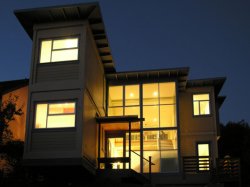 Shipping Containers: You can find a wide range of shipping container home/office/emergency shelter/low-cost housing examples on the Internet, but few reach the elegance shown by this example. Leger Wanaselja Architecture finished this totally green container house last year, bringing a more traditional look to the residence that’s located on top of a hill in an East Bay suburb overlooking San Francisco, California. This house defies the usual super-industrial aesthetic often found in this type of construction. The 1350 square foot, three bedroom house incorporates three forty-foot re-purposed refrigerated shipping containers, which provides instant exterior siding, insulation, and a built-in structural frame. The containers were stacked two stacked on one another, and the third cut in half and stacked on itself. The cost for this type of dwelling would depend on the price of the shipping container and other goods needed to complete the construction. You have two options: find a company that specializes in building homes from shipping containers, or build it yourself. As a rule of thumb – according to the Shipping Container Housing Guide – you may expect a price of $1,500 to $2,000 USD for a new standard 40-foot container without any modifications, and with transport and handling included.
Shipping Containers: You can find a wide range of shipping container home/office/emergency shelter/low-cost housing examples on the Internet, but few reach the elegance shown by this example. Leger Wanaselja Architecture finished this totally green container house last year, bringing a more traditional look to the residence that’s located on top of a hill in an East Bay suburb overlooking San Francisco, California. This house defies the usual super-industrial aesthetic often found in this type of construction. The 1350 square foot, three bedroom house incorporates three forty-foot re-purposed refrigerated shipping containers, which provides instant exterior siding, insulation, and a built-in structural frame. The containers were stacked two stacked on one another, and the third cut in half and stacked on itself. The cost for this type of dwelling would depend on the price of the shipping container and other goods needed to complete the construction. You have two options: find a company that specializes in building homes from shipping containers, or build it yourself. As a rule of thumb – according to the Shipping Container Housing Guide – you may expect a price of $1,500 to $2,000 USD for a new standard 40-foot container without any modifications, and with transport and handling included.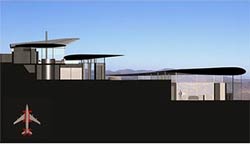 Plane Home: No, we don’t mean “plain” at all. This home, which is now under construction, is going to be built basically from parts salvaged from a Boeing 747. The jet’s wings will sit on thick concrete walls and the nose will point to the sky and serve as a meditation chamber. The first-class cabin will become an art studio and the signature bulge on top of the 747 will be a loft. Every part of this plane will be used to build the home and more than six outbuildings on a piece of southern California property. The architect, David Hertz of Santa Monica, found a decommissioned Boeing 747-200 through Aviation Warehouse for between $70,000 to $100,000 USD, so that hurdle was passed with flying colors. But, Francie Rehwald, the new home owner, spent $200,000 on consultants and plans to spend at least two million dollars to complete the full project. At least the owner knows that this new home will withstand winds at higher altitudes!
Plane Home: No, we don’t mean “plain” at all. This home, which is now under construction, is going to be built basically from parts salvaged from a Boeing 747. The jet’s wings will sit on thick concrete walls and the nose will point to the sky and serve as a meditation chamber. The first-class cabin will become an art studio and the signature bulge on top of the 747 will be a loft. Every part of this plane will be used to build the home and more than six outbuildings on a piece of southern California property. The architect, David Hertz of Santa Monica, found a decommissioned Boeing 747-200 through Aviation Warehouse for between $70,000 to $100,000 USD, so that hurdle was passed with flying colors. But, Francie Rehwald, the new home owner, spent $200,000 on consultants and plans to spend at least two million dollars to complete the full project. At least the owner knows that this new home will withstand winds at higher altitudes!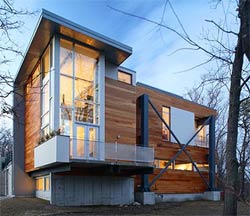 The Big Dig: Located in Boston, Massachusetts, this home was constructed of steel and concrete salvaged from Boston’s Big Dig, using over 600,000 lbs of materials. The Big Dig is the unofficial name of the Central Artery/Tunnel Project (CA/T), a megaproject that rerouted the Central Artery (Interstate 93), the chief highway through the heart of Boston, Massachusetts, into a 3.5 mile (5.6 km) tunnel under the city. The home was designed by Single Speed Design, and it won the AIA/BSA (Boston Society of Architects) Housing Design Award. Standing at over 4300 square feet, the structure represents a modern example of what is possible in sustainable building. Although similar to a pre-fab system, subtle spatial arrangements were designed from highway components. Most importantly, the house demonstrates an untapped potential for the public realm: “with strategic front-end planning, much needed community programs including schools, libraries, and housing could be constructed whenever infrastructure is deconstructed, saving valuable resources, embodied energy, and taxpayer dollars.” The cost is not mentioned, but if the components basically were free, then just cut the basic materials cost (unsure if plumbing was salvaged) from the price of a 4,300-square-foot home to get somewhat close to an estimate.
The Big Dig: Located in Boston, Massachusetts, this home was constructed of steel and concrete salvaged from Boston’s Big Dig, using over 600,000 lbs of materials. The Big Dig is the unofficial name of the Central Artery/Tunnel Project (CA/T), a megaproject that rerouted the Central Artery (Interstate 93), the chief highway through the heart of Boston, Massachusetts, into a 3.5 mile (5.6 km) tunnel under the city. The home was designed by Single Speed Design, and it won the AIA/BSA (Boston Society of Architects) Housing Design Award. Standing at over 4300 square feet, the structure represents a modern example of what is possible in sustainable building. Although similar to a pre-fab system, subtle spatial arrangements were designed from highway components. Most importantly, the house demonstrates an untapped potential for the public realm: “with strategic front-end planning, much needed community programs including schools, libraries, and housing could be constructed whenever infrastructure is deconstructed, saving valuable resources, embodied energy, and taxpayer dollars.” The cost is not mentioned, but if the components basically were free, then just cut the basic materials cost (unsure if plumbing was salvaged) from the price of a 4,300-square-foot home to get somewhat close to an estimate.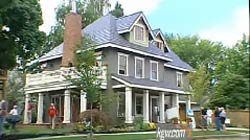 Re-Use Your Home: In 2007, Shannon Quimby and her husband discovered that they would need to demolish their Portland, Oregon home. Rather than use a bulldozer, the Quimbys created the REX project, or the “Reuse Everything eXperiment.” They meticulously tore their home apart, and saved their windows, doors, flooring and more to reconstruct their new home. Anytime they needed to replace an item, they made sure those materials were “green.” Although a cost isn’t mentioned, Quimby stated that she and her husband saved “thousands of dollars” in the construction of their new home. If you’re interested in building a new home from recycled building materials, you might want to become familiar with the Building Materials Reuse Association (BMRA). This non-profit organization aims to educate the public about how to reduce consumption of new resources, avoid landfill waste and pollution, create markets and increase cost-effectiveness, and expand job opportunities and workforce development skills as they educate individuals on the deconstruction and reuse of building materials.
Re-Use Your Home: In 2007, Shannon Quimby and her husband discovered that they would need to demolish their Portland, Oregon home. Rather than use a bulldozer, the Quimbys created the REX project, or the “Reuse Everything eXperiment.” They meticulously tore their home apart, and saved their windows, doors, flooring and more to reconstruct their new home. Anytime they needed to replace an item, they made sure those materials were “green.” Although a cost isn’t mentioned, Quimby stated that she and her husband saved “thousands of dollars” in the construction of their new home. If you’re interested in building a new home from recycled building materials, you might want to become familiar with the Building Materials Reuse Association (BMRA). This non-profit organization aims to educate the public about how to reduce consumption of new resources, avoid landfill waste and pollution, create markets and increase cost-effectiveness, and expand job opportunities and workforce development skills as they educate individuals on the deconstruction and reuse of building materials.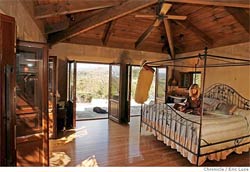 Recycled Rammed Earthworks Home: If you want to get back to the earth, you can use recycled materials, soil, cement and water to create a home like the one you see here. You might, however, want to seek the help of experts like David Easton, a leading innovator of forming and delivery technologies for the construction of rammed earth walls and the owner of Rammed Earth Works. This home is 3,136 square feet with two bedrooms, two and one-half baths and a study, but it’s a modest home despite the size. The home was built with “P.I.S.E.,” or “pneumatically impacted stabilized earth” that was borrowed from the property. A spray mix of that soil, cement and water is held in temporary boxes that, when removed, result in eighteen-in-thick walls that don’t require painting, finishing, or sheetrock. The blocks then are stacked to construct the home. Easton’s company can provide feasibility studies, soil evaluations and mix designs, pre-construction testing and consulting to contractors and owner builders. So, you can build the home yourself, saving costs on some construction if you want. Easton also will rent equipment for you to complete the project. If you want to explore other earth-soil projects, Rammed Earth Works can help you with that exploration as well.
Recycled Rammed Earthworks Home: If you want to get back to the earth, you can use recycled materials, soil, cement and water to create a home like the one you see here. You might, however, want to seek the help of experts like David Easton, a leading innovator of forming and delivery technologies for the construction of rammed earth walls and the owner of Rammed Earth Works. This home is 3,136 square feet with two bedrooms, two and one-half baths and a study, but it’s a modest home despite the size. The home was built with “P.I.S.E.,” or “pneumatically impacted stabilized earth” that was borrowed from the property. A spray mix of that soil, cement and water is held in temporary boxes that, when removed, result in eighteen-in-thick walls that don’t require painting, finishing, or sheetrock. The blocks then are stacked to construct the home. Easton’s company can provide feasibility studies, soil evaluations and mix designs, pre-construction testing and consulting to contractors and owner builders. So, you can build the home yourself, saving costs on some construction if you want. Easton also will rent equipment for you to complete the project. If you want to explore other earth-soil projects, Rammed Earth Works can help you with that exploration as well.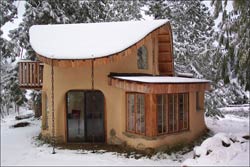 Cob Mud Hut: If your plans to live close to the earth are a bit more modest than the project shown previously, you can build a little mud hut with what is known as “cob” construction. Patrick Henneberry, owner of Cobworks in British Columbia, hosts workshops on how to build with a mixture of sand, clay, loose straw and water. These homes, according to Henneberry, can last for hundreds of years because the walls can “breathe and transmit moisture from cooking, washing, and breathing.” All the other materials used to build these homes are, ideally, recycled. This includes the lumber, flooring, doors and windows. Expect circular walls for a more natural feel, and great thermal mass – this means that the building will retain heat and radiate it into the house as the day cools down. The price of a house like this would probably be less than a rammed earth structure, simply because it takes less equipment to produce the home. Plus, it sounds like fun – more like a barn-raising than a solitary affair.
Cob Mud Hut: If your plans to live close to the earth are a bit more modest than the project shown previously, you can build a little mud hut with what is known as “cob” construction. Patrick Henneberry, owner of Cobworks in British Columbia, hosts workshops on how to build with a mixture of sand, clay, loose straw and water. These homes, according to Henneberry, can last for hundreds of years because the walls can “breathe and transmit moisture from cooking, washing, and breathing.” All the other materials used to build these homes are, ideally, recycled. This includes the lumber, flooring, doors and windows. Expect circular walls for a more natural feel, and great thermal mass – this means that the building will retain heat and radiate it into the house as the day cools down. The price of a house like this would probably be less than a rammed earth structure, simply because it takes less equipment to produce the home. Plus, it sounds like fun – more like a barn-raising than a solitary affair.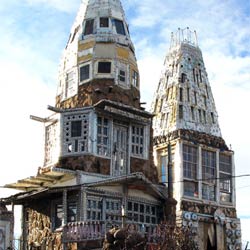 Mad Max Redux: Occasionally, on those weekend trips to admire fall colors or spring buds, you might run across a home that looks like something you’d see in a Mad Max movie. This is what happened to the owner of Mother Wit Writing and Design. On her return from a National Wildlife Refuge near Taos, New Mexico, she saw a “shimmering structure that looked like a church but there was something odd and not quite symmetrical about it, even from a distance of three or four blocks.” As she drove closer, she discovered that this object was a home constructed from recycled boards, windows, rocks, bits of glass, pieces of metal and many aluminum cans. Whether the owner built the house from scratch or used the materials to patch an already existing home is unknown. But, you may admit that this is an original use of recycled materials, and the cost may have been only the time consumed in construction. Before you attempt a project like this, it might behoove you to check your local building codes. No sense in spending time (if not money) if you can’t comply with local laws.
Mad Max Redux: Occasionally, on those weekend trips to admire fall colors or spring buds, you might run across a home that looks like something you’d see in a Mad Max movie. This is what happened to the owner of Mother Wit Writing and Design. On her return from a National Wildlife Refuge near Taos, New Mexico, she saw a “shimmering structure that looked like a church but there was something odd and not quite symmetrical about it, even from a distance of three or four blocks.” As she drove closer, she discovered that this object was a home constructed from recycled boards, windows, rocks, bits of glass, pieces of metal and many aluminum cans. Whether the owner built the house from scratch or used the materials to patch an already existing home is unknown. But, you may admit that this is an original use of recycled materials, and the cost may have been only the time consumed in construction. Before you attempt a project like this, it might behoove you to check your local building codes. No sense in spending time (if not money) if you can’t comply with local laws. Water Bottle Home: You may know that there’s a movement against plastic water bottles, as Americans consume about 70 million bottles each day, and the problem isn’t any less in Europe. Those bottles usually end up in landfills, but Tomislav Radovanovic, from the central town of Kragujevac, Serbia, figured out how he could put a dent in the landfill problem by constructing his retirement home from those empty plastic bottles. Note the colorful patterns in the house, a execution that was carefully planned. Radovanovic told the national news agency, Tanjug, that he hopes to enter the Guinness Book of Records and has already sent them an application. The home’s foundation is concrete, but the rest of the house was constructed from plastic bottles. This practice isn’t new, as homes have been built from bottles before; however, most of those homes used glass bottles. The price of this home would be minimal, as plastic bottles are yours for the taking from any garbage can. All you need is a foundation and recycled materials for doors and windows. If you’re truly resourceful, you can make a plastic-bottle floor as well.
Water Bottle Home: You may know that there’s a movement against plastic water bottles, as Americans consume about 70 million bottles each day, and the problem isn’t any less in Europe. Those bottles usually end up in landfills, but Tomislav Radovanovic, from the central town of Kragujevac, Serbia, figured out how he could put a dent in the landfill problem by constructing his retirement home from those empty plastic bottles. Note the colorful patterns in the house, a execution that was carefully planned. Radovanovic told the national news agency, Tanjug, that he hopes to enter the Guinness Book of Records and has already sent them an application. The home’s foundation is concrete, but the rest of the house was constructed from plastic bottles. This practice isn’t new, as homes have been built from bottles before; however, most of those homes used glass bottles. The price of this home would be minimal, as plastic bottles are yours for the taking from any garbage can. All you need is a foundation and recycled materials for doors and windows. If you’re truly resourceful, you can make a plastic-bottle floor as well. Salvaged Car Ferry: What if you’re not a land-lubber, but you don’t know how to build a boat? The next best thing, perhaps, is to find an abandoned car ferry, hire a top-notch designer like Olle Lundberg, and build a floating home that would rival most modest castles. Lundberg took this advice, but he hired himself when he found a decommissioned Icelandic car ferry docked at Pier 54 in the Mission Bay neighborhood of San Francisco, California. Lundberg found the ferry for $260,000 through shiprepo.com, and he spent $600,000 repainting the exterior, rebuilding the engine, converting the electrical system to United States standards and other alterations required to make the ship habitable. He and his wife also pay $1,500 a month in docking fees. But, with two stories and a dining room table built from an eighteen-foot-long slab of cypress left over from the Slanted Door, a popular Vietnamese restaurant Mr. Lundberg designed in the newly restored Ferry Building, what more could you ask for? Maybe another residence built from recycled goods (or, trash)? Well, Lundberg does that as well, as his second home, located two hours north from the docked ferry, was built entirely from materials salvaged from houses and offices that Mr. Lundbergs firm, Lundberg Design, built or remodeled.
Salvaged Car Ferry: What if you’re not a land-lubber, but you don’t know how to build a boat? The next best thing, perhaps, is to find an abandoned car ferry, hire a top-notch designer like Olle Lundberg, and build a floating home that would rival most modest castles. Lundberg took this advice, but he hired himself when he found a decommissioned Icelandic car ferry docked at Pier 54 in the Mission Bay neighborhood of San Francisco, California. Lundberg found the ferry for $260,000 through shiprepo.com, and he spent $600,000 repainting the exterior, rebuilding the engine, converting the electrical system to United States standards and other alterations required to make the ship habitable. He and his wife also pay $1,500 a month in docking fees. But, with two stories and a dining room table built from an eighteen-foot-long slab of cypress left over from the Slanted Door, a popular Vietnamese restaurant Mr. Lundberg designed in the newly restored Ferry Building, what more could you ask for? Maybe another residence built from recycled goods (or, trash)? Well, Lundberg does that as well, as his second home, located two hours north from the docked ferry, was built entirely from materials salvaged from houses and offices that Mr. Lundbergs firm, Lundberg Design, built or remodeled.
The 10 Oldest Neighborhoods in the World: Live in a 2300 Year Old House
Posted in Features on September 16, 2008Do you long for bygone days? Or, do you have a history or archeology streak hidden within your soul? Unfortunately, unless you like living in a cave (which is entirely possible), many residences haven’t lasted for more than 200 years, let alone for over two centuries. But, some neighborhoods have been around for a few millennium, and antiquity lovers can find a real estate investment in or near some of the oldest settlements discovered to date.
While some might dispute whether one region of the world holds older artifacts than others, the point to this list is to offer neighborhoods, cities and even entire regions that have been occupied continuously since their inception. Therefore, while the western U.S. might offer up the oldest human remains in the U.S. at 14,000-years-old, those nomadic cave-dwellers didn’t settle down in what is now known as the state of Oregon. Hence, Oregon didn’t make the list. (Neither did San Antonio.) Plus, while Rome may be older than Malacca, Malaysia, we wanted to offer a bit of worldwide variety for your reading pleasure. So, we included Malacca and avoided Rome and included the U.S. although this country is, by all worldly standards, architecturally young.
Just because a settlement is ancient, old homes in that area may not be available. In this case, we offer suitable alternatives. Available homes are new properties sited on old grounds, renovations, or properties located safely outside a politically volatile area or located as close as possible to uninhabitable ruins. Finally, although this list is numbered, this does not mean that we value one ancient habitat over another. We did, however, try to place the areas by age, with the oldest community listed first.
 Olomouc, Czech Republic: In 2005, scientists confirmed that bones found in the Czech Republic represent the earliest human settlement in Europe, dating back about 30,000 years. This area already is known for the Mladec Cave paintings, and it’s easy to travel to the site from Olomouc, a city located just thirteen miles south. Olomouc is rumored to occupy a Roman fort site founded in the imperial period. Although a legend, archaeological excavations revealed remains of a Roman military camp from the time of Marcoman Wars close to the city. The ancient town of Olomouc ranks as the second most important and largest urban conservation area in the Czech Republic behind Prague; therefore, any home you may find in this area could hide historical artifacts beneath its foundation. You can view some Olomouc residential real estate, which currently ranges from Kc200,000 ($12,153.62 USD) to Kc62,867,345 ($3,820,330.35 USD).
Olomouc, Czech Republic: In 2005, scientists confirmed that bones found in the Czech Republic represent the earliest human settlement in Europe, dating back about 30,000 years. This area already is known for the Mladec Cave paintings, and it’s easy to travel to the site from Olomouc, a city located just thirteen miles south. Olomouc is rumored to occupy a Roman fort site founded in the imperial period. Although a legend, archaeological excavations revealed remains of a Roman military camp from the time of Marcoman Wars close to the city. The ancient town of Olomouc ranks as the second most important and largest urban conservation area in the Czech Republic behind Prague; therefore, any home you may find in this area could hide historical artifacts beneath its foundation. You can view some Olomouc residential real estate, which currently ranges from Kc200,000 ($12,153.62 USD) to Kc62,867,345 ($3,820,330.35 USD).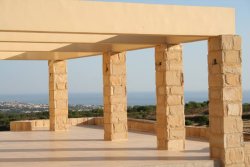 Paphos, Cyprus: Jericho, Palestine represents the world’s oldest known settlement, with significant archaeological remains dating back as far as 8000 BCE; but, like most risky investments, the atmosphere in the Middle East currently may prove too volatile for many real estate investors. Instead, you might look to the southwestern region of Cyprus as a possibility, a semi-peaceful area that would allow you to visit ruins from ancient Greece to Egypt (Turkey illegally occupies the northeastern section of this island). Cyprus alone offers artifacts that date back over 9,000 years, and the area of Paphos offers more than just beautiful sea views. This entire area was a Roman capital that dates from 1400 BCE. Plus, legend has it that the city is built on the spot where the Greek Goddess of Love, Aphrodite, was born. Enjoy everything that love and money can bring with this four-bed, four-bath executive suite with panoramic views, A/C, touch pad controls, underfloor heating, large pool, electric gates and designer kitchen for 1,550,000 Euro ($2,290,682.56 USD).
Paphos, Cyprus: Jericho, Palestine represents the world’s oldest known settlement, with significant archaeological remains dating back as far as 8000 BCE; but, like most risky investments, the atmosphere in the Middle East currently may prove too volatile for many real estate investors. Instead, you might look to the southwestern region of Cyprus as a possibility, a semi-peaceful area that would allow you to visit ruins from ancient Greece to Egypt (Turkey illegally occupies the northeastern section of this island). Cyprus alone offers artifacts that date back over 9,000 years, and the area of Paphos offers more than just beautiful sea views. This entire area was a Roman capital that dates from 1400 BCE. Plus, legend has it that the city is built on the spot where the Greek Goddess of Love, Aphrodite, was born. Enjoy everything that love and money can bring with this four-bed, four-bath executive suite with panoramic views, A/C, touch pad controls, underfloor heating, large pool, electric gates and designer kitchen for 1,550,000 Euro ($2,290,682.56 USD). Cadiz, Spain: Historians have long known that Phoenician traders founded Cadiz more than 3,000 years ago. Now, archaeologists believe they have found evidence that this city may be over 9,000 years old, which means that Cadiz could be Europe’s oldest inhabited city – the original Phoenician Gadir (meaning “the fortress”), or Gades in Roman times. The oldest artifacts were found sixteen miles southeast from Cadiz in 2007, but this Spanish city is surrounded by a sense of the centuries for miles. For instance, you can find a 200-year-old villa for sale just forty-six miles east of Cadiz in El Gastor. This villa, shown here, has undergone extensive renovation, yet the owners retained many of the original features. You’ll find beautiful old wooden beams in the bedroom and the bathroom, a wood burning stove and a large hallway upstairs with a seating area and French doors leading onto a small balcony. How much for a bit of history? A mere 129,000 Euros, or $190,894.76 USD.
Cadiz, Spain: Historians have long known that Phoenician traders founded Cadiz more than 3,000 years ago. Now, archaeologists believe they have found evidence that this city may be over 9,000 years old, which means that Cadiz could be Europe’s oldest inhabited city – the original Phoenician Gadir (meaning “the fortress”), or Gades in Roman times. The oldest artifacts were found sixteen miles southeast from Cadiz in 2007, but this Spanish city is surrounded by a sense of the centuries for miles. For instance, you can find a 200-year-old villa for sale just forty-six miles east of Cadiz in El Gastor. This villa, shown here, has undergone extensive renovation, yet the owners retained many of the original features. You’ll find beautiful old wooden beams in the bedroom and the bathroom, a wood burning stove and a large hallway upstairs with a seating area and French doors leading onto a small balcony. How much for a bit of history? A mere 129,000 Euros, or $190,894.76 USD.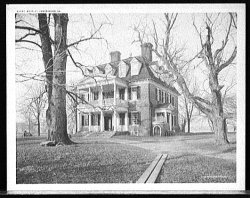 Along the James River, Virginia: Claims to the ‘oldest settlement’ title in the U.S. are rife with debate, and this contention would seem laughable when compared to the Middle East – except for evidence of Native American settlements. While it’s well known that St. Augustine, Florida claims to be the oldest settlement in the United States (Spain, 1513, evidence of Native American farming since 500 BCE) and the Oraibi Hopi Reservation in Arizona claims the oldest continuously inhabited settlement within the U.S. from 1100 CE, few historians have recognized the voices of the Monacan tribe. The Monacans lived in villages with palisaded walls, and their homes were dome-shaped structures of bark and reed mats. They would leave their villages every year to visit their hunting camps, they mined copper and buried their dead in mounds, which reveal 10,000-year-old artifacts. When the English arrived in Virginia, they pushed the Monacans west along the James until they were almost extinct. But, their descendants are here today, and the Monacan museum, located in Amherst, Virginia, provides testament to their survival. It is along the James that you’ll find Jamestown and Kecoughtan (now known as Hampton, the oldest continually occupied English settlement in the U.S.). This is where you’ll also find Shirley Plantation, which was built in 1613 (pictured here from a print c. 1900). This is the oldest plantation in Virginia and the oldest family-owned business in North America, dating back to 1638. The history lover can begin in Hampton, near Newport News on the Chesapeake, and work his way to Iron Gate along the James to find homes that easily meet the century-old mark and that have not been designated as historical relics. Some homes even survived the Civil War. But, the oldest homes, perhaps, can be found just west of Richmond, where the Huguenots (French Protestant refugees) settled on an abandoned Monacan Indian village in 1700. Occasionally, one of these early eighteenth-century homes will go for sale in Powhatan County. Prices for the average home in this county usually top at $600,000 USD.
Along the James River, Virginia: Claims to the ‘oldest settlement’ title in the U.S. are rife with debate, and this contention would seem laughable when compared to the Middle East – except for evidence of Native American settlements. While it’s well known that St. Augustine, Florida claims to be the oldest settlement in the United States (Spain, 1513, evidence of Native American farming since 500 BCE) and the Oraibi Hopi Reservation in Arizona claims the oldest continuously inhabited settlement within the U.S. from 1100 CE, few historians have recognized the voices of the Monacan tribe. The Monacans lived in villages with palisaded walls, and their homes were dome-shaped structures of bark and reed mats. They would leave their villages every year to visit their hunting camps, they mined copper and buried their dead in mounds, which reveal 10,000-year-old artifacts. When the English arrived in Virginia, they pushed the Monacans west along the James until they were almost extinct. But, their descendants are here today, and the Monacan museum, located in Amherst, Virginia, provides testament to their survival. It is along the James that you’ll find Jamestown and Kecoughtan (now known as Hampton, the oldest continually occupied English settlement in the U.S.). This is where you’ll also find Shirley Plantation, which was built in 1613 (pictured here from a print c. 1900). This is the oldest plantation in Virginia and the oldest family-owned business in North America, dating back to 1638. The history lover can begin in Hampton, near Newport News on the Chesapeake, and work his way to Iron Gate along the James to find homes that easily meet the century-old mark and that have not been designated as historical relics. Some homes even survived the Civil War. But, the oldest homes, perhaps, can be found just west of Richmond, where the Huguenots (French Protestant refugees) settled on an abandoned Monacan Indian village in 1700. Occasionally, one of these early eighteenth-century homes will go for sale in Powhatan County. Prices for the average home in this county usually top at $600,000 USD.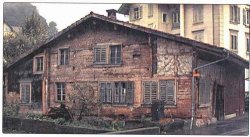 Schwyz, Switzerland: If you want to know what a timber house looks like after 800 years, take a look at the oldest timber building in Europe, the Niderost house in Schwyz, Switzerland. This house has been dismantled and is in storage, as the Swiss goverment wants to restore it to its original glory. But, visitors to this area can view another house of the same style from the same period, as the Bethlehem house – located on the Ital-Reding Estate – is open for tours. Schwyz is one of the founding cantons of Switzerland, but findings show that Schwyz has been settled for thousands of years. Artifacts that date 5,000 years have been discovered in the northern region of Schwyz in the Hurden and Freienbach areas on Lake Zurich. Individuals who wish to live in something other than a timber building in this region can find ultra-modern digs (price on request) that may, literally, sit on a future archaeological dig.
Schwyz, Switzerland: If you want to know what a timber house looks like after 800 years, take a look at the oldest timber building in Europe, the Niderost house in Schwyz, Switzerland. This house has been dismantled and is in storage, as the Swiss goverment wants to restore it to its original glory. But, visitors to this area can view another house of the same style from the same period, as the Bethlehem house – located on the Ital-Reding Estate – is open for tours. Schwyz is one of the founding cantons of Switzerland, but findings show that Schwyz has been settled for thousands of years. Artifacts that date 5,000 years have been discovered in the northern region of Schwyz in the Hurden and Freienbach areas on Lake Zurich. Individuals who wish to live in something other than a timber building in this region can find ultra-modern digs (price on request) that may, literally, sit on a future archaeological dig. Ticul, Yucatan, Mexico: Four-foot tall rust-colored clay pots and leather shoes mark the two major industries in this 3,500-year-old Mexican settlement, located approximately sixty miles south of Yucatan’s capital city, Merida. Originally settled by pre-Columbian Mayans, Ticul has represented North America’s oldest known settlement. After the Spanish conquest of Yucatan, Ticul was established as a Spanish colonial town in 1549. Ticul achieved the status of a city in 1847. Over half the population still speaks the Maya language as their first tongue, although Spanish is also understood. In this city, you will see the old – the Cathedral (shown here), colonial buildings, thatched roof Mayan homes – and some new – the open-air stage, hotels, restaurants, a market, a telegraph office, banks, pharmacies, medical assistance, Internet e-mail services, and tricycle taxis for hire. For individuals who seek tranquil living among ancient surroundings, yet who want to live near large-city offerings, Ticul could be the ticket. Or, if you prefer to live in the general area of Mayan ruins within four miles from Ticul, you might consider this abandoned hacienda. This property holds an existing wind-powered water pump, irrigation tanks, bebederos, corrals for horses and a cave with 1,00-year-old stalactites. While the buildings are in need of major repair, you can purchase the total package, including 907 acres, for a mere $550,000 USD.
Ticul, Yucatan, Mexico: Four-foot tall rust-colored clay pots and leather shoes mark the two major industries in this 3,500-year-old Mexican settlement, located approximately sixty miles south of Yucatan’s capital city, Merida. Originally settled by pre-Columbian Mayans, Ticul has represented North America’s oldest known settlement. After the Spanish conquest of Yucatan, Ticul was established as a Spanish colonial town in 1549. Ticul achieved the status of a city in 1847. Over half the population still speaks the Maya language as their first tongue, although Spanish is also understood. In this city, you will see the old – the Cathedral (shown here), colonial buildings, thatched roof Mayan homes – and some new – the open-air stage, hotels, restaurants, a market, a telegraph office, banks, pharmacies, medical assistance, Internet e-mail services, and tricycle taxis for hire. For individuals who seek tranquil living among ancient surroundings, yet who want to live near large-city offerings, Ticul could be the ticket. Or, if you prefer to live in the general area of Mayan ruins within four miles from Ticul, you might consider this abandoned hacienda. This property holds an existing wind-powered water pump, irrigation tanks, bebederos, corrals for horses and a cave with 1,00-year-old stalactites. While the buildings are in need of major repair, you can purchase the total package, including 907 acres, for a mere $550,000 USD.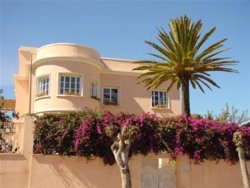 Asmara, Eritrea, Africa: Up until 2002, historians presumed that Eritrea’s capital city, Asmara, was 700 years old. But, scientists recently discovered an entire city under the outskirts of Asmara that dates back 3,000 years. This discovery would make Asmara the oldest settled agricultural community in Africa. The irony to this discovery is that Asmara’s architectural face was revamped during the twentieth century, as Italy (which occupied Asmara in 1889) rebuilt this capital city in the 1930s. The Italians used the city to experiment with new and radical designs, basically placing Asmara in the same light as today’s ultramodern Dubai. Growth continues in this area located south of Egypt and across the Red Sea from Yemen. New condo developments already have disrupted archaeological studies of Asmara’s ancient ruins. But, this growth allows residents to become part of African history in more ways than one. The lovely home shown here is a prime example of Asmara real estate, thoroughly modern “price upon request” living on the edge of priceless antiquity.
Asmara, Eritrea, Africa: Up until 2002, historians presumed that Eritrea’s capital city, Asmara, was 700 years old. But, scientists recently discovered an entire city under the outskirts of Asmara that dates back 3,000 years. This discovery would make Asmara the oldest settled agricultural community in Africa. The irony to this discovery is that Asmara’s architectural face was revamped during the twentieth century, as Italy (which occupied Asmara in 1889) rebuilt this capital city in the 1930s. The Italians used the city to experiment with new and radical designs, basically placing Asmara in the same light as today’s ultramodern Dubai. Growth continues in this area located south of Egypt and across the Red Sea from Yemen. New condo developments already have disrupted archaeological studies of Asmara’s ancient ruins. But, this growth allows residents to become part of African history in more ways than one. The lovely home shown here is a prime example of Asmara real estate, thoroughly modern “price upon request” living on the edge of priceless antiquity. Lamphun, Thailand: If you’re familiar with the saying, “older than dirt,” then you might want to consider purchasing vacant land in what is considered Thailand’s oldest city. The historic Asian town of Lamphun, if not the oldest city in Thailand, certainly is a contender for “longest continually inhabited settlement” in this country. The ancient fortified city was founded, according to legend, in 660 CE, almost six centuries before the nearby city of Chiang Mai and more than 1,000 years before the Thai capital was moved to Bangkok in 1782. Little remains of Lamphun’s ancient city walls, though the heart of the Old City is still surrounded to the north, west and south by well-preserved and tranquil lotus-filled moats. Surrounded by magnificent gum trees (shown in the photo here of the Lamphun – Chiang Mai road) and ancient Buddhist temples, Lamphun offers an ancient small-town feel yet offers the amenities provided by a nearby larger city. While beautiful homes can be had in and around Lamphun, the availability of unoccupied land for sale could provide the real draw for this ancient area. Investment in this particular piece of vacant land, located in Lamphun’s northern industrial district, runs at 25,000,000 Baht, or about $734,365.36 USD.
Lamphun, Thailand: If you’re familiar with the saying, “older than dirt,” then you might want to consider purchasing vacant land in what is considered Thailand’s oldest city. The historic Asian town of Lamphun, if not the oldest city in Thailand, certainly is a contender for “longest continually inhabited settlement” in this country. The ancient fortified city was founded, according to legend, in 660 CE, almost six centuries before the nearby city of Chiang Mai and more than 1,000 years before the Thai capital was moved to Bangkok in 1782. Little remains of Lamphun’s ancient city walls, though the heart of the Old City is still surrounded to the north, west and south by well-preserved and tranquil lotus-filled moats. Surrounded by magnificent gum trees (shown in the photo here of the Lamphun – Chiang Mai road) and ancient Buddhist temples, Lamphun offers an ancient small-town feel yet offers the amenities provided by a nearby larger city. While beautiful homes can be had in and around Lamphun, the availability of unoccupied land for sale could provide the real draw for this ancient area. Investment in this particular piece of vacant land, located in Lamphun’s northern industrial district, runs at 25,000,000 Baht, or about $734,365.36 USD.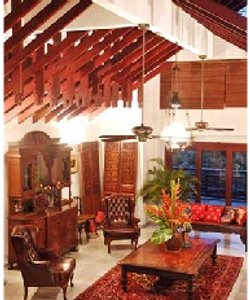 Malacca, Malaysia: Located just south of Kuala Lumpur, the historically rich state of Malacca was founded by Parameswara, an exiled prince from Sumatra, in 1396. Strategically located on the ancient Asian spice route that linked China to India and the Far East, Malacca (also known as “Maleka”) provided sailors with a fiendly and open port as they passed by. Eventually, Malacca grew into a thriving trading center, but its independence was cut short by Portuguese colonization in the early sixteenth century. The Dutch then took control in 1641 and then the British in 1824. Although Malaysia declared independence in 1956, English, Dutch and Portuguese styles continue to strongly influenced the town’s architecture. Because the city originally was built from wood, there are no reminders of the power once wielded by the Malaccan Sultanate; however, along the shores of the Malacca River, the scene has probably changed little. Look especially for the Portuguese influence, as this country taxed housing by width. This policy accounts for a building that can be no more than twelve feet across but that can easily extend backwards two hundred feet, hiding an interior filled with a linear succession of high-ceilinged rooms and courtyards. One such replica of this type of architecture – on a lavish basis – is the bungalow shown here, designed with intricate geometry of roof planes and flooring (inquire for price).
Malacca, Malaysia: Located just south of Kuala Lumpur, the historically rich state of Malacca was founded by Parameswara, an exiled prince from Sumatra, in 1396. Strategically located on the ancient Asian spice route that linked China to India and the Far East, Malacca (also known as “Maleka”) provided sailors with a fiendly and open port as they passed by. Eventually, Malacca grew into a thriving trading center, but its independence was cut short by Portuguese colonization in the early sixteenth century. The Dutch then took control in 1641 and then the British in 1824. Although Malaysia declared independence in 1956, English, Dutch and Portuguese styles continue to strongly influenced the town’s architecture. Because the city originally was built from wood, there are no reminders of the power once wielded by the Malaccan Sultanate; however, along the shores of the Malacca River, the scene has probably changed little. Look especially for the Portuguese influence, as this country taxed housing by width. This policy accounts for a building that can be no more than twelve feet across but that can easily extend backwards two hundred feet, hiding an interior filled with a linear succession of high-ceilinged rooms and courtyards. One such replica of this type of architecture – on a lavish basis – is the bungalow shown here, designed with intricate geometry of roof planes and flooring (inquire for price).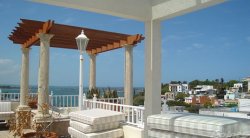 Old San Juan, Puerto Rico: If you’re a history lover, there’s no reason to live in San Juan unless you can live in the oldest part of this Puerto Rican island. This island was inhabited by Taino Indians until Columbus stumbled onto this island’s beaches in 1493 and named it San Juan. Unfortunately, no one knows just how long the Taino tribe lived here (or on any other Caribbean island), so there’s no way to know how long this island has been continuously occupied. Spain colonized the island in 1508 and moved the capital near the ocean, which makes this city the second oldest Spanish colonial city in the “old” New World outside Santo Domingo in the Dominican Republic. Spain ceded the island to the U.S. in 1898. Old San Juan provides an excellent example of Spanish colonial architecture, most of which has been beautifully restored. For example, this Old San Juan sweetie was built in 1808 and remodeled with new amenities. You’ll find four bedrooms, three baths and 4,119 square feet of space in three-story luxury living for just $2,950,000 USD.
Old San Juan, Puerto Rico: If you’re a history lover, there’s no reason to live in San Juan unless you can live in the oldest part of this Puerto Rican island. This island was inhabited by Taino Indians until Columbus stumbled onto this island’s beaches in 1493 and named it San Juan. Unfortunately, no one knows just how long the Taino tribe lived here (or on any other Caribbean island), so there’s no way to know how long this island has been continuously occupied. Spain colonized the island in 1508 and moved the capital near the ocean, which makes this city the second oldest Spanish colonial city in the “old” New World outside Santo Domingo in the Dominican Republic. Spain ceded the island to the U.S. in 1898. Old San Juan provides an excellent example of Spanish colonial architecture, most of which has been beautifully restored. For example, this Old San Juan sweetie was built in 1808 and remodeled with new amenities. You’ll find four bedrooms, three baths and 4,119 square feet of space in three-story luxury living for just $2,950,000 USD.
10 Astonishing Treehouses You’d Love to Live In
Posted in Features on September 10, 2008Did you forever want to live in a tree house when you were younger? What better way to sleep than directly under the branches of a protective tree among the stars? And, while some tree houses are minimalist by their very small nature, today’s tree house architects have gone beyond small stature to include tree houses fit for hotel rooms, lodges and restaurants. Other tree houses, although small in scale, have risen to the ‘green’ challenge to become ideal tree homes that do little to no damage to its host tree.
Tree house fans, no matter how experienced (or not), can find hands-on information at the annual World Treehouse Association Conference. Michael Garnier, the owner of Out “N” About Treehouse Resort, holds this event every Columbus Day weekend. This conference typically attracts 40 to 60 people, ranging from builders like Mr. Garnier to novices itching to build their own houses among the stars. No matter if you want to purchase an existing tree house or build one for yourself, the value of learning from experts is priceless.
In the meantime, you can peruse the following list, which contains tree houses that are for sale, or tree houses that can be purchased as a mass-produced item or – simply – tree houses that you’d love to live in. Although this list is numbered, this does not mean that we value one tree house over another.
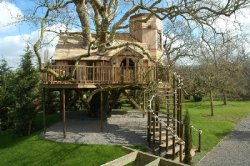 The Manor: Andy Payne, director of BlueForest TreeHouses, is obsessed with building some of the most innovative and dynamic tree houses for his clients. He and his crew build tree houses that range from children’s fantasy playhouses to treetop lodges, hotels and restaurants. They have built their creations all over Europe from Greece to Italy and France, and Andy’s staff is fluent in French, German and Spanish. The image shown here is called, “The Manor,” a luxury tree house at its most sumptuous. The price tags for these crafted beauties range from £20,000 upward.
The Manor: Andy Payne, director of BlueForest TreeHouses, is obsessed with building some of the most innovative and dynamic tree houses for his clients. He and his crew build tree houses that range from children’s fantasy playhouses to treetop lodges, hotels and restaurants. They have built their creations all over Europe from Greece to Italy and France, and Andy’s staff is fluent in French, German and Spanish. The image shown here is called, “The Manor,” a luxury tree house at its most sumptuous. The price tags for these crafted beauties range from £20,000 upward.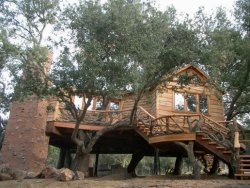 Retirement Home: This retirement home was built in a live oak grove by the team at Treehouse Workshops. It is their largest project to date. This home contains 1,000 square feet and features a full bath, kitchen, running water and a washer/dryer. The railings and siding all were milled on site using felled standing dead oak. Everything in this home was lovingly hand built, including the windows and the stone fireplace. All total, this home took nine months to build. Treehouse Workshop homes usually range in price from $60,000 to “the sky’s the limit.”
Retirement Home: This retirement home was built in a live oak grove by the team at Treehouse Workshops. It is their largest project to date. This home contains 1,000 square feet and features a full bath, kitchen, running water and a washer/dryer. The railings and siding all were milled on site using felled standing dead oak. Everything in this home was lovingly hand built, including the windows and the stone fireplace. All total, this home took nine months to build. Treehouse Workshop homes usually range in price from $60,000 to “the sky’s the limit.”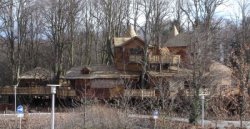 Alnwick Treehouse, UK: The refurbished Alnwick Gardens in the UK features this impressive structure, opened to the public in early 2005. The client, the Duchess of Northumberland, wanted to build an archetypal tree house out of a fairy tale, with an organic feel that would blend in with the trees and landscape. Everything had to conform to building regulations, fire codes and the Disability Discrimination Act. The house consists of a large restaurant with an open fire, meeting space and smaller outbuildings. Wheelchair accessible, the building also an expansive deck and a rope bridge loop behind the house. The building is held up with a combination of a huge network of wooden braces, concrete foundations and two concrete towers hidden within the design. This tree house was designed by Napper Architects and the concept drawings initially were produced by The Treehouse Company. The actual build was carried out by Sir Robert McAlpine Limited at a value of £3.2 million.
Alnwick Treehouse, UK: The refurbished Alnwick Gardens in the UK features this impressive structure, opened to the public in early 2005. The client, the Duchess of Northumberland, wanted to build an archetypal tree house out of a fairy tale, with an organic feel that would blend in with the trees and landscape. Everything had to conform to building regulations, fire codes and the Disability Discrimination Act. The house consists of a large restaurant with an open fire, meeting space and smaller outbuildings. Wheelchair accessible, the building also an expansive deck and a rope bridge loop behind the house. The building is held up with a combination of a huge network of wooden braces, concrete foundations and two concrete towers hidden within the design. This tree house was designed by Napper Architects and the concept drawings initially were produced by The Treehouse Company. The actual build was carried out by Sir Robert McAlpine Limited at a value of £3.2 million.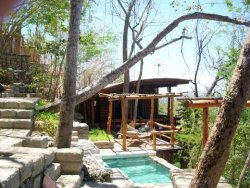 San Juan del Sur Tree House: At some point in your life, you might need to ask yourself whether you want to spend $299,000 on a home in Ohio or on a tree house on the beach in Nicaragua. Think about it – after you spend a day on your Pacific Ocean beach, you climb up for a refreshing dip on your pool and then relax in your hammock as you stare at your new home, which is supported by massive eucalyptus trees with a high curved ceiling that allows for natural air circulation. This home, therefore, contains a passive cooling system and includes solar heat as well. This home contains three decks, and one is completely covered. The parking area above the house is completely fenced with teak logs for privacy, and home itself is built of sustainable woods that blend beautifully into its surroundings. Designed by Matthew Falkiner, this 1900-square-foot home is built within a nature preserve only a few minutes’ drive down the hill to the beach. The house contains two bedrooms, two baths, huge 10×10 screened windows with an ocean view. All amenities are included, so you won’t be roughing it at all. In fact, you’ll only be twenty minutes from San Juan del Sur, a Nicaraguan resort community.
San Juan del Sur Tree House: At some point in your life, you might need to ask yourself whether you want to spend $299,000 on a home in Ohio or on a tree house on the beach in Nicaragua. Think about it – after you spend a day on your Pacific Ocean beach, you climb up for a refreshing dip on your pool and then relax in your hammock as you stare at your new home, which is supported by massive eucalyptus trees with a high curved ceiling that allows for natural air circulation. This home, therefore, contains a passive cooling system and includes solar heat as well. This home contains three decks, and one is completely covered. The parking area above the house is completely fenced with teak logs for privacy, and home itself is built of sustainable woods that blend beautifully into its surroundings. Designed by Matthew Falkiner, this 1900-square-foot home is built within a nature preserve only a few minutes’ drive down the hill to the beach. The house contains two bedrooms, two baths, huge 10×10 screened windows with an ocean view. All amenities are included, so you won’t be roughing it at all. In fact, you’ll only be twenty minutes from San Juan del Sur, a Nicaraguan resort community.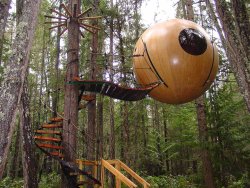 Ewok Tree House: Tom Chudleigh made a name for himself a few years ago with his Free Spirit Spheres, Ewok-like structures that are suspended from trees. Originally designed as a spherical boat, these tree houses are built with wood and a fiberglass covering that offers waterproof exterior. The interior of the house features a working kitchen with accessories including microwave, refrigerator and sink, and can be tailored by including beds and bronze doors. While you now can purchase these spheres for $152,000 fully decked out, the budget-minded tree house fanatic can purchase other options from Chudleigh through his Web site. These choices range from the basic framework kit to the fiberglass-covered shell to all the add-ons including acrylic windows. If you don’t think you can hang your finished product, Chudleigh offers to hang or take down your house for a fee. Other services include assessment of groves and sites and custom designs.
Ewok Tree House: Tom Chudleigh made a name for himself a few years ago with his Free Spirit Spheres, Ewok-like structures that are suspended from trees. Originally designed as a spherical boat, these tree houses are built with wood and a fiberglass covering that offers waterproof exterior. The interior of the house features a working kitchen with accessories including microwave, refrigerator and sink, and can be tailored by including beds and bronze doors. While you now can purchase these spheres for $152,000 fully decked out, the budget-minded tree house fanatic can purchase other options from Chudleigh through his Web site. These choices range from the basic framework kit to the fiberglass-covered shell to all the add-ons including acrylic windows. If you don’t think you can hang your finished product, Chudleigh offers to hang or take down your house for a fee. Other services include assessment of groves and sites and custom designs.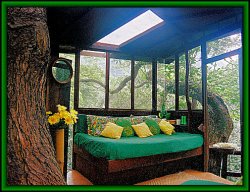 Waipio Valley Treehouse: If you know how difficult it is to gain a lease on property in Hawaii, or if you understand the ‘legwork’ it takes to gain access to said property when it crosses through other lands, then you’ll appreciate the price on Linda Beech’s tree house in Waipio Valley on the Big Island. First, available ‘fee simple’ (freehold) land in Waipio is slightly less rare than hens teeth. And, Linda did you a favor by snagging legal road access to her tree house through a court decision rendered in 1998. Once you meander along an abandoned sugar cane road, you’ll see your future property. Linda has stated, “The Treehouse was built by Steven Oldfather and Eric Johnson, who are better known for being excellent boat builders, and they did an outstanding job. It is built on stainless steel pins and it’s just as level now as when it was built in 1973. The tree was then estimated to be 175 years old, which now means that it’s well into its second century.” Plus, you have a toilet and shower and the views overlook Hiilawe waterfall. But, you moved too slowly – this magnificent tree house recently sold for a mere $1,050,000.
Waipio Valley Treehouse: If you know how difficult it is to gain a lease on property in Hawaii, or if you understand the ‘legwork’ it takes to gain access to said property when it crosses through other lands, then you’ll appreciate the price on Linda Beech’s tree house in Waipio Valley on the Big Island. First, available ‘fee simple’ (freehold) land in Waipio is slightly less rare than hens teeth. And, Linda did you a favor by snagging legal road access to her tree house through a court decision rendered in 1998. Once you meander along an abandoned sugar cane road, you’ll see your future property. Linda has stated, “The Treehouse was built by Steven Oldfather and Eric Johnson, who are better known for being excellent boat builders, and they did an outstanding job. It is built on stainless steel pins and it’s just as level now as when it was built in 1973. The tree was then estimated to be 175 years old, which now means that it’s well into its second century.” Plus, you have a toilet and shower and the views overlook Hiilawe waterfall. But, you moved too slowly – this magnificent tree house recently sold for a mere $1,050,000.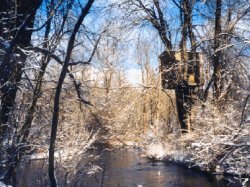 Tree House on Ten Acres: At first glance, it appears that this family is trying to sell a 3,800-square-foot four-bedroom home on ten acres. But, don’t be fooled. You’re really buying a quality cedar siding tree house with cedar built-in bunks and cabinets with brass hardware. The tree house windows are double hung brown aluminum storms with screens, and it has a secure deadbolt lock and a battery-operated security alarm. The solar collector transmits electricity to the 12-volt cycle battery that powers a switch-operated ceiling light and cigarette lighter socket outlets. The view is amazing, as the tree house sits high above Paint Creek near an artesian spring and stream-fed trout pond. You also get that four-bedroom, four-car garage in this deal if you want it. All for the amazingly low price of $1,750,000.
Tree House on Ten Acres: At first glance, it appears that this family is trying to sell a 3,800-square-foot four-bedroom home on ten acres. But, don’t be fooled. You’re really buying a quality cedar siding tree house with cedar built-in bunks and cabinets with brass hardware. The tree house windows are double hung brown aluminum storms with screens, and it has a secure deadbolt lock and a battery-operated security alarm. The solar collector transmits electricity to the 12-volt cycle battery that powers a switch-operated ceiling light and cigarette lighter socket outlets. The view is amazing, as the tree house sits high above Paint Creek near an artesian spring and stream-fed trout pond. You also get that four-bedroom, four-car garage in this deal if you want it. All for the amazingly low price of $1,750,000.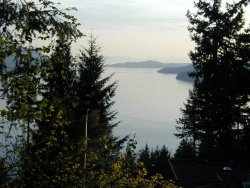 Treehouse B&B: Ok, so this ‘for sale’ property isn’t built up in the trees; however, this view and the name along with surrounding Douglas Firs, Cypress, Pacific Dogwood, and a multitude of other trees can offer a simulation of a tree house for those who are afraid to climb ladders and walk across swinging bridges. Although this building has a history of a bed and breakfast inn, it is being sold as a primary residence complete with lake views, bears, and an easy thirty-minute drive from downtown Vancouver. This is an ideal home for the sports-minded, as golfing, hiking, mountain-biking, water sports and more are all waiting outside the front door. Call the current owners for a viewing if you’re interested in the $1,239,000 price tag.
Treehouse B&B: Ok, so this ‘for sale’ property isn’t built up in the trees; however, this view and the name along with surrounding Douglas Firs, Cypress, Pacific Dogwood, and a multitude of other trees can offer a simulation of a tree house for those who are afraid to climb ladders and walk across swinging bridges. Although this building has a history of a bed and breakfast inn, it is being sold as a primary residence complete with lake views, bears, and an easy thirty-minute drive from downtown Vancouver. This is an ideal home for the sports-minded, as golfing, hiking, mountain-biking, water sports and more are all waiting outside the front door. Call the current owners for a viewing if you’re interested in the $1,239,000 price tag. O2 Treehouse: Possibly one of the most eco-friendly treehouses around, the O2 Treehouse serves many purposes. It is a place for reflection, social gathering and day-dreaming; for observing nature, holding group meetings and team-building activities. Perhaps its most intriguing aspect is its ability to adapt to large-scale design and implementation projects. It uses 100% sustainable materials and does not harm the growth of the host tree in any way. It will fit in any tree, single trunk, multi trunk or even multiple trees in a forest. Hanging like a giant mushroom above a forest floor, the O2 Treehouse even comes in stealth mode, much like the ‘predator.’ Dustin Feider, the designer of the O2 Treehouse, has set out to revolutionize not merely tree houses but the entire concept of habitat. For Feider, the tree house is a symbol of the entire sustainability movement and a beacon of hope for man’s survival. While this unit isn’t for sale, a trip to his site will reveal how the O2 Treehouse is built. This catalog also supplies insights into various models, including an on-ground model and a model designed for areas that don’t contain trees.
O2 Treehouse: Possibly one of the most eco-friendly treehouses around, the O2 Treehouse serves many purposes. It is a place for reflection, social gathering and day-dreaming; for observing nature, holding group meetings and team-building activities. Perhaps its most intriguing aspect is its ability to adapt to large-scale design and implementation projects. It uses 100% sustainable materials and does not harm the growth of the host tree in any way. It will fit in any tree, single trunk, multi trunk or even multiple trees in a forest. Hanging like a giant mushroom above a forest floor, the O2 Treehouse even comes in stealth mode, much like the ‘predator.’ Dustin Feider, the designer of the O2 Treehouse, has set out to revolutionize not merely tree houses but the entire concept of habitat. For Feider, the tree house is a symbol of the entire sustainability movement and a beacon of hope for man’s survival. While this unit isn’t for sale, a trip to his site will reveal how the O2 Treehouse is built. This catalog also supplies insights into various models, including an on-ground model and a model designed for areas that don’t contain trees.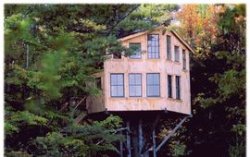 Treehouse Chronicles: There are times when you realize your age, your ambition, your competition and your fear of heights. At this point, you may be satisfied with kicking back, reading a great book on how to build a treehouse and just take a nap. In this case, the Treehouse Chronicles: One Man’s Dream of Life Aloft might be your cup of tea, as the house shown is the main subject of this book written by the “treehouse guy,” Peter Lewis. The tree house is a 300-square-foot timber frame hideaway, and the book is a large format coffee-table book that has gone on to win seven national book awards. In the meantime, you can follow the link to Mr. Lewis’ blog, where you can find more photos and details about the house and the book. Once you read on, your age, ambition, competition and fear of heights may mean nothing to you – after all, you deserve as much as Peter Lewis, right?
Treehouse Chronicles: There are times when you realize your age, your ambition, your competition and your fear of heights. At this point, you may be satisfied with kicking back, reading a great book on how to build a treehouse and just take a nap. In this case, the Treehouse Chronicles: One Man’s Dream of Life Aloft might be your cup of tea, as the house shown is the main subject of this book written by the “treehouse guy,” Peter Lewis. The tree house is a 300-square-foot timber frame hideaway, and the book is a large format coffee-table book that has gone on to win seven national book awards. In the meantime, you can follow the link to Mr. Lewis’ blog, where you can find more photos and details about the house and the book. Once you read on, your age, ambition, competition and fear of heights may mean nothing to you – after all, you deserve as much as Peter Lewis, right?
Want to Live in a Castle? 10 Great Options for $250k or Less
Posted in Features on July 29, 2008Have you dreamed of owning a castle? For the price of an average home in the U.S., you can own a piece of history or the whole shebang. Not all castles listed on the market command a fortune. You can find a masseria in Italy, a châteaux in France (or, as you’ll see below, a plot of land on a châteaux property) or a property in Poland for a mere pittance. If you conduct a Web search for castles for sale, you might be pleasantly surprised at the prices you’ll discover.
In Eastern European countries like Poland and the Czech Republic, where many old castles and estates were often turned into agricultural buildings, schools or communal housing, some structures may go for less than $100,000. However, many of these properties do not meet American standards for “ready to move in.” They may lack amenities such as plumbing or sewer or they’ve been neglected to the point where it could cost millions of dollars to restore the property. And, as these properties become more popular, their prices will rise. But, if you’re patient, you’ll discover new properties listed daily at many of these Web sites.
The listings below are filed in price range from the lowest- to highest-priced properties, and they include properties that were discovered online during the second two weeks in July 2008. Therefore, they may not be available when you get around to checking out the properties, but you may find more properties to take their places. Their standing in this list is no reflection on value, as this list is just a list, not an endorsement of any property or real estate broker. In addition, the USD prices listed in parentheses below are an approximate value of a given price listed for a given property, based upon currency exchange values for the week of 14 July 2008.
 A Masseria in Italy
A Masseria in Italy
The Lowdown: A masseria is a farm or estate, and many Italian masserias once belonged to royalty. This particular Salento masseria is located in the Puglia (Apulia) countryside. It needs vast restoration for its fortifications, which include cultivated lands and terraces. Once restored, this palace could be breathtaking. The price, which seems ridiculously low, seems to be part of an auction scheme, as the Realtor states no prices on the home site, simply, “Reserved negotiations,” whereas other listings show the 1 EUR price.
Why You Should Want This Castle: Although you may pay more than $1.50 USD for this property, if you have the wherewithal to purchase and renovate this masseria, you then could have a wise investment on your hands. Did we mention that this property is located near Lecce, a city also known as the “Florence of the South,” for its rich Baroque architectural monuments and for its location in southern Italy? Speaking of location (location, location), this property is located in a region in southeastern Italy that borders the Adriatic Sea to the east, the Ionian Sea to the southeast, and the Strait of Òtranto and Gulf of Taranto in the south. Its southern portion is known as “Salento,” a peninsula that forms a high heel on the “boot” of Italy. This is an ideal purchase for anyone who loves the countryside and endless water.
Price:: 1 EUR ($1.58414 USD)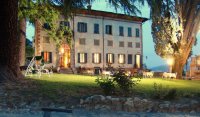 Italian Castle Living
Italian Castle Living
The Lowdown: Don’t let the ‘Castle on the Lake for rent’ title throw you when you follow this link. This late sixteenth-century castle is for sale. Originally created by Cardinal Morigia, this property contains a terraced park, grand staircases, Renaissance-style statues, a swimming pool, tennis court and panoramic views of a lake. It is currently used as a hotel, complete with antique furniture, marble flooring and wood parquet, frescos, five bedrooms with bathrooms and balconies and more for a grand total of 13,073 square feet. Yet, it needs restoration.
Why You Should Want This Castle: This castle is located in Piedmont Ghiffa, an area in northern Italy. This area is popular with tourists, thanks to adjacent Lake Maggiore and to the famous nearby Sacro Monte, a site of pilgrimage and worship for Christians. So, this steal-of-a-deal hotel could make a great investment property for anyone who wants to host guests. Or, just purchase it for the furniture and flip the hotel unfurnished. On the other hand, this romantic-looking property might just steal your heart. In that case, you might hire an architect to scope out the true state of affairs, as this price seems too good to be true.
Price:: 15,000 EUR ($24,000 USD)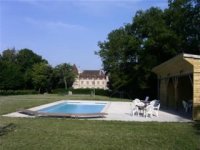 Auvergne, France Châteaux Lot
Auvergne, France Châteaux Lot
The Lowdown: If you don’t have the stomach for heavy-duty renovation, but you might be in the mood to build, perhaps this sweet little plot in France will tickle your fancy. This is a nicely-situated building plot located on the grounds of a nineteenth-century châteaux. You can build up to a 200m2 (2152.7 square feet) villa with two levels and a semi-attic for storage. You will have water, sewage, electricity and phone service, and the boundaries already have been marked off with newly planted hedges.
Why You Should Want This Châteaux Lot: It’s located in Auvergne, folks – smack dab in the middle of France. This region is famous for its cheeses, mineral water exports and Michelin tires. Outside these material items, the buyer has full access to the communal swimming pool, sauna and bar area. So, no need to build anything other than your new home.
Price:: 54,500.00 EUR ($86,466.71 USD)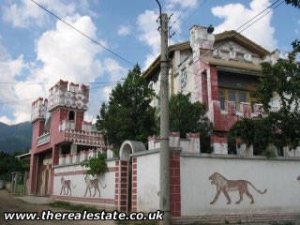 Bulgarian Castle
Bulgarian Castle
The Lowdown: This lion-splashed property is located in a small and quiet European mountain village at the feet of the Stara Panina and Sredna Gora mountains (Balkan Mountains). But, the castle also is centrally located, as Sopot is about three miles away, Karlovo is about six miles distant to the east and it is 41 miles to the city of Plovdiv to the south, which is the second largest city in Bulgaria after the capital city, Sofia. A river passes near the castle village and the region is suitable for hunting and fishing. An asphalt road leads from the village to the castle, which makes this castle approachable during winter. The house is a three-story building with modern architecture, electricity, running water, sewage-system, etc. The courtyard contains a large area of cultivation that includes trees, flowers and bushes. All this crown home needs is a bit of exterior work, according to the sellers.
Why You Should Want This Castle: If you do some research into the area, you’ll learn that Sopot is famous for its paragliding and handgliding, Karlovo is filled with history and roses (literally – this is large-scale rose production, including their famous rose oil), and Plovidv is an important economic, transport, cultural and educational center. All this comes together to provide you with an opportunity to appeal to a wide variety of tourists as you rent out your castle to visitors. Or, if you decide to live here yourself, you can enjoy one of the most ‘ready-to-move-in’ properties on this list.
Price:: 55,000 EUR ($87,125.77 USD)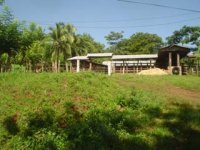 Costa Rican Castle
Costa Rican Castle
The Lowdown: Before you pass judgement on this ‘castle’ (it is listed as such), look at the price and the amenities first. This property is conveniently located in the Nicoya Península in Costa Rica, with good access and ample public road frontage. It is close to Carrillo and Sámara beaches, and it has awesome panoramic views to scenic valleys. There are three rivers, two are small and one is big, on 481 acres. And, it comes with water and electricity.
Why You Should Want This Castle: Although this castle doesn’t come with turrets, it is located in the Guanacaste region, known for sportsfishing, heavenly beaches, bird watching, horseback riding, excellent surfing, superb snorkeling and truly amazing and breathtaking scenery. The eastern border of Guanacaste is formed by a chain of volcanoes. They offer great hiking and views of the surrounding countryside. Dense and lush forests fill the valleys, and many endangered animals and birds reside here, including jaguars and tapirs. If you’re a nature enthusiast, you could lose yourself in this kingdom.
Price:: $100,000 USD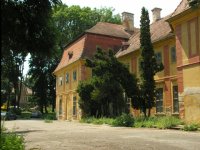 Southern Slovakian Castle
Southern Slovakian Castle
The Lowdown: If you’d like four bastions on your castle as well as 35 bedrooms, then this gem – located in the Casoviapolis region of Slovakia in eastern Europe – might be yours. The rooms which were used as classrooms for a primary school during the last half of the twentieth century. The property carries a large park in front with a small pond, and it also is in reach of all the amenities that Trnava has to offer. The history within this town dates back to 1211, if not earlier. After the establishment of Slovakia in 1993, Trnava became the capital of the newly created Trnava Region in 1996. Any person who chooses to purchase this castle also will enjoy access to universities, libraries, theaters, a district hospital and other modern amenities against an historical backdrop.
Why You Should Want This Castle: This structure is large enough to house a single family as well as a few guests. Make it work as a honeymoon retreat, complete with a history that would suit the setting. The first written document about this castle was generated in 1583, when the Croatian nobel, Ungnada, invited other nobles to this residence for his daughter’s wedding. Although this castle has seen numerous renovations since that event, this castle’s Renaissance/Baroque stylings can capture the imagination of any newly-wedded couple. For the price listed below, how could you go wrong?
Price:: 107,000 EUR ($169,711.46 USD)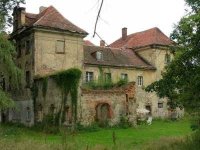 XVI-Century Palace in Lower Silesia
XVI-Century Palace in Lower Silesia
The Lowdown: If your style is Baroque built with brick and stone, then this palace from the XVI century (1570) might tickle your historic decorating bone. Located in the Boleslawiec area of Poland (home of Boleslawiec Pottery), this building contains a strong foundation, an asphalt access road, electricity, sewer and water. Telephone lines, Internet access and a full basement makes this private property an absolute steal.
Why You Should Want This Castle: While the property needs renovation, there’s a place for parking and the opportunity to purchase adjoining land. Along with all the amenities listed above, this building easily could be made into a tourist hotel for pottery fanatics. Much of the pottery made in this region is of high-quality, handpainted stoneware. In 1898, the German government established the Keramische Fachschule (Ceramic Technical Training School) to foster development of the art. The added plus is this castle’s terrace with mountain views.
Price:: 125,000 EUR ($198,242.18 USD)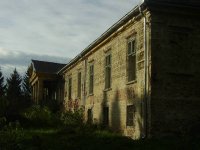 19th Century Castle For Sale in Hungary
19th Century Castle For Sale in Hungary
The Lowdown: This European castle, built in the classicist style, is a gem in the rough. It is located in Kercseliget, Hungary, near the city of Kaposvar (the capital of the county of Somogy) and about thirty-one miles from the Balaton, one of the largest lakes in Europe and often called the “Hungarian Sea.” A water quality survey has been conducted on this property, and the water is spa-quality, the same as two other spas located nearby.
Why You Should Want This Castle: Although this structure was built about 1840, the foundation is strong. Additionally, preliminary construction has begun to convert this building, which has a wine cellar, into a tourist facility. The spa waters add to the possibility that this castle could earn its keep, especially with its close proximity to Kaposvar and to the popular tourist destination of Lake Balaton.
Price:: 150,000 EUR ($237,969.23 USD) (Negotiable) An Irish Abode
An Irish Abode
The Lowdown: The top write-up in this link is the one of interest, as it offers the Brackloon Castle Clonfert, County Galway for sale. Clonfert and its castle is part of the ancestral home of the Maddens and forms a stage of the Beara-Breifne Greenway which is based on the historic march of O’Sullivan Beara in 1603. Attacked many times and captured by Queen Mary’s forces during the sixteenth century, this castle was inhabited until the 1950s. At that time, teachers from the nearby Clonfert School were its inhabitants. They enjoyed four floors connected by a spiral stone staircase that, contrary to popular construction, spirals counterclockwise. The castle is now missing its upper floors and it is roofless, but the main structure appears sound and able to withstand restoration.
Why You Should Want This Castle: If an Irish soul is reading this (especially a Madden), need I say more? But, just to entice you even further, the tower house of this castle is located on 8.5 acres overlooking a stream with opportunities for fishing. Plus, the owner can look for further entertainment on the Shannon, which is fit for sailing and cruising. This castle is situated close to the village of Clonfert, a tiny village in South Galway bordering County Offaly. This village is well known for Saint Brendan’s Church of Ireland Cathedral, the oldest living church in Ireland with an unbroken history of public worship.
Price:: £120,000 ($239,605.18 USD)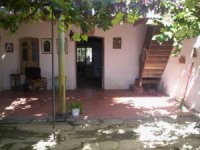 Fortified Castle and Jesuit Estate
Fortified Castle and Jesuit Estate
The Lowdown: If you want a safe place to reside in the South American countryside, then you might find this fortified castle and 1790 Jesuit estate in Uruguay appropriate. The property is located on a 148-acre ranch in north Uruguayan hill country. Although the land around this area is traditionally known for sheep and cattle breeding, much of the area is being converted to forest. This may be the oldest castle for sale in Uruguay, as it dates back to Spanish colonial era, founded by Jesuits, and later used as a Spanish royal mail stage post.
Why You Should Want This Castle: While the amenities are limited, many parts of this building are the original 1790s construction, including the entranceway. The property contains a quarters for staff, a barn and a workshop. You’ll own cattle installations along with a fieldstone corral. While you may not want to own cattle, these structures possibly could be used for horses. The property is located about 249 miles from Montevideo, which is the largest city, the capital and chief port of Uruguay. A big plus – most of that road is paved! The only problem, really, to acquiring this simple yet beautiful abode is the price. You may need to haggle down $10,000 USD to meet the the $250,000 mark, but this one was just too good to leave off the list!
Price:: $260,000 USD
10 Beautiful Private Islands for Sale (That You Could Actually Afford)
Posted in Features on July 9, 2008Who hasn’t dreamed of living on a private island, away from the hustle and bustle of city life? But, how often have you dismissed this dream with thoughts that you couldn’t possibly afford this luxury? Well, you may need to rethink your dreams, because many private islands now are listed for less than $500,000 USD. In fact, you can find islands for less than $100,000. All you need to do is spend a little time searching online for your dream environment.
The point to remember in this situation is that you get what you pay for. Cheaper islands, on the whole, tend to be undeveloped. This means that you may need to acquire electricity, plumbing and land suitable for building to complete your dream of living on said island. Additionally, it may be tough to obtain a mortgage for island purchases, because most islands lack ‘comparables’ for valuation purposes. So, you’ll either need cash on hand or a solid business plan for development that could add valuation to your island (such as a resort).
On the other hand, you can employ such amenities as prefabricated homes, easy-to-install solar power, reverse-osmosis water filtration systems and composting toilets. All these items, which are perfect for island living, are within reach for an island dweller’s average budget. So, keep these plus-side items in mind when you tackle your search. The ten islands listed below will give you a head start, as they lead to real estate businesses that can help you realize your private island dream.
The list below is organized by price, with the least expensive listed first, and the most expensive at the end.
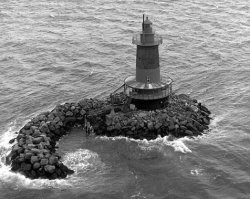 West Bank Lighthouse: The U.S. General Services Administration actually is auctioning two lighthouses/islands in New York. The one shown here, the West Bank Lighthouse, and the Old Orchard Shoal Lighthouse both are for sale. Both properties are open for bids starting at $10,000, and – as of this writing – no bids have been offered. On the plus side, both lighthouses offer 360-degree water views and both lighthouses retain basic integrity despite neglect. Plus, the new owners will claim a bit of history with either purchase. But, both lighthouses have been neglected, and they will be sold “as is” without warranties. Additionally, both properties require an easement to legally occupy the submerged land, and the properties must be maintained in accordance with the Secretary of Interior’s Standards for Rehabilitation and in consultation with the New York State Historic Preservation Office. The Old Orchard Shoal Lighthouse is located approximately 3.5 miles south of New Drop Beach on Staten Island, Richmond County, New York. The keeper’s quarters consist of approximately 1000 square feet of space with porthole-styled windows. The interior is brick-lined in the first three stories. The West Bank Lighthouse is located in Lower New York Bay and is situated approximately 3.2 miles east of Staten Island, Richmond County, New York. This property sits on a man-made island and includes a riprap breakwater which extends westward approximately 100 feet from the lighthouse. There are two pilings which serve as moorings, and the interior is accessed by a metal platform and ladder. Both properties are accessible only by boat. Current price: Starting at $10,000 USD.
West Bank Lighthouse: The U.S. General Services Administration actually is auctioning two lighthouses/islands in New York. The one shown here, the West Bank Lighthouse, and the Old Orchard Shoal Lighthouse both are for sale. Both properties are open for bids starting at $10,000, and – as of this writing – no bids have been offered. On the plus side, both lighthouses offer 360-degree water views and both lighthouses retain basic integrity despite neglect. Plus, the new owners will claim a bit of history with either purchase. But, both lighthouses have been neglected, and they will be sold “as is” without warranties. Additionally, both properties require an easement to legally occupy the submerged land, and the properties must be maintained in accordance with the Secretary of Interior’s Standards for Rehabilitation and in consultation with the New York State Historic Preservation Office. The Old Orchard Shoal Lighthouse is located approximately 3.5 miles south of New Drop Beach on Staten Island, Richmond County, New York. The keeper’s quarters consist of approximately 1000 square feet of space with porthole-styled windows. The interior is brick-lined in the first three stories. The West Bank Lighthouse is located in Lower New York Bay and is situated approximately 3.2 miles east of Staten Island, Richmond County, New York. This property sits on a man-made island and includes a riprap breakwater which extends westward approximately 100 feet from the lighthouse. There are two pilings which serve as moorings, and the interior is accessed by a metal platform and ladder. Both properties are accessible only by boat. Current price: Starting at $10,000 USD. Dolphin Bay Island: This is a small island that consists of 6,000 sq. ft., but it is located in a very nice area near Bocatorito, Panama, with views of Dolphin Bay. Plus, access to the island is easy, with a connection to San Cristobal Island via a strip of mangrove and access by boat within twenty minutes from Bocas. You’ll find a few large trees and some pineapple plants, and the island sits in protected waters with deep water nearby. The island displays elevation, and it is perfect for a single-family home. Current price: $40,000 USD.
Dolphin Bay Island: This is a small island that consists of 6,000 sq. ft., but it is located in a very nice area near Bocatorito, Panama, with views of Dolphin Bay. Plus, access to the island is easy, with a connection to San Cristobal Island via a strip of mangrove and access by boat within twenty minutes from Bocas. You’ll find a few large trees and some pineapple plants, and the island sits in protected waters with deep water nearby. The island displays elevation, and it is perfect for a single-family home. Current price: $40,000 USD.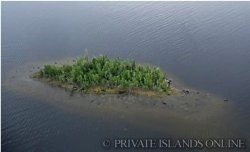 Bereck Island: Canadian islands remain a relative bargain, with several available for less than $100,000. Bereck Island, located on Stuart Lake in British Columbia, Canada, represents one of these bargains. Stuart Lake is the seventh largest lake in B.C., and it is a fisherman’s paradise stocked with rainbow trout, lake trout and kokanee. The island is approximately one acre, and it is surrounded by a shallow rocky shelf on its south side that is exposed during low water level and that is visible during winter. The island is accessible by boat or by floatplane. Bereck Island is zoned as residential, so there should not be any problems building a dwelling. Nearby towns include Fort St. James, which is accessible by paved road and is located about 60 km north of Vanderhoof and 160 km northwest of Prince George. Current price: CAD $65,000 ($64,327.21 USD).
Bereck Island: Canadian islands remain a relative bargain, with several available for less than $100,000. Bereck Island, located on Stuart Lake in British Columbia, Canada, represents one of these bargains. Stuart Lake is the seventh largest lake in B.C., and it is a fisherman’s paradise stocked with rainbow trout, lake trout and kokanee. The island is approximately one acre, and it is surrounded by a shallow rocky shelf on its south side that is exposed during low water level and that is visible during winter. The island is accessible by boat or by floatplane. Bereck Island is zoned as residential, so there should not be any problems building a dwelling. Nearby towns include Fort St. James, which is accessible by paved road and is located about 60 km north of Vanderhoof and 160 km northwest of Prince George. Current price: CAD $65,000 ($64,327.21 USD).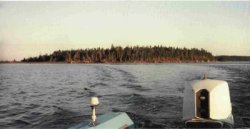 David Island: Settle down on approximately five forested acres in Guysborough County, Nova Scotia. David Island lies in the bay of Port Felix, about 30km from the city of Canso and near the town of Whitehead. The existing simple 12′ x 16′ cabin was built in 2003, and it does not support a septic system. But, it will provide a roof over your head as you plan for your future residence (which is, in principal, possible). This island could serve as a great fishing camp, provided you bring potable water. The view includes the mainland and other islands, which lie in the Tor Bay direction. Current price: CAD $75,000 ($74,474.55 USD).
David Island: Settle down on approximately five forested acres in Guysborough County, Nova Scotia. David Island lies in the bay of Port Felix, about 30km from the city of Canso and near the town of Whitehead. The existing simple 12′ x 16′ cabin was built in 2003, and it does not support a septic system. But, it will provide a roof over your head as you plan for your future residence (which is, in principal, possible). This island could serve as a great fishing camp, provided you bring potable water. The view includes the mainland and other islands, which lie in the Tor Bay direction. Current price: CAD $75,000 ($74,474.55 USD).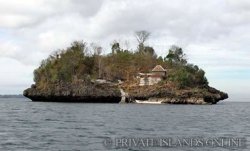 Chris Pinnacle: This sale consists of two islands, which comprise an area of approximately 2.47 acres or one hectare located in Jordan, on the western side of Guimaras, Philippines. One island contains a small bamboo hut with an outside seating area and a concrete pier. While no electricity runs to the islands, it is possible to transport power and water across from the mainland via underwater pipe. The mainland is only a few hundred meters, or a five-minute boat ride, from the island. The larger of the two islands holds a large area at the peak where a house could be situated. This view is magnificent, as you can enjoy the sunset to the west and unusual rock formations along the coastline to the east. The smaller island is in ‘virgin condition,’ and it also contains a flat top. Both islands are within viewing distance of a resort situated a mere 200 meters away on the mainland. This location and ease of access, in addition to the unusual stone formations, the potential for sea-kayaking and diving and snorkeling (yes, coral formations are abundant here) make these islands ideal for resort development. Current price: $100,000 USD.
Chris Pinnacle: This sale consists of two islands, which comprise an area of approximately 2.47 acres or one hectare located in Jordan, on the western side of Guimaras, Philippines. One island contains a small bamboo hut with an outside seating area and a concrete pier. While no electricity runs to the islands, it is possible to transport power and water across from the mainland via underwater pipe. The mainland is only a few hundred meters, or a five-minute boat ride, from the island. The larger of the two islands holds a large area at the peak where a house could be situated. This view is magnificent, as you can enjoy the sunset to the west and unusual rock formations along the coastline to the east. The smaller island is in ‘virgin condition,’ and it also contains a flat top. Both islands are within viewing distance of a resort situated a mere 200 meters away on the mainland. This location and ease of access, in addition to the unusual stone formations, the potential for sea-kayaking and diving and snorkeling (yes, coral formations are abundant here) make these islands ideal for resort development. Current price: $100,000 USD. Cockroach Caye: If you want to start from scratch, Cockroach Caye (shaped like a cockroach), located fifteen miles east of Belize City, Belize, Central America, is a great place to begin. This unspoiled, undeveloped virgin swamp-free ten-acre property features 500 feet of Caribbean sea front in Cockroach Bay with approximately 300 yards to the eighteen-mile-long reef. The island sits on top of the reef that extends from Turneffe Island, located a mere 300 feet west of this island. The island will need to be cleared for development, as it is packed with coconut trees and mangrove. But, you’ll discover beautiful white sand along its beaches. If you are into fishing, you’ll discover tarpon and bonefish in the nearby flats and in the deep blue you can fish for Marlin, Sail Fish, Tuna , Wahoo and more. Cockroach Caye is part of the Turneffe Atoll , which is about thirty miles long and about eight miles wide, and is the largest of the three atolls in the area. Turneffe is the closest to the mainland and is home to a number of world-class dive sites. The atoll has a scattering of fishing camps, some of which are permanently occupied, and some of which are used only on a seasonal basis. At peak times, when combined with tourists and researchers, the atoll is inhabited by approximately 300 people. If you arrive by air to Belize City, it will take you about one hour to get to your island by boat. The seller is eager, and will consider all offers and can offer some financing as well. Current price: $189,900 USD.
Cockroach Caye: If you want to start from scratch, Cockroach Caye (shaped like a cockroach), located fifteen miles east of Belize City, Belize, Central America, is a great place to begin. This unspoiled, undeveloped virgin swamp-free ten-acre property features 500 feet of Caribbean sea front in Cockroach Bay with approximately 300 yards to the eighteen-mile-long reef. The island sits on top of the reef that extends from Turneffe Island, located a mere 300 feet west of this island. The island will need to be cleared for development, as it is packed with coconut trees and mangrove. But, you’ll discover beautiful white sand along its beaches. If you are into fishing, you’ll discover tarpon and bonefish in the nearby flats and in the deep blue you can fish for Marlin, Sail Fish, Tuna , Wahoo and more. Cockroach Caye is part of the Turneffe Atoll , which is about thirty miles long and about eight miles wide, and is the largest of the three atolls in the area. Turneffe is the closest to the mainland and is home to a number of world-class dive sites. The atoll has a scattering of fishing camps, some of which are permanently occupied, and some of which are used only on a seasonal basis. At peak times, when combined with tourists and researchers, the atoll is inhabited by approximately 300 people. If you arrive by air to Belize City, it will take you about one hour to get to your island by boat. The seller is eager, and will consider all offers and can offer some financing as well. Current price: $189,900 USD. Lenur Island: Lenur Island is a beautiful and unspoiled thirty-seven acre island, situated in the crystal clear waters of South Malakula, Republic of Vanuatu, Oceania. The archipelago is some 1,090 miles east of northern Australia, 310 miles north-east of New Caledonia, west of Fiji, and south of the Solomon Islands. The archipelago is of volcanic origin, and maintains a tropical or sub-tropical climate. The island is surrounded by small trees and a few coconut palms and there is about three fresh water streams that run from the mainland to the island’s harbor. From all claims, this island is the best site for a fishing stop for people who decided to come for game fishing in Vanuatu. It claims the best harbor and beautiful sunset views. Current price: $400,000 USD.
Lenur Island: Lenur Island is a beautiful and unspoiled thirty-seven acre island, situated in the crystal clear waters of South Malakula, Republic of Vanuatu, Oceania. The archipelago is some 1,090 miles east of northern Australia, 310 miles north-east of New Caledonia, west of Fiji, and south of the Solomon Islands. The archipelago is of volcanic origin, and maintains a tropical or sub-tropical climate. The island is surrounded by small trees and a few coconut palms and there is about three fresh water streams that run from the mainland to the island’s harbor. From all claims, this island is the best site for a fishing stop for people who decided to come for game fishing in Vanuatu. It claims the best harbor and beautiful sunset views. Current price: $400,000 USD.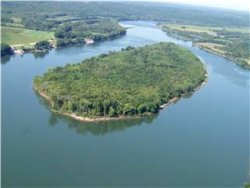 Eagle’s Nest Island: Who would have thought that an affordable island could be found in the heart of the U.S.? Eagle’s Nest Island, located in Bath Springs, Decatur County, Tennessee, offers over 167 acres of undisturbed hardwoods, stone and sand in the middle of the Tennessee River. The island holds some Civil War history, as Union troops searched for Confederate troops here in 1863. Decatur County and its cities and communities (including Parsons and Decaturville) boasts an active and progressive Chamber of Commerce, fine medical facilities, one of the best paramedic and emergency response teams in the State of Tennessee, a host of volunteer fire departments, an all volunteer, highly professional rescue squad and an excellent education system. The county borders fifty miles of undeveloped river property, a tourism card that brings many visitors to this area to enjoy fishing, camping, swimming and river recreation, sports and hunting. The island is approachable only by boat. Current Price: $350,000 USD.
Eagle’s Nest Island: Who would have thought that an affordable island could be found in the heart of the U.S.? Eagle’s Nest Island, located in Bath Springs, Decatur County, Tennessee, offers over 167 acres of undisturbed hardwoods, stone and sand in the middle of the Tennessee River. The island holds some Civil War history, as Union troops searched for Confederate troops here in 1863. Decatur County and its cities and communities (including Parsons and Decaturville) boasts an active and progressive Chamber of Commerce, fine medical facilities, one of the best paramedic and emergency response teams in the State of Tennessee, a host of volunteer fire departments, an all volunteer, highly professional rescue squad and an excellent education system. The county borders fifty miles of undeveloped river property, a tourism card that brings many visitors to this area to enjoy fishing, camping, swimming and river recreation, sports and hunting. The island is approachable only by boat. Current Price: $350,000 USD.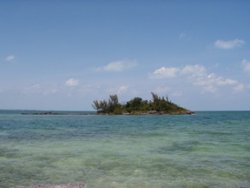 Carrington Cay: If you’ve been to Great Abaco Island and fell in love with this Bahamian island, then this treat is right up your alley. This island is located just 300 feet offshore from Great Abaco Island, but it provides the seclusion that only a 1.4-acre private island can offer. Still, you would be located within minutes of shopping and other urban conveniences at Leisure Lee, an exclusive canal community filled with quality homes. Carrington Cay also is located just three miles from the more cosmopolitan Treasure Cay, a thriving luxury resort with a full-service marina, golf course, shopping and every amenity imaginable. The island has good deep water for dockage at western end (eight-foot depth at mean low water), and spectacular views of nearby Great Guana Cay and Treasure Cay. A rare bonus is that due to the prevailing winds, the island is essentially insect-free, and with cable, electricity and potable water available for hook-up from the mainland, it will be easy to establish all the comforts of home on your private island paradise as soon as you sign the papers. Current price: $455,000 USD.
Carrington Cay: If you’ve been to Great Abaco Island and fell in love with this Bahamian island, then this treat is right up your alley. This island is located just 300 feet offshore from Great Abaco Island, but it provides the seclusion that only a 1.4-acre private island can offer. Still, you would be located within minutes of shopping and other urban conveniences at Leisure Lee, an exclusive canal community filled with quality homes. Carrington Cay also is located just three miles from the more cosmopolitan Treasure Cay, a thriving luxury resort with a full-service marina, golf course, shopping and every amenity imaginable. The island has good deep water for dockage at western end (eight-foot depth at mean low water), and spectacular views of nearby Great Guana Cay and Treasure Cay. A rare bonus is that due to the prevailing winds, the island is essentially insect-free, and with cable, electricity and potable water available for hook-up from the mainland, it will be easy to establish all the comforts of home on your private island paradise as soon as you sign the papers. Current price: $455,000 USD.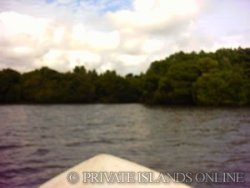 Katunayake Island: Located a mere two-minute speed boat ride from the west coast of Sri Lanka, this ten-acre Asian tropical island begs for an eco-tourism resort development. Why? For one reason, the buyer is required to divest in an Eco-Friendly operation. Secondly, the convenience of the nearby Bandaranayake International Airport and the short distance to Colombo, Sri Lanka, makes it easy for visitors to gain access to your property. Finally, the island is a beauty, with deciduous woods on the west side and green grasses and swaying trees on the eastern shores. The lagoon is peaceful, and you’ll enjoy birds that nest on the island, great sunsets and sunrises, swimming and fishing from the beaches or rocks, caving and shell collecting. Although the island lacks electricity and phone service (cell signal is available), you can develop connectivity easily from the main road. Current price: $500,000 USD.
Katunayake Island: Located a mere two-minute speed boat ride from the west coast of Sri Lanka, this ten-acre Asian tropical island begs for an eco-tourism resort development. Why? For one reason, the buyer is required to divest in an Eco-Friendly operation. Secondly, the convenience of the nearby Bandaranayake International Airport and the short distance to Colombo, Sri Lanka, makes it easy for visitors to gain access to your property. Finally, the island is a beauty, with deciduous woods on the west side and green grasses and swaying trees on the eastern shores. The lagoon is peaceful, and you’ll enjoy birds that nest on the island, great sunsets and sunrises, swimming and fishing from the beaches or rocks, caving and shell collecting. Although the island lacks electricity and phone service (cell signal is available), you can develop connectivity easily from the main road. Current price: $500,000 USD.
10 Little-Known Palaces and Homes Where Royalty Play
Posted in Features on June 12, 2008How would you hide from the paparazzi, your scathing skeptics or needy subjects if you were a member of royalty? Would you own several homes far, far away from your domain? Or, would you show up unexpectedly with bodyguards and staff to a high-priced resort tucked neatly away in the Caribbean? It appears that some royalty maintain traditions where they show up at a summer home on schedule, a habit that tends to keep news about their travels low-key. Lately, however, it seems that some royalty have altered those well-known habits based upon political agendas or to simply break with generations-old customs. Why settle for the musty family summer palace when you can visit a new high-priced resort geared to royalty?
This ability to venture beyond tradition has led to another new trick for royalty and celebrities alike – if you can travel with staff, why not stay in the home of another multi-millionaire? This possibility has led some royals to stay in celebrity homes, palaces that belong to other royal families or in the homes of corporate CEOs who unabashedly rent their abodes for tens of thousands of dollars per week.
We discovered all the above choices when we picked a handful of royals to follow for their vacations and getaways. While the sites listed below are numbered and listed in alphabetical order, these organizational techniques do not indicate that we favor one getaway over another or that they are listed in order of value.
 Château de Caïx: Queen Margrethe of Denmark is a real homebody. Although she visits other heads of state for political reasons, her heart stays with her homeland as she officially resides at Amalienborg Palace in Copenhagen (where the Queen was born), spends summer at Marselisborg Castle near Århus, and uses Fredensborg Castle in North Zealand during the spring and fall. But, Queen Margrethe and her husband, Prince Henrik, also acquired a more private abode in 1974 when they purchased the Château de Caïx in Cahors, southern France. This latter home is the Queen’s true playground, where she can devote herself to her painting, graphic work and other artistic pursuits. Her works have been displayed at several exhibitions since 1988. This home also is a hideaway for her husband and his French relatives when he wants to escape Danish royal life, as this home originally belonged to his wine-producing family. Henrik was born to French parents, and his native tongue also is French.
Château de Caïx: Queen Margrethe of Denmark is a real homebody. Although she visits other heads of state for political reasons, her heart stays with her homeland as she officially resides at Amalienborg Palace in Copenhagen (where the Queen was born), spends summer at Marselisborg Castle near Århus, and uses Fredensborg Castle in North Zealand during the spring and fall. But, Queen Margrethe and her husband, Prince Henrik, also acquired a more private abode in 1974 when they purchased the Château de Caïx in Cahors, southern France. This latter home is the Queen’s true playground, where she can devote herself to her painting, graphic work and other artistic pursuits. Her works have been displayed at several exhibitions since 1988. This home also is a hideaway for her husband and his French relatives when he wants to escape Danish royal life, as this home originally belonged to his wine-producing family. Henrik was born to French parents, and his native tongue also is French.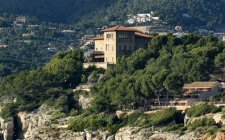 Marivent Palace (Palma de Mallorca): This is the traditional summer home for Spanish King Juan Carlos and his royal family. While kings usually grant aging castles and palaces to municipalities, this building was granted by the city to the king when he was a prince. King Carlos and his son, both ardent sailors, participate in the Yacht Regattas in August and the Royal Yacht is moored in Portals Nous. Palma is the major city and port on the island of Mallorca and capital city of the autonomous community of the Spanish Balearic Islands in Europe. In 2007, however, tradition was broken when Juan Carlos’ daughters, princesses Cristina and Elena, arrived in Budva, Montenegro to stay at the Iberostar Bellevue in August. Also known as the Budva Riviera, this coastal town is a tourist attraction and one of the oldest settlements on the Adriatic sea coast in southeastern Europe. The hotel is located along the spectacular Plaza Bellevue beach and is surrounded by unspoilt, green countryside. Located just a few miles from the center of Budva, a jet-set summer resort, this hotel has been historically marked as a destination for European royal families. Among the prestigious hotels located here is the “Milocer,” former residence of royal family Karadordevic of Serbia.
Marivent Palace (Palma de Mallorca): This is the traditional summer home for Spanish King Juan Carlos and his royal family. While kings usually grant aging castles and palaces to municipalities, this building was granted by the city to the king when he was a prince. King Carlos and his son, both ardent sailors, participate in the Yacht Regattas in August and the Royal Yacht is moored in Portals Nous. Palma is the major city and port on the island of Mallorca and capital city of the autonomous community of the Spanish Balearic Islands in Europe. In 2007, however, tradition was broken when Juan Carlos’ daughters, princesses Cristina and Elena, arrived in Budva, Montenegro to stay at the Iberostar Bellevue in August. Also known as the Budva Riviera, this coastal town is a tourist attraction and one of the oldest settlements on the Adriatic sea coast in southeastern Europe. The hotel is located along the spectacular Plaza Bellevue beach and is surrounded by unspoilt, green countryside. Located just a few miles from the center of Budva, a jet-set summer resort, this hotel has been historically marked as a destination for European royal families. Among the prestigious hotels located here is the “Milocer,” former residence of royal family Karadordevic of Serbia.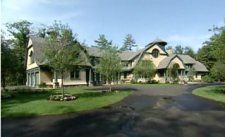 Michael Appe home: Few individuals would know about this home or its location in the Town of Wolfeboro, New Hampshire, unless they were born in the region, if they have too much money and a reason to hide away, or if they read the news about French President Sarkozy’s stay here in summer 2007. When French President and ex officio Co-Prince of Andorra, Nicolas Paul Stéphane Sarközy de Nagy-Bocsa (also simply known as Nicolas Sarkozy), visited this lakeside a town of around 6,000 residents 85 miles north of Boston last year, many learned that this area bills itself as the oldest summer resort in the U.S. Wolfeboro is a popular tourist destination because of its proximity to Lake Winnipesaukee. For residents, Wolfeboro represents a town with the seventh highest per capita income and the lowest crime rate in the country, the highest SAT scores for its students and – as a further benefit – a location in one of the lowest taxed states in the country. Like many current royalty, Sarkozy holed up in another multimillionaire’s home for his vacation, one that belongs to former Microsoft executive Michael Appe. Appe rents his 13,000-square-foot home for $30,000 per week, a fact that didn’t escape the notice of Sarkozy’s French critics. That amount equals one-third of the French president’s annual salary, another fact that might lead observers to understand that Sarkozy may not need his salary to stay afloat on Lake Winnipesaukee. Wolfeboro has a long history of hosting the rich and famous, including Monaco’s Prince Rainier and Princess Grace, author Kurt Vonnegut and actress Drew Barrymore.
Michael Appe home: Few individuals would know about this home or its location in the Town of Wolfeboro, New Hampshire, unless they were born in the region, if they have too much money and a reason to hide away, or if they read the news about French President Sarkozy’s stay here in summer 2007. When French President and ex officio Co-Prince of Andorra, Nicolas Paul Stéphane Sarközy de Nagy-Bocsa (also simply known as Nicolas Sarkozy), visited this lakeside a town of around 6,000 residents 85 miles north of Boston last year, many learned that this area bills itself as the oldest summer resort in the U.S. Wolfeboro is a popular tourist destination because of its proximity to Lake Winnipesaukee. For residents, Wolfeboro represents a town with the seventh highest per capita income and the lowest crime rate in the country, the highest SAT scores for its students and – as a further benefit – a location in one of the lowest taxed states in the country. Like many current royalty, Sarkozy holed up in another multimillionaire’s home for his vacation, one that belongs to former Microsoft executive Michael Appe. Appe rents his 13,000-square-foot home for $30,000 per week, a fact that didn’t escape the notice of Sarkozy’s French critics. That amount equals one-third of the French president’s annual salary, another fact that might lead observers to understand that Sarkozy may not need his salary to stay afloat on Lake Winnipesaukee. Wolfeboro has a long history of hosting the rich and famous, including Monaco’s Prince Rainier and Princess Grace, author Kurt Vonnegut and actress Drew Barrymore. Mustique: The Island of Mustique was made private when it was leased for 99 years from the British Commonwealth by Scotsman Colin Tennant aka Lord Glennconner in 1958. He turned the island into a hideway for British royals and celebrities. He lost the island in the 1970s, but the island remained private thanks to the operation and ownership of the Mustique Company, an organization comprised of shareholders and villa owners who are dedicated to protecting this island’s natural beauty, tranquility and privacy. Comprised of 1,400 acres, Mustique is part of the Grenadines in the West Indies on the edge of the Caribbean. Prince William and his long-time girlfriend Kate Middleton escaped to this resort for a romantic getaway in 2006, and they stayed in a villa owned by John Robinson (a close friend of Kate’s parents), the multimillionaire founder of the Jigsaw fashion chain (where Kate once worked). A more recent trip by Prince William and Kate put them in the £1,785-per-night Villa Alumbrera, one of the island’s most opulent and secluded mansions, for a week. This villa is owned by the widow of Swedish mining tycoon Adolf Lundin. Other royalty who have frequented this island include Princess Margaret and Viscout David Linley. Prices range from $5,000 per week for a two-bedroom villa to $27,000 per week for a nine-bedroom villa, depending upon season. Single rooms range from $500 to $1,400 per night. The most popular ‘hangout’ on the island is Basil’s Bar, which also is home to the Mustique Blues Festival. Proceeds from the sale of the festival’s CDs and t-shirts fund the Basil Charles’ Education Fund, an organization that provides education for children who reside in St. Vincent and the Grenadines.
Mustique: The Island of Mustique was made private when it was leased for 99 years from the British Commonwealth by Scotsman Colin Tennant aka Lord Glennconner in 1958. He turned the island into a hideway for British royals and celebrities. He lost the island in the 1970s, but the island remained private thanks to the operation and ownership of the Mustique Company, an organization comprised of shareholders and villa owners who are dedicated to protecting this island’s natural beauty, tranquility and privacy. Comprised of 1,400 acres, Mustique is part of the Grenadines in the West Indies on the edge of the Caribbean. Prince William and his long-time girlfriend Kate Middleton escaped to this resort for a romantic getaway in 2006, and they stayed in a villa owned by John Robinson (a close friend of Kate’s parents), the multimillionaire founder of the Jigsaw fashion chain (where Kate once worked). A more recent trip by Prince William and Kate put them in the £1,785-per-night Villa Alumbrera, one of the island’s most opulent and secluded mansions, for a week. This villa is owned by the widow of Swedish mining tycoon Adolf Lundin. Other royalty who have frequented this island include Princess Margaret and Viscout David Linley. Prices range from $5,000 per week for a two-bedroom villa to $27,000 per week for a nine-bedroom villa, depending upon season. Single rooms range from $500 to $1,400 per night. The most popular ‘hangout’ on the island is Basil’s Bar, which also is home to the Mustique Blues Festival. Proceeds from the sale of the festival’s CDs and t-shirts fund the Basil Charles’ Education Fund, an organization that provides education for children who reside in St. Vincent and the Grenadines.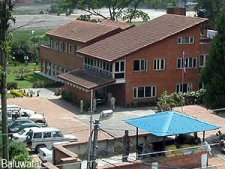 Nagarjung Palace: One way to use a royal summer home is to house a former king within its walls. Although King Gyanendra of Nepal won’t be playing around here, at least he has a roof over his head. And, he can dream about all the former summers he spent at Nagarjung Palace. King Gyanendra of Nepal was dethroned in May 2008 by this country’s new Constitutuent Assembly, which abolished the Asian monarchy and declared Nepal a republic. Officials met with Gyanendra in June, and the former King asked the new government to find alternative accommodation as his former home was occupied by his son and his family. The Cabinet decided to allow Gyanendra to move to Nagarjung Palace, which is situated on a forested hill on the edge of Katnamdu. Gyanendra used Nagarjung palace as his summer home, as it is surrounded by walls and has remained off-limits to the public. The palace has been nationalized by the new government along with most of the royal assets. It’s unknown how long Gyanendra will remain at the summer palace, or if the public will be able to view the inside of this vacation home in the near future. The monarchy’s end was the culmination of a two-year peace process that saw communist insurgents give up their armed struggle, join mainstream politics and win the most seats in April elections.
Nagarjung Palace: One way to use a royal summer home is to house a former king within its walls. Although King Gyanendra of Nepal won’t be playing around here, at least he has a roof over his head. And, he can dream about all the former summers he spent at Nagarjung Palace. King Gyanendra of Nepal was dethroned in May 2008 by this country’s new Constitutuent Assembly, which abolished the Asian monarchy and declared Nepal a republic. Officials met with Gyanendra in June, and the former King asked the new government to find alternative accommodation as his former home was occupied by his son and his family. The Cabinet decided to allow Gyanendra to move to Nagarjung Palace, which is situated on a forested hill on the edge of Katnamdu. Gyanendra used Nagarjung palace as his summer home, as it is surrounded by walls and has remained off-limits to the public. The palace has been nationalized by the new government along with most of the royal assets. It’s unknown how long Gyanendra will remain at the summer palace, or if the public will be able to view the inside of this vacation home in the near future. The monarchy’s end was the culmination of a two-year peace process that saw communist insurgents give up their armed struggle, join mainstream politics and win the most seats in April elections. Necker Island: Before Sir Richard Branson became a “Sir,” he visited the British Virgin Islands to investigate real estate for his rock stars signed to his then new Virgin Label. Necker Island was the final island on his list, and he made such a lowball bid on the £3 million price tag for this 74-acre piece of real estate that he was evicted from the island. But, the owner, Lord Cobham, eventually settled for £180,000. Within three years and for $10 million, Branson built a 10-bedroom Balinese-style villa that crowns a hill above the beach. Each of the ten bedrooms contains open walls that provide a 360-degree view and cooling winds from any direction within the house. Built from local stone and Brazilian hardwoods, the retreat is decorated with antiques, art and bamboo furniture from Bali. With accommodations for up to 28 people, the entire resort rents for $47,000 per day. Famous figures who have stayed at Branson’s resort include the late Princess Diana, former British Prime Minister Tony Blair, Janet Jackson, Harrison Ford, Eddie Murphy and Oprah Winfrey. If you want to visit the island you can find a way to join a legitimate scientific expedition to study a rare species of gecko, which has full and unfettered access to the island. You can reach Necker via San Juan (Puerto Rico), St Thomas, Antigua or Barbados followed by a connecting flight to Beef Island, Tortola. From Beef Island there’s a 30-minute transfer via the Necker Island private launch. Necker Island currently is one of eight getaways now owned by Virgin Limited Edition
Necker Island: Before Sir Richard Branson became a “Sir,” he visited the British Virgin Islands to investigate real estate for his rock stars signed to his then new Virgin Label. Necker Island was the final island on his list, and he made such a lowball bid on the £3 million price tag for this 74-acre piece of real estate that he was evicted from the island. But, the owner, Lord Cobham, eventually settled for £180,000. Within three years and for $10 million, Branson built a 10-bedroom Balinese-style villa that crowns a hill above the beach. Each of the ten bedrooms contains open walls that provide a 360-degree view and cooling winds from any direction within the house. Built from local stone and Brazilian hardwoods, the retreat is decorated with antiques, art and bamboo furniture from Bali. With accommodations for up to 28 people, the entire resort rents for $47,000 per day. Famous figures who have stayed at Branson’s resort include the late Princess Diana, former British Prime Minister Tony Blair, Janet Jackson, Harrison Ford, Eddie Murphy and Oprah Winfrey. If you want to visit the island you can find a way to join a legitimate scientific expedition to study a rare species of gecko, which has full and unfettered access to the island. You can reach Necker via San Juan (Puerto Rico), St Thomas, Antigua or Barbados followed by a connecting flight to Beef Island, Tortola. From Beef Island there’s a 30-minute transfer via the Necker Island private launch. Necker Island currently is one of eight getaways now owned by Virgin Limited Edition Paleis Het Oude Loo: Het Oude Loo is not a palace as much as a “Lust-hof,” or retreat, located near Apeldoorn, Netherlands in Europe. Now owned by the state, the former royal residence was built starting in 1684 for Stadtholder William III and his consort, Mary II of England. For over three hundred years, Het Loo was the summer residence of the House of Orange-Nassau, which became the Dutch royal family. Queen Wilhelmina declared that when she died the palace would go to the State, and it did in 1962 when Wilhelmina died at this retreat. After a thorough restoration, Het Loo now houses a national museum and library devoted to the House of Orange-Nassau in Dutch history and its gardens recently have been renovated to match earlier representation. Yet, Het Loo remains habitable, as evidenced by the use of the palace by Japanese royalty who are close friends to the royal family of Netherlands. Japanese Emperor Akihito and Empress Michiko visited the Netherlands in October 1979 and May 2000 and stayed at the Het Oude Loo castle on both occasions. In the latest known visit, Japanese Crown Prince Naruhito and his family, on a two-week private trip to the Netherlands in 2006, visited former royal stables with Queen Beatrix and her family and stayed at Het Loo. This summer home is worth a visit by anyone who is interested in architecture, gardening and history. You can visit the park all year round, but the area around the castle is open only a few months a year.
Paleis Het Oude Loo: Het Oude Loo is not a palace as much as a “Lust-hof,” or retreat, located near Apeldoorn, Netherlands in Europe. Now owned by the state, the former royal residence was built starting in 1684 for Stadtholder William III and his consort, Mary II of England. For over three hundred years, Het Loo was the summer residence of the House of Orange-Nassau, which became the Dutch royal family. Queen Wilhelmina declared that when she died the palace would go to the State, and it did in 1962 when Wilhelmina died at this retreat. After a thorough restoration, Het Loo now houses a national museum and library devoted to the House of Orange-Nassau in Dutch history and its gardens recently have been renovated to match earlier representation. Yet, Het Loo remains habitable, as evidenced by the use of the palace by Japanese royalty who are close friends to the royal family of Netherlands. Japanese Emperor Akihito and Empress Michiko visited the Netherlands in October 1979 and May 2000 and stayed at the Het Oude Loo castle on both occasions. In the latest known visit, Japanese Crown Prince Naruhito and his family, on a two-week private trip to the Netherlands in 2006, visited former royal stables with Queen Beatrix and her family and stayed at Het Loo. This summer home is worth a visit by anyone who is interested in architecture, gardening and history. You can visit the park all year round, but the area around the castle is open only a few months a year. Sofiero Palace: This palace represents a royal retreat that has been given to the state, while the current royals in Sweden look to other resources for relaxation. Sofiero Palace was King Gustav VI Adolf’s summer residence throughout his adult life, and he bequeathed Sofiero to Helsingborg Municipality in his will in 1973 after he created one of the most spectacular rhododendron collections at this estate. Few Swedish palaces can boast a more beautiful European setting. Today, there are over 10,000 rhododendron bushes of 300 varieties and just as many hybrids on the grounds. In recent years, the park has hosted a wide range of events, including open-air concerts, garden displays, exhibitions, courses and craft fairs. The current King of Sweden, His Majesty Carl XVI Gustaf, is the grandson of King Gustav VI Adolf, and he became the heir apparent when his father died in an airplane crash one year after the he was born. King Carl XVI Gustaf is most well known as the presenter of the Nobel Prizes each year. He and his family tend to travel to various locations for their ‘play’ rather than to retreat to a summer palace. With that said, visitors to Sofiero often can bump into royalty when they attend gallery openings or other events held at this palace.
Sofiero Palace: This palace represents a royal retreat that has been given to the state, while the current royals in Sweden look to other resources for relaxation. Sofiero Palace was King Gustav VI Adolf’s summer residence throughout his adult life, and he bequeathed Sofiero to Helsingborg Municipality in his will in 1973 after he created one of the most spectacular rhododendron collections at this estate. Few Swedish palaces can boast a more beautiful European setting. Today, there are over 10,000 rhododendron bushes of 300 varieties and just as many hybrids on the grounds. In recent years, the park has hosted a wide range of events, including open-air concerts, garden displays, exhibitions, courses and craft fairs. The current King of Sweden, His Majesty Carl XVI Gustaf, is the grandson of King Gustav VI Adolf, and he became the heir apparent when his father died in an airplane crash one year after the he was born. King Carl XVI Gustaf is most well known as the presenter of the Nobel Prizes each year. He and his family tend to travel to various locations for their ‘play’ rather than to retreat to a summer palace. With that said, visitors to Sofiero often can bump into royalty when they attend gallery openings or other events held at this palace. The Glass Villa (Camli Kösk): Turkish presidents reside in the Çankaya Palace (shown at left), which takes its name from Ankara’s Çankaya district in the south of the capital. The palace, which was first used by Atatürk, has an important place in the history of Turkish politics. The compound, which has been enlarged in time with additional buildings and facilities, covers an area of over 400 acres. Designed by Seyfi Arkan, a Turkish architect, as a single-story modern residence during the mid 1930s, the Glass Villa is part of this compound and has served as a residence for Prime Ministers and Speakers of the Republican Senate until 1970. Through the years, the Glass Villa was extensively modified and extended, the latest having been completed in 1996. Since then, it serves again as a guest house for visiting heads of states as it once did in the 1950s. Although uncertain, we believe this may be the building where Queen Elizabeth II stayed on her recent visit to Ankara. Outside Ankara, Turkey has laid out the welcome mat country-wide to royals who wish to support Turkey’s bid to join the European Union (EU). So far as the West is concerned, Turkey can be said to be the most successful example of a Muslim country which has embraced democracy. Turkey closed its first chapter of negotiations with the EU in June 2006, and in May 2008, Queen Elizabeth II made her first visit to Turkey in 37 years. Despite France’s opposition to these developments, the French beauty, Marie Cavallier, joined Prince Joachim of Denmark in Turkey for a romantic getaway in summer 2007, where he proposed to her on bended knee. No matter if it’s Ankara, Bursa, Istanbul or some unknown hideaway, expect to hear about some royal getaway or real estate purchase news from this country over the upcoming seasons. The earliest date that Turkey could enter the EU, by the way, is 2013.
The Glass Villa (Camli Kösk): Turkish presidents reside in the Çankaya Palace (shown at left), which takes its name from Ankara’s Çankaya district in the south of the capital. The palace, which was first used by Atatürk, has an important place in the history of Turkish politics. The compound, which has been enlarged in time with additional buildings and facilities, covers an area of over 400 acres. Designed by Seyfi Arkan, a Turkish architect, as a single-story modern residence during the mid 1930s, the Glass Villa is part of this compound and has served as a residence for Prime Ministers and Speakers of the Republican Senate until 1970. Through the years, the Glass Villa was extensively modified and extended, the latest having been completed in 1996. Since then, it serves again as a guest house for visiting heads of states as it once did in the 1950s. Although uncertain, we believe this may be the building where Queen Elizabeth II stayed on her recent visit to Ankara. Outside Ankara, Turkey has laid out the welcome mat country-wide to royals who wish to support Turkey’s bid to join the European Union (EU). So far as the West is concerned, Turkey can be said to be the most successful example of a Muslim country which has embraced democracy. Turkey closed its first chapter of negotiations with the EU in June 2006, and in May 2008, Queen Elizabeth II made her first visit to Turkey in 37 years. Despite France’s opposition to these developments, the French beauty, Marie Cavallier, joined Prince Joachim of Denmark in Turkey for a romantic getaway in summer 2007, where he proposed to her on bended knee. No matter if it’s Ankara, Bursa, Istanbul or some unknown hideaway, expect to hear about some royal getaway or real estate purchase news from this country over the upcoming seasons. The earliest date that Turkey could enter the EU, by the way, is 2013. Whisper Bay: This new and exclusive development represents the typical resort that is replacing summer palaces and homes for many royals and celebrities. Located in Airlie Beach, near Queensland, Australia, this area – together with adjacent Shute Harbour – provides one of the embarkation points for both the Whitsunday Islands and the Great Barrier Reef. Airlie Beach, has appealed to backpackers for years, so it historically has been a relaxed and low-key tourist destination. But, this feel is changing rapidly, thanks to developers such as Rory O’Brien’s $280 million-dollar Whisper Bay project. A horde of the rich and famous, who use jets and sails to travel to and from this resort, have bought into O’Brien’s development among other exclusive development enclaves located in this area. Airlee Beach residents and visitors now see the likes of Scottish actor Sean Connery, former Dreamworld boss John Longhurst, ex-league rugby star Matthew Johns, former Prime Minister Bob Hawke, and shipping multimillionaire Owen Glenn as they enjoy the area’s relaxing amenities. As a side note, Airlee Beach really doesn’t contain a beach – but it does sport a man-made lagoon.
Whisper Bay: This new and exclusive development represents the typical resort that is replacing summer palaces and homes for many royals and celebrities. Located in Airlie Beach, near Queensland, Australia, this area – together with adjacent Shute Harbour – provides one of the embarkation points for both the Whitsunday Islands and the Great Barrier Reef. Airlie Beach, has appealed to backpackers for years, so it historically has been a relaxed and low-key tourist destination. But, this feel is changing rapidly, thanks to developers such as Rory O’Brien’s $280 million-dollar Whisper Bay project. A horde of the rich and famous, who use jets and sails to travel to and from this resort, have bought into O’Brien’s development among other exclusive development enclaves located in this area. Airlee Beach residents and visitors now see the likes of Scottish actor Sean Connery, former Dreamworld boss John Longhurst, ex-league rugby star Matthew Johns, former Prime Minister Bob Hawke, and shipping multimillionaire Owen Glenn as they enjoy the area’s relaxing amenities. As a side note, Airlee Beach really doesn’t contain a beach – but it does sport a man-made lagoon.
10 Most Beautiful, Unique and Amazing Celebrity Homes
Posted in Features on May 28, 2008A few weeks ago, we introduced you to what we considered the Top 10 Ridiculous, Obnoxious, and Just Plain Ugly Celebrity Houses. Now, we’re going to do an about-face and show you the homes we believe to be the top ten most beautiful, amazing and unique celebrity homes. While some homes on this list teeter on the border of obnoxious, even the most expensive or largest homes have been saved by tasteful touches. We were not surprised to discover that the most beautiful homes were those that were modest, that seemed to fit into their surroundings, and that supplied just enough panache for each celebrity to call that house a “home.”
The list below is in no particular order. While the home sites are numbered, the numbering does not indicate that we favor one home over another or that they are listed in order of value.
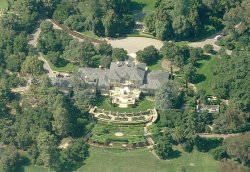 Oprah Winfrey: This home, located in Santa Barbara, California, belongs to Oprah Winfrey. The property covers approximately forty-two acres and the house is 23,000 square feet. It has six bedrooms, fourteen bathrooms, ten fireplaces and a home theater. Oprah added a man-made lake stocked with rare fish and she had local Montecito sandstone bricks hand-laid into a quarter-mile long driveway. Although this house is nicknamed, “Oprah’s Hearst Castle,” we like it because of the landscaping, which is meticulous. To Oprah’s credit, this property contains the largest amount of green space in Santa Barbara. Its balanced elegance reminds us somewhat of the famous historic Biltmore estates located in Ashland, North Carolina.
Oprah Winfrey: This home, located in Santa Barbara, California, belongs to Oprah Winfrey. The property covers approximately forty-two acres and the house is 23,000 square feet. It has six bedrooms, fourteen bathrooms, ten fireplaces and a home theater. Oprah added a man-made lake stocked with rare fish and she had local Montecito sandstone bricks hand-laid into a quarter-mile long driveway. Although this house is nicknamed, “Oprah’s Hearst Castle,” we like it because of the landscaping, which is meticulous. To Oprah’s credit, this property contains the largest amount of green space in Santa Barbara. Its balanced elegance reminds us somewhat of the famous historic Biltmore estates located in Ashland, North Carolina.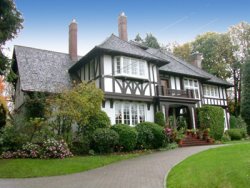 Kurt Russell and Goldie Hawn: Actors Goldie Hawn and Kurt Russell moved to Vancouver, Canada to support their son’s fledgling hockey career. This home, a Tudor-style creation located in the Shaughnessy area, is now on the market again and listed at $5.4 million Canadian. It contains five bedrooms and eleven fireplaces, a gym and a built-in theater room, and the house sports a grand oak paneled entrance hall with fireplace, two dens, new kitchen, private yard and a separate coach house. There is a formal living room and separate dining room, a conservatory, and the master suite contains a separate dressing area. The couple purchased the home in 2002 for $2,995,000, or $1,875,000 US dollars, and its charm and settings make the grade for this list.
Kurt Russell and Goldie Hawn: Actors Goldie Hawn and Kurt Russell moved to Vancouver, Canada to support their son’s fledgling hockey career. This home, a Tudor-style creation located in the Shaughnessy area, is now on the market again and listed at $5.4 million Canadian. It contains five bedrooms and eleven fireplaces, a gym and a built-in theater room, and the house sports a grand oak paneled entrance hall with fireplace, two dens, new kitchen, private yard and a separate coach house. There is a formal living room and separate dining room, a conservatory, and the master suite contains a separate dressing area. The couple purchased the home in 2002 for $2,995,000, or $1,875,000 US dollars, and its charm and settings make the grade for this list.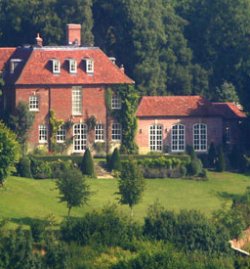 Madonna: This pop-singer icon made a bid on Ashcombe, the former home of late photographer Cecil Beaton, in 2001. Friends including Rex Whistler, Salvador Dali and Augustus John returned Beaton’s hospitality by painting murals in the house. Located in Wiltshire, England, this 1,200-acre carried a guide price of £9 million. This was the first time that Ashcombe had been for sale on the open market since the First World War. It is an exceptionally private house, hidden in its own valleys which contain one of the country’s best shoots. The pop star learned how to fish, hunt and ride horses, so this home seemed to fit Madonna to a “T” in 2001. The couple also owns a mansion in London, and the Wiltshire property is within easy reach and close to the Wiltshire estate of Sting and his wife, Trudie Styler. They are close friends of the singer and first introduced her to her husband, Guy Ritchie. It appears recently, however, that Madonna has put Aschombe on the market again, this time to the tune of £12 million.
Madonna: This pop-singer icon made a bid on Ashcombe, the former home of late photographer Cecil Beaton, in 2001. Friends including Rex Whistler, Salvador Dali and Augustus John returned Beaton’s hospitality by painting murals in the house. Located in Wiltshire, England, this 1,200-acre carried a guide price of £9 million. This was the first time that Ashcombe had been for sale on the open market since the First World War. It is an exceptionally private house, hidden in its own valleys which contain one of the country’s best shoots. The pop star learned how to fish, hunt and ride horses, so this home seemed to fit Madonna to a “T” in 2001. The couple also owns a mansion in London, and the Wiltshire property is within easy reach and close to the Wiltshire estate of Sting and his wife, Trudie Styler. They are close friends of the singer and first introduced her to her husband, Guy Ritchie. It appears recently, however, that Madonna has put Aschombe on the market again, this time to the tune of £12 million.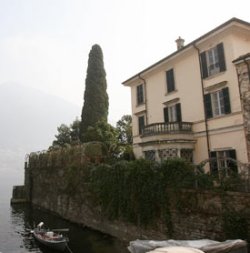 George Clooney: This sexy and talented actor purchased this 25-room Italian villa in 2001. Known as Villa Oleandra, it is said to contain an outdoor theater, a large swimming pool and a garage for Clooney’s motorcycles. Italian journalists and tourists swarmed to the small town of Laglio, where this villa is located, when they heard rumors that Brad Pitt and Angelina Jolie would wed at pal George Clooney’s lakeside estate. Clooney has some illustrious neighbors as well – designer Donatella Versace owns a home on Lake Como near the burial place of her late brother Gianni. Singer Avril Lavigne and husband Deryck Whimbey honeymooned in Lake Como a few years ago as well. Clooney really admires this home and says, “I go there whenever I can. It’s where I wrote Good Night And Good Luck and where I finished the script for Leatherheads. It’s a really peaceful place to go and write.” Catherine Zeta-Jones and Michael Douglas are regular guests at the mansion, where Clooney also shot scenes for the film, Ocean’s Twelve.
George Clooney: This sexy and talented actor purchased this 25-room Italian villa in 2001. Known as Villa Oleandra, it is said to contain an outdoor theater, a large swimming pool and a garage for Clooney’s motorcycles. Italian journalists and tourists swarmed to the small town of Laglio, where this villa is located, when they heard rumors that Brad Pitt and Angelina Jolie would wed at pal George Clooney’s lakeside estate. Clooney has some illustrious neighbors as well – designer Donatella Versace owns a home on Lake Como near the burial place of her late brother Gianni. Singer Avril Lavigne and husband Deryck Whimbey honeymooned in Lake Como a few years ago as well. Clooney really admires this home and says, “I go there whenever I can. It’s where I wrote Good Night And Good Luck and where I finished the script for Leatherheads. It’s a really peaceful place to go and write.” Catherine Zeta-Jones and Michael Douglas are regular guests at the mansion, where Clooney also shot scenes for the film, Ocean’s Twelve.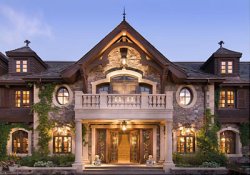 Joel Horowitz: The co-founder for Tommy Hilfiger found his home – named Tranquility – in Lake Tahoe, Nevada. This home, conveniently located on the tax-free side of Lake Tahoe, contains a 20,000-square-foot main house that is modeled after a northern European mountain home. It also contains a 3,500-bottle wine cellar, an indoor swimming pool and an atrium as well as a 19-seat movie theater. It also boasts nine bedrooms, fourteen full and five half-baths, a private lake with docks and two par-three golf holes. While this home could be called “ostentatious,” it carries a glamor reminiscent of Europe. The living room features a double-height ceiling adorned with carved beams, large windows at one apse-like end and hand-carved antique fireplaces. The dining room’s floor dates back to the 17th century, and was salvaged from a French chateau. Its ceilings are hand-painted, not with Old World themes, but images of animals indigenous to Lake Tahoe. Want to purchase the home? It’s on the market again for a cool $100 million.
Joel Horowitz: The co-founder for Tommy Hilfiger found his home – named Tranquility – in Lake Tahoe, Nevada. This home, conveniently located on the tax-free side of Lake Tahoe, contains a 20,000-square-foot main house that is modeled after a northern European mountain home. It also contains a 3,500-bottle wine cellar, an indoor swimming pool and an atrium as well as a 19-seat movie theater. It also boasts nine bedrooms, fourteen full and five half-baths, a private lake with docks and two par-three golf holes. While this home could be called “ostentatious,” it carries a glamor reminiscent of Europe. The living room features a double-height ceiling adorned with carved beams, large windows at one apse-like end and hand-carved antique fireplaces. The dining room’s floor dates back to the 17th century, and was salvaged from a French chateau. Its ceilings are hand-painted, not with Old World themes, but images of animals indigenous to Lake Tahoe. Want to purchase the home? It’s on the market again for a cool $100 million.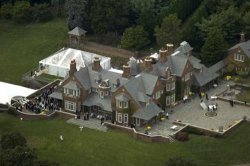 Jerry Seinfeld: Comedian Jerry Seinfeld purchased this lavish and luscious East Hampton, New York estate from rocker Billy Joel for the then record-setting price of $32 million in 2000. According to the magazine, OK!, this home beat out properties own by Donald Trump, Sir Elton John, and even George Clooney’s Italian villa noted above for the number one celebrity palace in 2007. This home has been described as a “magnificent Tudor-style waterfront manor … sited on over 14 acres of rolling lawns and naturalized landscaping. There are three buildings total with a sum of twenty-four rooms, including eight full baths and five half-baths. There are thirteen fireplaces, a gym, indoor and outdoor pools, a gourmet kitchen, a tennis court, a bowling alley, a guest cottage, a music room, a smoking bar and a wine cellar. Annual taxes are $208,463.
Jerry Seinfeld: Comedian Jerry Seinfeld purchased this lavish and luscious East Hampton, New York estate from rocker Billy Joel for the then record-setting price of $32 million in 2000. According to the magazine, OK!, this home beat out properties own by Donald Trump, Sir Elton John, and even George Clooney’s Italian villa noted above for the number one celebrity palace in 2007. This home has been described as a “magnificent Tudor-style waterfront manor … sited on over 14 acres of rolling lawns and naturalized landscaping. There are three buildings total with a sum of twenty-four rooms, including eight full baths and five half-baths. There are thirteen fireplaces, a gym, indoor and outdoor pools, a gourmet kitchen, a tennis court, a bowling alley, a guest cottage, a music room, a smoking bar and a wine cellar. Annual taxes are $208,463.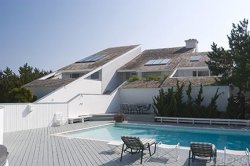 William Zysblat: William Zysblat recently purchased this modern beauty located in East Quogue, New York. Zysblat’s company, RZO Productions, has handled business and management affairs for rock icons U2, David Bowie, The Police and the Rolling Stones among others. The sale of the oceanfront post modern home on Dune Road closed in December for $6.2 million. The asking price for the 3,200 sq ft dwelling had been $6.7 million. The property includes 166 feet of ocean frontage on 2.5 acres. The home was designed by Quogue-based architect Jay Sears, and has a heated gunite pool, guest house, and tennis and bocce courts.
William Zysblat: William Zysblat recently purchased this modern beauty located in East Quogue, New York. Zysblat’s company, RZO Productions, has handled business and management affairs for rock icons U2, David Bowie, The Police and the Rolling Stones among others. The sale of the oceanfront post modern home on Dune Road closed in December for $6.2 million. The asking price for the 3,200 sq ft dwelling had been $6.7 million. The property includes 166 feet of ocean frontage on 2.5 acres. The home was designed by Quogue-based architect Jay Sears, and has a heated gunite pool, guest house, and tennis and bocce courts.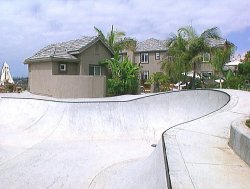 Tony Hawk: Tony Hawk shoveled his profits from professional skateboarding and gaming into this modest 5,000 square-foot home with a 4,000 square-foot skate park in Carlsbad, California. He grew frustrated from begin hassled by fans at public parks, so he added this unique skateboarding feature to his home. It comes complete with a rail, a center pyramid and a ledge that serves as a bench. Other outdoor features include a basketball court and a pool. Inside you’d find about $150,000 worth of gaming electronics hooked to a 65-inch plasma HDTV. Sounds like Hawk lives his work – all skateboard and video games. And, although this home seems a bit on the stark side, Hawk has made it his home. That, in our book, is truly amazing for any celebrity.
Tony Hawk: Tony Hawk shoveled his profits from professional skateboarding and gaming into this modest 5,000 square-foot home with a 4,000 square-foot skate park in Carlsbad, California. He grew frustrated from begin hassled by fans at public parks, so he added this unique skateboarding feature to his home. It comes complete with a rail, a center pyramid and a ledge that serves as a bench. Other outdoor features include a basketball court and a pool. Inside you’d find about $150,000 worth of gaming electronics hooked to a 65-inch plasma HDTV. Sounds like Hawk lives his work – all skateboard and video games. And, although this home seems a bit on the stark side, Hawk has made it his home. That, in our book, is truly amazing for any celebrity.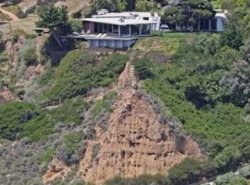 Brad Pitt: We chose Brad Pitt and his home(s) for several reasons. First, although this cliffside home isn’t shabby (worth about $4.5 million), it is just one piece of the Pitt puzzle. When you compare this home to their modest 1830s New Orleans dwelling, the cliffside home takes on a new perspective. This house is unusual, just like the house in the New Orleans that was damaged by Hurricane Katrina. Not to say that the home in Louisiana was inexpensive – it’s located near the French Quarter, and Pitt paid $3.5 million in cash on January 2, 2007, for the right to live there. According to the news story, “A real estate listing for the property shows the house has a grand spiral staircase, elevator, gourmet kitchen, a large private courtyard and a separate two-story guest house. It also has private parking for two cars – a luxury in the French Quarter.” Of course, it was a matter of convenience as well, as Pitt was filming The Curious Case of Benjamin Button in Louisiana last year. And, in the process, he’s also overseer of the housing project in storm-ravaged lower Ninth Ward in New Orleans. This effort, in our opinion, is a mighty one indeed. In contrast to his isolated home in California, Brad and his consort, Angelina Jolie, appear to be good southern neighbors in a busy and famous neighborhood.
Brad Pitt: We chose Brad Pitt and his home(s) for several reasons. First, although this cliffside home isn’t shabby (worth about $4.5 million), it is just one piece of the Pitt puzzle. When you compare this home to their modest 1830s New Orleans dwelling, the cliffside home takes on a new perspective. This house is unusual, just like the house in the New Orleans that was damaged by Hurricane Katrina. Not to say that the home in Louisiana was inexpensive – it’s located near the French Quarter, and Pitt paid $3.5 million in cash on January 2, 2007, for the right to live there. According to the news story, “A real estate listing for the property shows the house has a grand spiral staircase, elevator, gourmet kitchen, a large private courtyard and a separate two-story guest house. It also has private parking for two cars – a luxury in the French Quarter.” Of course, it was a matter of convenience as well, as Pitt was filming The Curious Case of Benjamin Button in Louisiana last year. And, in the process, he’s also overseer of the housing project in storm-ravaged lower Ninth Ward in New Orleans. This effort, in our opinion, is a mighty one indeed. In contrast to his isolated home in California, Brad and his consort, Angelina Jolie, appear to be good southern neighbors in a busy and famous neighborhood.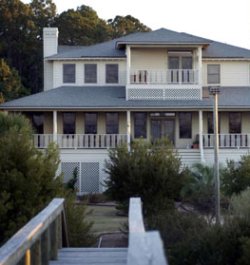 Sandra Bullock: This home is the quintessential Tybee Island, Georgia beauty. Actress Sandra Bullock spent more than one million dollars to purchase this modest three-story home on the north end of the island in 2001. She also purchased empty lots on either side of the home to protect her privacy. She reportedly owns homes in Southern California, Jackson Hole, Wyoming and in Austin, Texas as well. Bullock bought the home after filming Forces of Nature. The island faces the Savannah river inlet east of Savannah where portions of the movie where filmed.
Sandra Bullock: This home is the quintessential Tybee Island, Georgia beauty. Actress Sandra Bullock spent more than one million dollars to purchase this modest three-story home on the north end of the island in 2001. She also purchased empty lots on either side of the home to protect her privacy. She reportedly owns homes in Southern California, Jackson Hole, Wyoming and in Austin, Texas as well. Bullock bought the home after filming Forces of Nature. The island faces the Savannah river inlet east of Savannah where portions of the movie where filmed.
The Foreclosure Investing Web Guide: 100 Useful Resources
Posted in Features on May 13, 2008There seems to be no end to the number of foreclosure opportunities for investors these days. In keeping with this trend, a number of Web sites have been created to serve the foreclosure investor. To that end, we’ve listed 100 sites below, from tutorials to databases to articles and blogs. Although some sites are more useful than others, we’ve tried to avoid sites that offer no value to the investor whatsoever. These include databases listings without a clue as to who offers these databases and Web sites that offer advice without credentials. With that said, we may have missed a site or two that may truly be useful. If you know of a site that provides value to the foreclosure investor, let us know through your comments.
The list below is in no particular order, but each link is listed alphabetically under the provided categories. While the sites are numbered, the numbering does not indicate that we favor one site over another or that they are listed in order of value.
Tutorials
Few deep tutorials on how to purchase foreclosed property as an investment exist online. However, the basics are all anyone needs to hunt for further information. Remember that each state carries specific laws that relate to purchasing foreclosures, so be sure to check with local resources before you make a decision to invest in a foreclosure.
- About Buying HUD Homes: Straight from the U.S. Department of Housing and Urban Development (HUD) to you – a guide on how to buy a 1 to 4 unit residential property acquired by HUD as a result of a foreclosure action on an FHA-insured mortgage.
- Buy Bank Homes: BuyBankHomes (BBH) and Real Estate Fortune, LLC have teamed up to offer BBH members the training and resources they need to have a competitive edge in today’s fast paced real estate market. This company provides distance coaching using the phone and Internet, and they offer a premier 90-Day Challenge Training live three times per year. They also offer a special “One-on-One Personal Mentorship Program.” You choose the training program that is the best fit for you.
- Buying a Home in Foreclosure – The Basics: Foreclosure City offers a down-to-earth tutorial tht leads into more advanced topics and articles, including their Foreclosure Buying Toolkit.
- Home Buying Institute: This site offers great advice for first-time home buyers, and this linked portion provides basics on how to purchase foreclosures.
- Free Foreclosure Tutorial: This document, among others listed on this page, are free to download and read.
- Foreclosure Free Research: A list of Q&A about foreclosure investment properties. If you can get past the Q&A on how to use this site, the questions are appropriate and the answers are short and sweet.
- Foreclosure University: Although you’ll pay to take this course, the Web site is filled with plenty of free information, including individual state foreclosure laws, foreclosure listings for each state, free reports and articles and a glossary of foreclosure-related terms.
- MSN Guide: This article explains the safest way to purchase foreclosures.
- Realty Store Foreclosure Tutorial: The purpose of this tutorial is to provide an overview of the foreclosure process and to help you get started in achieving your real estate dreams.
- Realty Trac Foreclosure Tutorial: This tutorial explains the do’s and don’ts when considering a foreclosure list.
- Ways to Buy Foreclosed Property: U.S. News offers information about three keys ways to purchase foreclosed property.
Articles
Sometimes the investor can find further information about how to invest in foreclosures by reading recent articles about this topic. The following articles were chosen because of their relevance in content and to current market conditions, as each one was written since January 2007.
- As foreclosures widen, a neighborhood erodes: This article that ran in the Boston Globe offers one perspective about what happens in neighborhoods where foreclosures have run rampant. This is just one perspective to keep in mind when investing in foreclosure properties.
- AOL Foreclosure Topics: AOL has a new beta real estate section, and this article is just one of a developing course of articles provided by this site. Look in the right column of this linked article to find more information about foreclosure.
- Before you Attend a Foreclosure Investment Workshop: Foreclosure workshops are springing up all over the country, and this article can help you save time and money if you plan to attend one of these events.
- Buying Bank Owned Properties (REO): REO (Real Estate Owned) si a property that goes back to the mortgage company after an unsuccessful foreclosure auction. Walt Harvey, a Realtor located in Hawaii, offers his advice about this type of investment possibility.
- Discounted Homes, Going, Going…: This piece on auctions covers more of the discount prices one might expect when attending one of these events.
- Foreclosure Articles: This list at Ezine provides the investor with a plethora of articles abotu foreclosure investment possibilities written by a number of experts in real estate and in foreclosure properties.
- Foreclosures hit some cities harder than others: This MSNBC article explains why some areas seem to be floating through this mortgage meltdown and why others are hit hard by foreclosures. The article may give you a clue as to where to look for your foreclosure investment opportunity.
- Foreclosure Investment Nightmare: This article provides one example of why it’s important to talk with an independent, licensed real estate agent before investing in any foreclosure property or program.
- Foreclosures slam doors on pets, too: Make sure the dog or cat doesn’t come with the property unless you want a foreclosed pet as well as a foreclosure investment.
- Foreclosures up 75% in 2007: This article by CNN Money states that total foreclosure filings soared 97% in December 2007 alone compared with December of 2006. You’ll also learn about the states that have the least foreclosure filings from this article.
- House Auctions and Foreclosure Sales: Not all auctions are intended solely for foreclosure properties. This article provides some insight into why auctions are used to sell homes.
- How Foreclosures Work: Elizabeth Weintraub, who has more than 600 hours of real estate education, offers advice for the first-time foreclosure buyer.
- Investing in Preforeclosures: Bankrate.com provides a concise article that explains preforeclosures as investment opportunities.
- Notes from a Foreclosure Auction: A great article about an auction for foreclosures in Chicago provides readers with some sense of what to expect when attending these events.
- Preforeclosure Flipping – the Key to Real Estate Riches: Some advice from Real Estate ABC on how to attempt a preforeclosure investment.
- Real Estate Exchanging – an option to pre-foreclosure: The desire for new home ownership has, in the past few years, brought new problems into the real estate industry. It has also brought some solutions. Read this article about making an exchange as an option for foreclosure for the seller.
- Real Estate Investment Articles: This list of articles focuses solely on foreclosure properties, and they’re written by a number of different authors.
- Tips from a Foreclosure Investor: According to Ralph Roberts, author of “Foreclosure Investing For Dummies,” the best prospect for a foreclosure investor is “someone with a secure job, solid cash flow and lots of cash on hand — someone who wants to make some money on the side.” This and more in this interview in the Washington Post.
Websites
The following links will take you to all-inclusive sites that focus entirely on foreclosure investment opportunities, or to investment sites that have reserved entire sections for foreclosures. Some sites may carry blogs, discussion boards, tutorials and more.
- All Foreclosure Information: When this site says, “All,” it means all. You can find tutorials, information about preforeclosures, foreclosures, auctions, listings and more at this site.
- Bank and Government Foreclosures: This site focuses on bank-owned and government properties. They offer tutorials, listings, articles and more that focus on foreclosures, no matter the source.
- Bigger Pockets Foreclosures: This link will take you to just one article about foreclosures at Bigger Pockets. Search through the menu at left on this page for more foreclosure information. The forums on this site also carry foreclosure-specific topics.
- Foreclosure Connections: With over a decade of practical experience in the foreclosure real estate industry, ForeclosureConnections.com draws on contacts in all areas of the industry to provide our members with listings from all kinds of diverse sources, including mortgage brokers, lending banks, county and state registrars, and government agencies like HUD and FHA. But ForeclosureConnections.com is more than just another listings service, as this site provides news, market updates, detailed articles, tips and advice on investing in foreclosure property.
- Foreclosure Data Online: Search through articles, foreclosure listings by state, tutorials, a blog and more at this site.
- Foreclosure Databank: ForeclosureDataBank.com was established in 1998 as a one-stop source for information on regional foreclosure markets and listings for buyers interested in purchasing foreclosure homes for investment or as primary residences. Although the focus is on listings, this site provides users with tutorials, tools, a discussion board, news and more to help stay on top of the foreclosure investment market.
- Foreclosure Fetcher: Unlike other foreclosure database sites, this site is upfront about their seven-day free trial. So users know on the front end that the service will cost some money. This site also is a bit more comprehensive, adding tutorials, foreclosure tools such as a home value checker and a mortgage calculator, and a blog.
- Foreclosure Store: Although the services here are free, the user must register first to gain access to user guides, listings, training, and foreclosure investment tools. Information about listings are available to members only.
- Foreclosure.com: This site is more for experienced investors. You can find listings for anything other than auctions, but you’ll discover few articles and no tutorials here.
- Foreclosures.com: Learn how to invest in foreclosures through the kearning tools and expert help provided at this site. This site also carries foreclosure listings.
- Government Repo Homes: This site offers more than listings by state, it also offers articles, news, resources and data for investors who want to pursue homes that have been repossessed by the government.
- National Foreclosures: For nearly fifteen years this company has provided asset managers and private money lenders with a turnkey service for quick property disposal. They offer services such as property valuation, rehabilitation and security, marketing preparation for re-entry into the resale marketplace by our network of pre-screened local Bank REO Specialists and more. This site also offers an affiliate program.
- RealtyTrac Foreclosures: RealtyTrac has a foreclosure niche that’s difficult to beat. They offer listings, tutorials, and users can chat with a customer service representative. This site is geared toward all levels of investors.
- The Realty Store: The RealtyStore provides foreclosure information for all types of users. Their listings are similar to RealtyTrac, but you must register to peruse their offerings. On the plus side, this site contains some useful tutorials, but it’s fairly difficult to navigate through the site.
- USHud.com: Although this site bills itself as “America’s only free foreclosure resource,” this tag already is out of date. But, this site is unique in that it focuses solely on HUD foreclosures. Users can pre-qualify, use email alerts, and search through a database designed to offer buyers HUD opportunities.
- Yahoo! Foreclosures: Yahoo! offers a foreclosure section in their real estate guide, where users can find articles, tutorials, market trends and listings.
Auctions
Are auctions the right place to find a foreclosure investment? Some investment coaches say yes, others say, “stay away.” Learn more about auction procedures through these sites, many of which are offered by businesses that sell foreclosed homes under the auctioneer’s hammer.
- Express Auction: This link takes you to the Express Auction calendar, where users can find information on upcoming foreclosure auction properties.
- Foreclosures Auctions: This site has put together information on grants, foreclosure, auction and tax lien information from around the Internet. They go beyond auctions to provide news and resources centered on bank-owned, government, foreclosure properties and other real estate tools.
- GovernmentAuctions.org: This is a membership Web site that helps users find and attend government auctions and foreclosures of every type. GovernmentAuctions.org is a division of Cyweb Holdings Inc., a closely held corporation headquartered in New York, U.S.A.
- Government Real Estate Sales: Buy real estate the government has seized or doesn’t need. Commercial buildings, investment properties, land, multifamily, single family homes, condominiums, mobile homes, farms, ranches and more.
- IRS Auction: Under authority of the Internal Revenue Code, the property described on this site has been seized or acquired for nonpayment of internal revenue taxes and is offered for sale by bid. If you can’t find the property you want, you can shop for jewelry, restaurant contents and more instead.
- Modesto Real Estate Auctions: The Modesto real estate foreclosures provide investors with foreclosed home and property options throughout the U.S. They also educate investors regarding the forclosure property along with a strategic investment time frame and exit strategy.
- Property Trac: This company strives to be the premier center for buyers, sellers and investors who want to maximize their return on real estate and properties in foreclosure. Get your answers through their informative resources, learn about how the aucton process works and more, even if you don’t use their services (they focus on the New York metro area).
- REDC Auction Calendar: Real Estate Disposition Corporation (REDC) traces its inception back to 1990. At that time, REDC embarked on a course that established a dominant position in the marketplace for the company, by selling over one million dollars of real estate assets using the auction marketing process. Use their auction calendar to discover when and where this company holds its auctions.
- Williams and Williams: This company is one of the few auction houses that accept online bids. Look for online auctions by zip code or place auction alerts by registering on the site. They also provide tutorials for the auction process.
Listings
The following sites contain databases filled with information about foreclosures, preforeclosures, HUD foreclosures and government and bank-owned properties. Some sites offer free registration, but check closely to understand that “free” often means a seven-day free trial. Other listings, like the Home Sales HUD listed below, offer much more information – truly for free.
- 4Viv: The purpose of this Web site is to provide access to the most informative, free foreclosure listings and resources on the Internet. You will find links and valuable information related to government, HUD, VA, and Bank/REO properties and much more.
- Email Foreclosures: This site provides a service where they find foreclosure listings and deliver them to your email inbox as soon as they receive them. The listings are formulated by user criteria, so you only receive the information you request. Plus, this services will email you only if new or changed listings meeting your criteria become available. This service is “free for homebuyers.”
- Foreclosure I: This site contains “the largest, most accurate, and comprehensive database of foreclosure, pre-foreclosure and tax lien listings in the US.” You have access to listings 24/7, and you can tap into a personalized listings update service based upon your request.
- Foreclosure Data: This site belongs to National Foreclosure Data Company founded in 1998. With over 2.3 Million users and growing, this site offers specialized investment tools to help analyze data, detailed data on property listings, 24-hour customer support and more.
- Foreclosure Deals: ForeclosureDeals.com is a leading online foreclosure listings service, founded in 1998. Working closely with banks, court houses, government agencies and local brokers, this site provides up-to-date information on foreclosure homes, pre-foreclosures, foreclosures and auctions throughout the day.
- Foreclosure Free Search: Once again, another site that offers free research, but the user must register to learn details about a property, and the offer is for a seven-day free trial.
- Foreclosure Investor’s Report: The Foreclosure Investors Report (FIR) supplies qualified investors with advanced information about upcoming foreclosure sales by offering its members accurate, current data on loans that are in foreclosure. While this company’s listings currently include only Arkansas and Tennessee foreclosures, they plan to expand to other states very soon.
- Foreclosure Listings: This site makes it easy to find foreclosure homes and bank foreclosures for great prices. By compiling research gathered on real estate markets in every state, ForeclosureListings.com has created a comprehensive, searchable database of foreclosure listings and made it available to members for a fee. Members also receive 24-hour customer support and information geared to every level of real estate experience.
- Foreclosure Listings Nationwide: You must register with a credit card to gain access to listings provided by this service. Unlike straight database services, this site also offers a blog, short tutorials and more. But, it is basically a listing service.
- Foreclosure Warehouse: ForeclosureWarehouse.com was created to help investors with providing a convenient, online foreclosure resource that combines the latest information with top-notch personal service. You have access to listings 24 hours a day, 7 days a week, and the site provides 24/7 costumer service.
- Foreclosures 4 Investors: This mission of Foreclosures-4-Investors is to become the largest investment property wholesaler in the nation. This site focuses on both residential and commercial properties, and you can find useful resources here such as documents for the buyer, newsletter, tutorials and more.
- ForeclosureNet: Use this site’s seven-day free trial to find bank foreclosures and government foreclosed homes that include single family homes, condos, town homes, multi-family unites, rental and income properties, office buildings, agricultural properties and more.
- Free Foreclosure Listings: No registraton required to search through this database, which includes foreclosure and preforeclosure listings for all fifty states, including bank and government-owned properties. Choose from HUD, single family homes, town homes, rental and income properties.
- Free Home Mortgage Foreclosure Listings: This site, like so many others that have popped up on the Web over the past few months, offers a database organized by state. While they offer searches for free, it’s a ruse for a seven-day free trial and users cannot delve into the details of an offering without registration.
- Home Sales HUD: Unlike other listing sites, the investor can find actual images and information about HUD homes for sale here without a fee. These previously owned homes are for sale by public auction or other method depending on the property. An investor in a HUD home may need to find a real estate sales professional in your area who is authorized to show and sell HUD homes (most are).
- House Repos: Like many of the foreclosure listings on this page, this site holds a database of house repossessions that users can gain access to for a fee. This site also provides a blog that focuses on foreclosures.
- MSN Foreclosure Listings: MSN offers a foreclosure database, along with laws pertaining to foreclosures by state and a short tutorial on how to purchase foreclosures.
- Preforeclosure Alert: Preforeclosurealerts.com offers investors the opportunity to find distressed properties before they hit the market. You must register first, then you begin to receive emails when the site lists new preforeclosure offerings.
- Preforeclosure.com: This site contains more than 1.2 million foreclosure, preforeclosure, bankruptcy, FSBO and tax lien listings across the United States. They obtain their listings through hundreds of leading foreclosing lenders and government agencies, as well as an extensive network of corporate sellers, directly.
Blogs
Despite the wealth of real estate blogs, few blogs focus solely on the foreclosure market from the investor’s perspective. Some foreclosure focus is found in real estate investment blogs instead. If you have a favorite blogger who writes about real estate investment, search through that person’s blog to discover if he or she has focused on foreclosures within recent months. Also, be sure to check out the blogs that are included in the foreclosure Web sites noted above.
- Ask Paul Wells: This blog is well worth the time for any foreclosure investor to peruse. More of a question and answer forum, Wells asks for questions about foreclosure investing and answers the questions in this blog format. Serious well of information.
- Commonsense Real Estate: Anthony, the author of this blog, wrote “Real Estate Investing Made Simple: A commonsense approach to building wealth,” and he was a contributing writer to Donald Trump’s book, “The Best Real Estate Advice I Ever Received.” Lately, Anthony has been focusing on real estate investments in the foreclosure market in his blog.
- Distressed Property Blog: This blog provides investors with practical tips, strategies and level headed warnings to help you succeed in developing a portfolio of foreclosures.
- Finding Foreclosures: This is an interesting blog about foreclosures offered by two experts who have written a book about finding foreclosures across the U.S.
- Flipping Homes 2.0: If nothing else, you can be amused by the humorous approach the writers take to this blog. Although the focus is on flipping, the latest craze is about flipping short sales homes. This blog tackles this topic full on, with notes like, “Ohio: Hired 1,000+ attorneys to work with borrowers to block foreclosures (FREE OF CHARGE TO THE HOMEOWNER!)” [emphasis from the blog] – this is a true roadblock for the eager snapper-upper!
- Foreclosure Deals: This is more of a newsfeed than a blog, but the posts are frequent and the news is relevant to foreclosure investors.
- Foreclosure Nation: This blog is more of a news service for the foreclosure investor who wants to keep tabs on U.S. foreclosure trends.
- Foreclosure Pulse: This is a RealtyTrac blog, so the information provided here will be the most focused on the foreclosure investment market.
- Foreclosures Daily: This is Mike Kane’s personal blog, and his idea of getting personal is to focus on foreclosure news nationwide. Unlike some blog newsfeeds, Kane does get personal, adding some opinion to national foreclosure topics.
- Gammon and Associates: This blog provides another idea for foreclosure investors, as it’s written from the perspective of a corporate attorney. While some posts have no relevance to foreclosures, others hone in on this topic with stunning clarity. Worth a look to learn more from the legal angle.
- Got Foreclosure!: This blog offers information on topics ranging from foreclosure strategies and deals to news, trends, foreclosure lists, and investment education in this active foreclosure market.
- Real Estate and Investment Blog: Susan Reagor is an Associate Broker with Elite Realty in Mesa Arizona. Lately, Reagor has focused on the foreclosure investment side of real estate in her blog.
- Real Estate Investing and Foreclosure News: This blog, perhaps, is the most relevant blog for foreclosures in this list. The authors post news and trends and offer information about the foreclosure investment market.
- Real Estate Investing Training: Monique Fell, a real estate investment broker, recently has focused on foreclosures and has offered free information on how to invest in this market.
- Simon Volkov: More of an article list than a blog, this tool can help the investor learn more about the foreclosure market. The articles are updated regularly, and are written by a professional private investor.
- Tax Loopholes – Foreclosures: Although this blog focuses on tax loopholes, the foreclosure market has become a target for writers here. The perspective is toward the foreclosure investor.
- The Foreclosure Report: This is one of Ben Jones’ blogs. If you’re not familiar with the name, he also writes for the Housing Bubble blog. The Foreclosure Report focuses more on foreclosure news from the perspective that might be of interest to the investor.
- The Foreclosures Information Blog: John Nazareno has spent two decades in California’s Bay area, and he knows that region like the back of his hand. Although his Web site focuses on California foreclosures, his blog carries topics of nationwide appeal with a focus on foreclosure investments.
Forums
The forums that focus on foreclosure seem fairly few and far between and mostly inactive. Perhaps this is because foreclosures are happening quickly, and investors are busy buying rather than talking up the topics on the Internet. With that said, the following list contains the most active or interesting foreclosure forums on the Web.
- All-Foreclosures: This forum is part of the All Foreclosure Information site.
- Expert Law Forums: This forum provides a different insight into foreclosure investments. Learn more about the legal angles for this type of investment opportunity. The forum presents both sides of the foreclosure process, from buyers and sellers.
- Foreclosure Forum: This forum also presents buyers and sellers, and the user may need to scroll through various questions to find any relevant information.
- REI Club Forums: This forum belongs to the REI Club, but it’s free to browse through the various topics and threads. Both buyers and sellers pose questions here, and some even have posted investment opportunities for buyers.
- Easy HUD Foreclosure Forum: There are four threads here focused on short sales, short sale flips, foreclosure course reviews, and a thread about how to use the Easy HUD site.
- BK Forum: This forum, perhaps, is the most interesting forum on foreclosure topics. While the majority of questions and topics posed on this forum are from the seller’s perspectives, an investor could learn much from the questions and answers posed on this forum.
- Foreclosure and Short Sale Questions: This forum is part of the “Wanna Network?” site. The topics situated here are specific to foreclosures, and many are relevant to investor-side questions and answers.
- Get Real REI: This is probably the most active foreclosure forum found on the Web. Although the answers to topics posed aren’t frequent, the topics and threads have received plenty of views.
- Foreclosure Real Estate Forum: This is an interesting layout for a forum. There are plenty of topic threads and questions with few answers. However, the investor may find something here of interest.
101 Tips & Resources for the Upside-Down Homeowner
Posted in Features on April 24, 2008Are you upside down in your home ownership? If you are, then you know that you can’t borrow from your home equity for emergencies because you don’t have equity to borrow against. You may not be able sell your home unless you come up with the money to cover the shortfall between your home’s value and your loan. In this case, either your house has lost value, or the loan balance has risen, or both.
Sitting upside down with a home ownership is stressful, but there are plenty of tips and remedies for this situation. No matter if you decide to sell, walk away or sit it out, the following list contains ideas that may help you financially and emotionally as you go through this trying time.
The list below is in no particular order. While the sites are numbered, the numbering does not indicate that we favor one site over another or that they are listed in order of value.
Get Ready to Sell
Unless you’re ready to ride out a volatile housing market, then you’re ready to sell your home. In this case, preparation for selling a home is similar to any other home sale, but the tips below are provided with empty pockets in mind.
- Limit emotional involvement: This house may have seen births, deaths, marriages and more. But, now it’s a product that must be sold. If you can’t step away from emotional perspectives, bring in a friend who can provide an unbiased perspective about what needs to be done to this “product” to make it more attractive to buyers.
- Curb appeal: Potential buyers won’t take a house seriously unless its exterior is enticing. Sometimes a little elbow grease is all that’s needed to polish up that front door, to clean the windows and gutters and to mow the lawn.
- Small stuff counts outside: New house numbers or potted plants go a long way to create an inexpensive and attractive facade. You might even borrow the potted plants.
- Small stuff counts inside: No need to replace expensive items. You might be amazed at how quickly a kitchen can change simply by replacing doorknobs on cabinets or by painting those cabinets.
- Less can be more: Sometimes the elimination of shrubs, plants, and the addition of mulch can open up a yard and make it more appealing. Once again, this effort just takes a work on your part.
- Remove furniture: Sell it, give it away or store it. Home buyers often like to envision their furniture in a new home without the obstacles of your living arrangements.
- Paint the interior smartly: If you’re painting for resale, many parents will appreciate an easy clean-up paint with a satin finish. This paint also does well if you plan to rent the house instead of selling. See if you can find what interior decorator Jeanette Fisher calls oops! paint, or paint that has been rejected by potential buyers to save a few dollars on this renovation.
- Hold a yard sale: If your neighborhood is conducive to yard sales, use this opportunity to clear out the house, make money, and to tell people the home is for sale.
- Use consignment shops: Or, thrift shops or second-hand to sell items you don’t need.
- Go secondhand: Nothing can beat a dishwasher, stove, sink, pot rack, pantry door, and four cabinet units used for $435. Just ask Frugal Babe about that deal.
- Spruce up the siding [PDF]: Siding replacement hangs in right up there with kitchen and bath remodeling for home sale ROI (return on investment). If all you need is new siding to make your home stand out for sale, then go for it. Otherwise, just spend the money on a power wash to make that home seem like new.
- Don’t overspend: Don’t run up those credit cards to overspend on a home to make it the best in the neighborhood. Buyers will not overspend on you, so why should you overspend on them?
- Be frugal: You can have every thing you need to fix up that home for sale if you’re frugal. If frugality is a new lifestyle for you, check out frugal Web sites such as this one to learn how to ready your home for sale for mere pennies.
FSBO in a Down Market
The ability to sell your home without the expertise of a Realtor is the goal for many homeowners. Here are a few tips for the FSBO (fizber) homeowner that can help to sell that home in a down market.
- Learn how to sell your home: Even if you end up with a real estate agent in the end, learning how the home sale process works can only help you understand the process and save money in the long run.
- You might not have a choice: If you’re upside-down in your home and you need to sell, you may need to forgo a real estate agent. No equity means no 5-7 percent commission for a broker.
- Build commission into sale price: Money that would otherwise be paid to a real estate agent can be built into the asking price, offering the home seller greater flexibility for bidding. In many markets, this can mean the difference between a property sitting on a market and being sold.
- Be prepared legally: You’ll need appropriate paperwork for FSBO transactions. Either consult a real estate attorney or look through FSBO sites on the Internet to learn what you need and why you need it. Realize that many forms are state specific.
- Go about FSBO safely: Often the real estate agent provides a buffer zone between seller and buyer. This article provides some great advice on how to sell your home safely on your own.
- No foreclosures in neighborhood?: You might want to tout the fact that there are no foreclosures in your neighborhood. People want to avoid “suburban slums,” the moniker that now tags many foreclosure neighborhoods.
- Learn about MLS: The MLS (Multiple Listing Service) is the primary data system that most real estate agents use to market and sell property. 75% of all properties sold across the nation are sold through the MLS. The two tips below show how you can gain access to this powerful selling tool.
- Join FSBO Web sites: Sites such as this one and others linked here can help you gain a footing in your home sale, especially for Multiple Listing Service (MLS), tips, and FSBO education.
- Go MLS all the way: You can bypass joining FSBO sites and on-site advertising fees by going straight MLS. This service still costs, but you can avoid paying a listing commission in many cases. The site linked here provides just one example of how you can go about this process, and this site provides yet another alternative. Weigh all options before spending money, and read all material to familiarize yourself with the process.
- Research your options: Use the Web 2.0 real estate sites listed here to discover your home’s approximate worth and other scenarios before you make a move. You may discover options that will help you sell your home faster and with less cost.
Dealing with Realtors
Sure, you may have dealt with a Realtor or two when you purchased your home, but times may not have been what they are now. A rough market can change attitudes and your risks.
- Learn about the ins and outs: Although this Wired article is dated 2005, the information contained in its perspective is just as relevant in 2008. In a down market, you can assure yourself that agents will want to push harder and faster to get your house sold so they can make that commission. While this may be what you want, a little less ‘fear factor’ could help you realize patience and more money down the road. Dealing with realtors is daunting, but don’t feel the need to start looking at Capella University reviews or applying to real estate degree programs — just check out this easy to digest guide, instead.
- Cut paperwork expense: Even if you decide to use a real estate agent to sell your home, you might find you can cut down on the paperwork fees by doing some legwork yourself. Learn more about what you can do to cut those costs online.
- Learn about buyer, seller, and duel agents: The duel agent may save you money (see directly below), and a seller – only agent will try to get you the best price. Either way, be sure to know who your agent really represents.
- Send potential buyers to your (duel) agent: As a buyer, the ability to use the seller’s agent may benefit all concerned, since the buyer eliminates one agent’s commission at no cost to you. That’s a hefty incentive to buy your home.
- Beware discount brokers: Not that discount brokers are “bad” – it’s just that they may not share your incentive to sell your home.
- Consult a Realtor for a remodel: If you can stay put and improve your home for sale down the road, include a Realtor in your plans. Often, Realtors can provide great advice on what to remodel and how far to go for your neighborhood, saving you plenty of money in the long run (see “Weather It Out” and “Invest in Your Home” categories listed below).
- You don’t need a Realtor for auction: If you want to try to sell your home quickly, you don’t need a Realtor to put it up for auction. You have options as well, such as refusing a bid or setting a reserve.
- Maybe you need an agent: If you’re so stressed out that you can’t handle calls, set appointments to see your home or show your home. This blog entry, not written by a Realtor, can provide you with several reasons to use a Realtor.
Refinancing
A home loan refinance is a new loan obtained through your lender or a new lender to pay off existing loan. If you’re upside-down, however, your best recourse is to try to change the terms of your mortgage.
- Be a Vanilla Borrower: If see personal financial troubles looming on the horizon, but if you currently have good credit, good income, low debt, and strong assets, then refinance now if you need it. You’re what is known as a “vanilla borrower,” and you may have an easier time refinancing now than later.
- Refinance for a lower interest rate: Take advantage of lower interest rates for refinancing, but only if it makes sense in the long run. The trick is to know how long you intend to stay in your home.
- Research your options: Refinancing involves many of the same steps as the original mortgage financing, along with expenses for an inspection and an appraisal. Crunch numbers to see if refinancing makes sense for you.
- Then again, banks are skittish: Mortgage rates are rising, despite federal cuts on interest rates. Rising mortgage rates tend to keep buyers away, and it makes it more difficult for homeowners to refinance.
- Forget the Cash Out refinancing option: If you’re upside-down in your home, this option isn’t available. Without appreciation and with debt on mortgage, you’ll see more debt instead of money in your pocket.
- Don’t call a national lending assocation: Outside some of the problems listed here at Consumer Affairs, these companies can assign your input to mortgage companies around the nation, and many of those companies will take that information and query your credit report to qualify you for business. This mass attack on your credit report translates to a lower rating for all the queries. Instead, look to your previous lender or find someone through a friend who has had similar experiences and leave your credit report alone.
- Another reasong to stay with your existing lender: If your credit rating has slipped, a previous good credit rating is known to this lender. They may be willing to cut some fees to help you refinance with them.
- Beware of other options: On the other hand, be leery of options that provide seeming relief, as they have negative as well as positive sides to each issue. In this case, a government-backed guarantee to lenders who are willing to refinance upside-down homeowners might be fraught with problems.
- The critical factor for refinancing is the appraisal: Learn how the appraisal can make or break a refinancing deal.
- Get a fixed rate mortgage: If you have an ARM (Adjustable Rate Mortgage), then you know you don’t want to go there again. Instead, refinance to go after a fixed rate mortgage, one that won’t change on you no matter how long you own your home.
- Trust your gut instincts: If, as this blogger says, you find no light in the eyes of your lender or any other person you deal with, perhaps you should wait before you make another financial decision.
Avoiding Foreclosure
Foreclosure is a black hole that keeps on draining you long after you’ve lost the house. No matter how bleak things may seem, there are many ways to avoid foreclosure and to save your credit rating:
- Don’t live beyond your means: A story at Dr. Housing Bubble shows how easily and quickly a well-off couple can face foreclosure, thanks to overspending – even on a $130,000 gross budget.
- Contact your lender immediately: Contact your lender before you hit the figurative brick wall. Your lender might have solutions for you that are specific to your state or region, and that lender would rather help you out than see you walk away.
- Don’t ignore correspondence: Although you might think it’s all bad news, your lender and others may be trying to help you. Open and respond to all correspondence.
- Learn about foreclosure laws: Foreclosure laws vary from state to state. This is your resource to learn more about your local laws.
- Know your rights: You have rights as a homeowner. Read your mortgage and seek counseling. These rights vary state by state and new legislation may alter what you know already.
- Seek independent counseling: The U.S. Department of Housing and Urban Development (HUD) keeps a state-by-state list of certified housing counselors on its Web site.
- Learn about mortgage fraud: Although it may be a bit late to learn if you’ve been duped, you may have recourse or assistance available to you. Look through blogs or news services like this one to learn more about mortgage fraud and cases in your area.
- Talk with a lawyer: Many lawyers will offer a free initial counsel to hear you out. These lawyers can help you make informed decisions, especially if you’ve been wronged in your mortgage setup.
- Try a short sale: A short sale is a process by which you can sell your home for less money than you owe on it. Although still not a common way to avoid foreclosure, the short sale can work if the mortgage company is willing and your buyer is committed. Just know that the short sale may result in a 1099 that shows the debt forgiveness (this would translate to taxable income for you).
- Learn about loss mitigation programs: Several programs exist that can help you forestall foreclosure. Some programs may require that you qualify with various standards, but the options do exist to help you keep your home and your credit rating.
- Avoid foreclosure rescue scams: Various scams, including equity skimming, phony counseling agencies and more are there to take your house and the rest of your money. Use government agencies, legitimate banks and other companies to learn what you can do to protect your assets.
- Learn about Hope Now: If your lender won’t talk to you because you’re upside down, read more about Hope Now to discover other options. This program was instituted by the Bush administration in 2007 to help homeowners avoid foreclosure.
- Don’t move: In order to qualify for assistance, homeowners often are required to be living in their home.
- It’s illegal in California: Do not let anyone charge you an upfront fee for foreclosure advice and assistance. Instead, seek counseling and talk with your lender.
Avoiding Bankruptcy
When you try to avoid foreclosure, you try to save your credit rating as well as your house. Avoiding bankruptcy is a different animal altogether…
- Don’t lose it all: If you don’t declare bankruptcy, then you can keep many things – like furniture, credit cards and more. If you decide to declare bankruptcy for debt relief and you own a home, other opportunities exist.
- Think rationally: Both bankruptcy and foreclosure stay on your record for years. However, it’s easier to rebuild your credit when you still have credit cards in hand.
- File Chapter 13: A debtor facing foreclosure can stop the foreclosure sale by filing Chapter 13, which is not bankruptcy, but a reorganization of debt.. The Chapter 13 plan permits the debtor to cure defaults on mortgage debts by repaying the arrears within a reasonable period of time.
- Beware Chapter 13: While Chapter 13 remains the only option to stop a foreclosure, you might want to know that there is a likelihood that your payoff balance will go up and that you may have limited recourse to challenge these charges if you file.
- Walk away: If you’re late on all your payments and if you have a non-recourse loan, then just walk away. You’ve already screwed your credit rating, and no one can “come after” you. Jim Cramer, for one, endorses this exit strategy.
- Before you walk away: If your property is worth less than the total amount you owe on your mortgage loan, your lender could seek a deficiency judgment. If that happens, you not only lose your home; you also would owe your lender an additional debt with the difference in what you owe and the amount the house sale price. But – this may happen only if you refinanced your home and your loan is a recourse loan (and from what we learned, this action is rarely if ever taken).
- Here, FICO! Credit scores are hurt much more by missing multiple payments – on credit cards, cars and so on – than by a single foreclosure.
- Use an attorney: Beware of companies that make walking away from your home look like it’s a walk in the park. Foreclosure is a difficult decision, and one that needs common sense and localized legal advice.
- Cash for Keys: Just like a home sale, you leave behind anything that’s attached to the house. But, if you feel like ripping out some plumbing on your way out the foreclosure door, try finding a local Cash for Keys program instead. Lenders and banks now pay homeowners hundreds or even thousands of dollars to put their anger in escrow and leave quietly.
Rent Your Home (or a portion of it)
If you can rent all or part of your home and see a way out of your tight financial situation, then why not? The list below links to information about landlord responsibilities and tax implications as well as tips on how to handle renters.
- Rent your home: If you’re in a situation where you can find a cheap place to live (like moving in with a sibling or parents), then you might think about renting your home to make ends meet on those mortgage payments. Remember to charge enough to take care of any necessary repairs.
- Rent a portion of your home: If you have a basement (or an attic or garage apartment) with an outside entrance, you might want to share your home with a renter. Learn about what you might need to make that basement rental-friendly.
- Determine your capitalization rate: Is it worth it to rent or sell your home? Learn about your options through the Forbes capitalization calculator.
- Learn how to handle renters: Learn ten great tips on how to handle renters before you rent.
- Two years out of five: That’s the rule when it comes to the IRS determining whether you were a resident at your home. If you’ve lived there for two years, then you have three years to weather out the market by renting your home.
- Personal residence tax exclusions: During those three years you can still receive the full benefit of the personal residence tax exclusion on a sale — $250,000 for a single owner and $500,000 on a joint return.
- Military fares differently: The Military Family Tax Relief Act, signed into law on November 11, 2003, allows military member homeowners to suspend this five-year period for up to 10 years of extended duty overseas or at a domestic location that is more than 50 miles from the residence that’s being sold.
- Learn how to become a landlord: If you’re thinking about renting all or part of your home, you might want to study some implications to being a landlord.
- Landlords play by state rules: If you think you might want to rent your home, learn how to play by state rules. This link provides resources for Minnesota landlords, for example.
- Rental depreciation benefits: Even if the rent covers 100% of your out of pocket expenses, you may be able to take deductions. The loss will come from the depreciation on the rented portion of the house.
- Learn more about tax benefits: For taxpayers in general, rental losses are limited to $25,000 (filing as single or married filing jointly; it’s only $12,500 for married filing separately), regardless of the loss amount. But when your income is over $100,000, your deductible losses are reduced by $1 for every $2 of income. At $150,000, you are totally phased out of the rental loss deduction.
- Be an active participant: You are apt to lose the right to that $25,000 loss when you turn your home over to a property manager to rent, manage and maintain.
- Report your income: On the down side, rental income is considered just that – income. You must report this money on your tax return.
Weather it Out
If you still have a job and if you can make your mortgage payments, then why worry? Just keep an eye on the markets and your neighborhood to learn how the markets may affect you in the future…
- Patience is a virtue: If you can sit out this current economic free fall, then do so. Otherwise, you may be lowballing a home that could be worth much more in a better market economy. After all, if Bernanke’s hands are tied, perhaps your hands are tied as well…
- Don’t sweat the equity: As with a stock market portfolio, the value of your home will rise and fall with the markets. If you’re upside down now, that situation may change within months depending upon market movements. Sitting tight only means that you’re a long-term investor in your home and that you need to have faith in your choice.
- Your neighbors may hurt you: Another reason to sit out the down market is to determine if your neighbors are foreclosing. If so, the market value on your home may have plumeted and it may be difficult to sell – at least for now.
- Keep an eye on new legislation: Lawmakers want to help homeowners, as a bad housing market affects the entire country’s economy. Keep an eye on legislation such as this one in Michigan that can help you now or down the road.
- Watch the stock market: Some good companies are taking a beating thanks to the housing slump. If you have the means, do some research and find stocks that will increase along with your house property as the country climbs out of this financial fiasco.
- Pay on your principle: If you have extra cash, you might want to avoid a volatile stock market. Instead, pay more on your home’s principle to help bring your upside-down mortgage right-side up.
- Reduce credit card debt: If the interest rate on your credit cards is more than your mortgage rate, then pay off those cards. This is one step in bankruptcy avoidance. Learn more from blogs like Blogging Away Debt.
- Search for accurate pundits: While you’re twiddling your thumbs waiting for the housing slump to end, search for pundits (like Tamara J. Erickson) who predicted this situation over a year ago. Maybe these are the analysts you need to follow in the future…
- Recession-proof your career: Why lose your job when your mortgage is upside down? Not a good idea, right? Learn how to make your career recession-proof. Maybe that will take your mind off your lack of equity.
- 11 Recessions since WWII: It’s a cycle. If you can sit this one out, then position yourself for profit on the upswing.
- Four years? Maybe five? Some pundits put recovery somewhere around 2011. Can you hold onto your property that long? If so, maybe you’ll need to do a little renovating to get your house up to speed…
Invest In Your Home
Many investors believe that the best place to put investment dollars these days is into a home, because that’s where they’re gambling the most equity will accrue even with this mortgage crises. If you’re in a position to weather out this financial storm, then think about what will make your home worth more down the road. Here are some suggestions:
- Don’t expect refinancing for remodeling: You’ll need cash on hand or adequate credit for these projects, as it will be difficult to get a bank to offer refinancing for remodeling if you’re upside down in your home.
- Look at ROI: If you have the cash or credit to spruce up your home, consider your return on investment before you lift a finger. Some projects are well worth the time and money spent. Other projects may be a waste.
- Get a second opinion: Consider your region and even your neighborhood before you assess ROI. Plus, time makes a difference – don’t remodel a kitchen years before you sell it, otherwise it will appear dated.
- Look around the country: A bathroom remodel might not bring as much money in New England as it would in Texas. Learn more about what improvements are bringing in more ROI at Remodeling Online.
- Major kitchen remodeling isn’t necessary: Small fixes will do. But, if you plan on living in the home for four or five more years, perhaps that those green avacado appliances can go and you can enjoy the new appliances.
- Bathrooms high on list: Next to the kitchen, bathrooms can add value to your home and will rate high on ROI. Fix current bathrooms or add one for more equity in your home.
- Add a room: Sometimes you can add a room simply by adding a closet – that small effort may change the focus of the room and add value to your home.
- Add a bedroom in the attic: Even if the housing market isn’t up, your thoughts don’t need to stay in the basement. If you can add a bedroom in your attic, you’re likely to recoup 82.7 percent of the estimated $35,000 cost of installation.
- More isn’t better: Even if you don’t lift a finger for renovation (but you should for repairs), you’ll realize a profit later. Why? Because inflation will work its wily wonders, making your home more valuable down the road than it is today.
- Think twice before you go top-dollar: Although you may love that granite countertop, think about your neighbors. Do they have granite counter tops? No? Then, perhaps the laminate they use in their homes is just as good for yours.
- Do it yourself: You can save tons of money on remodeling projects if you take the time to do the work yourself. Save electric, plumbing, and major projects for the pros, however.
- Do it for yourself: If you’re feeling down about the down market, a remodeling project may be what you need to feel good about your home and yourself again.







